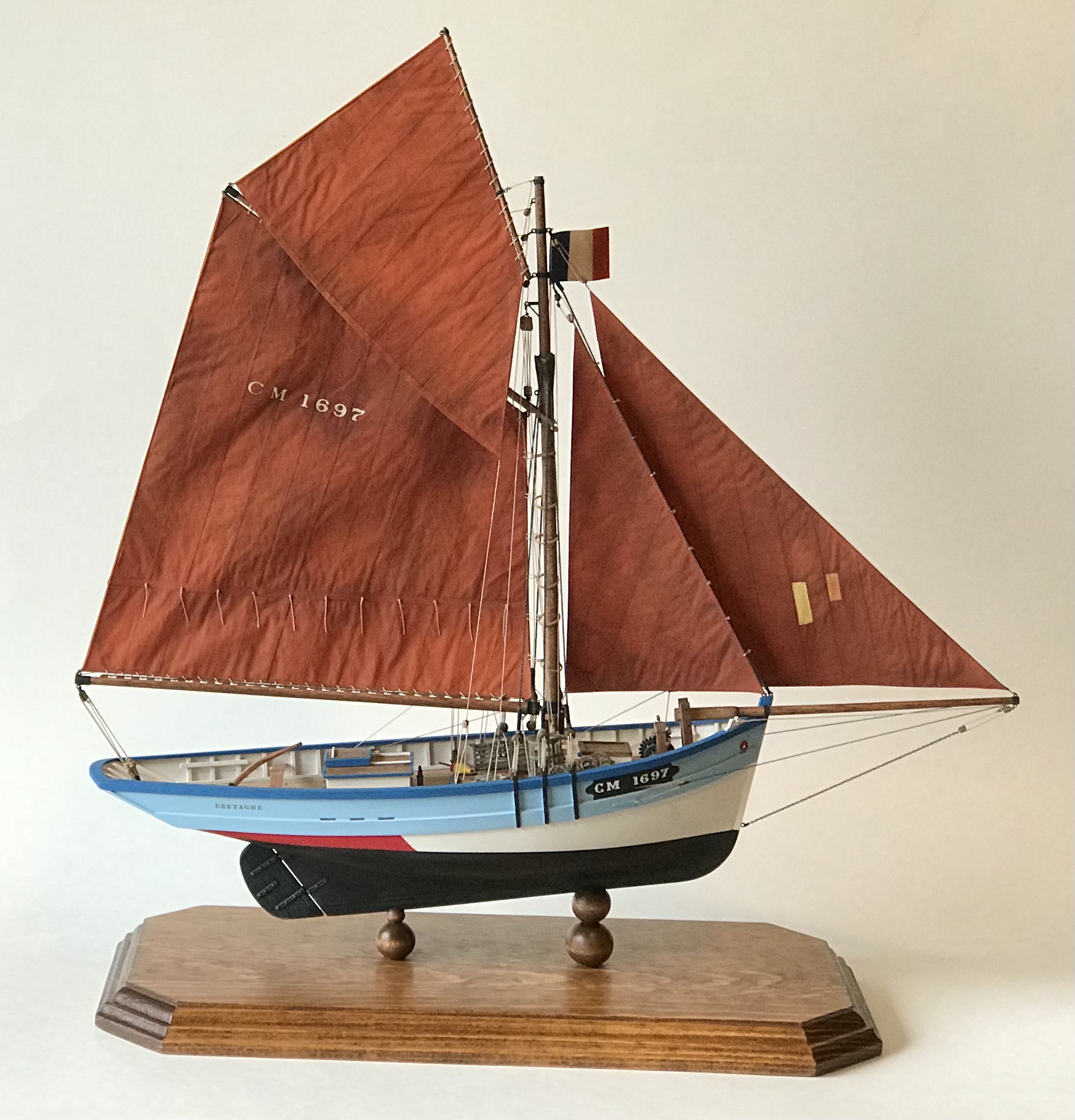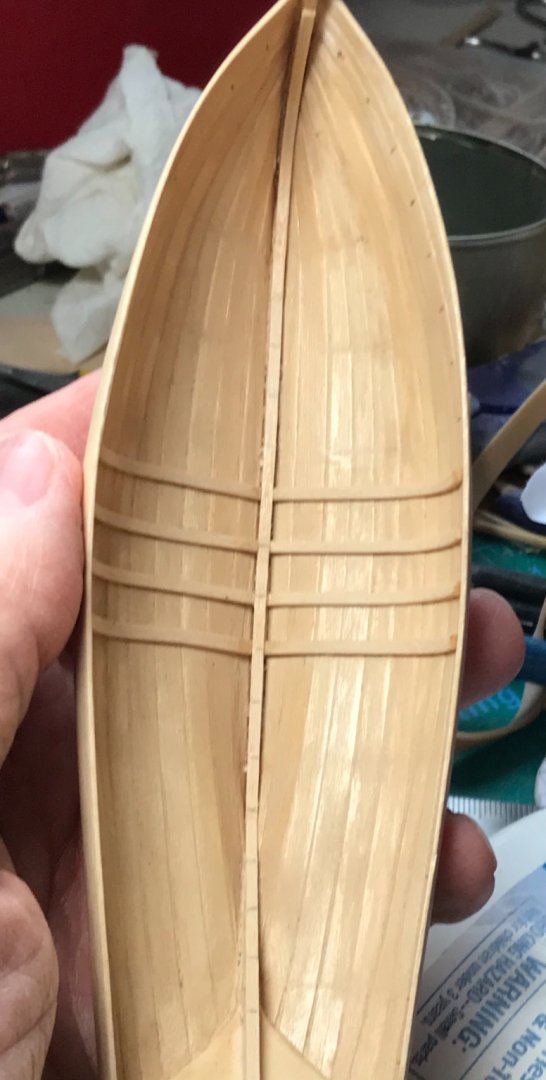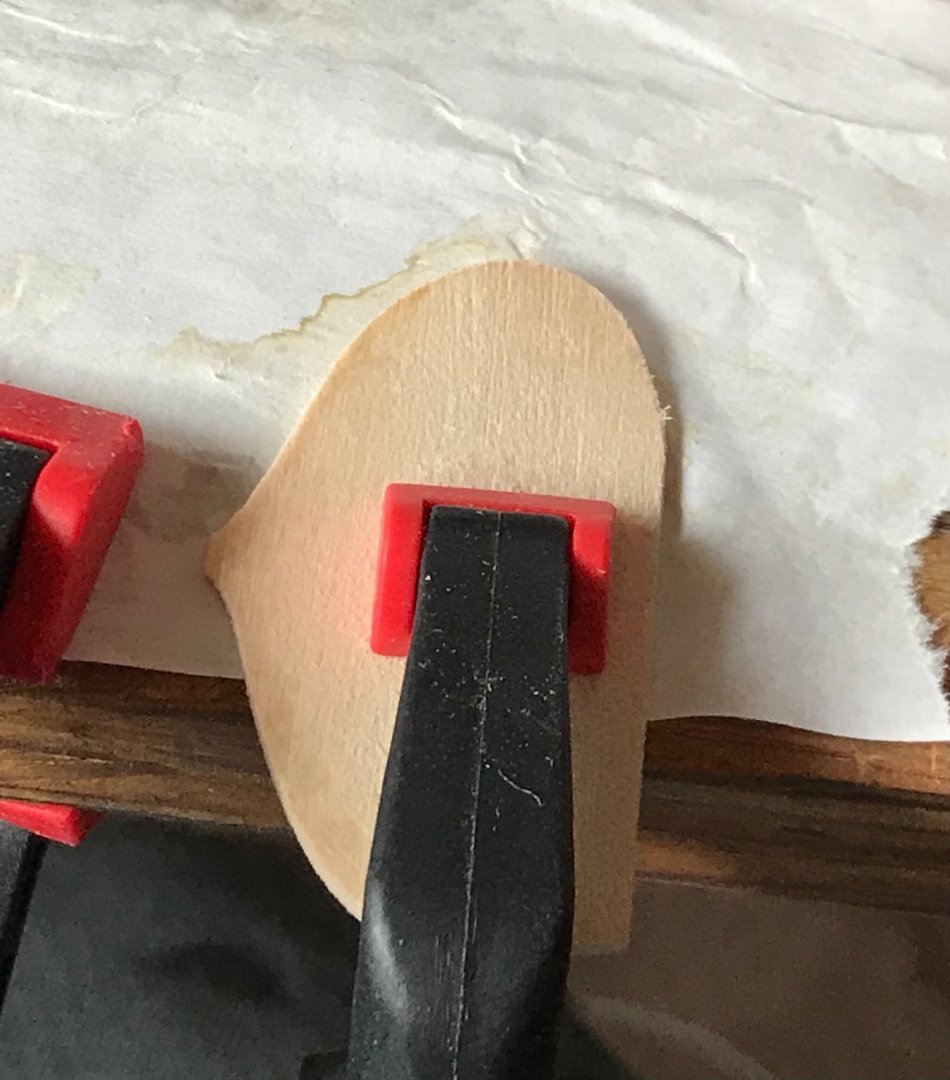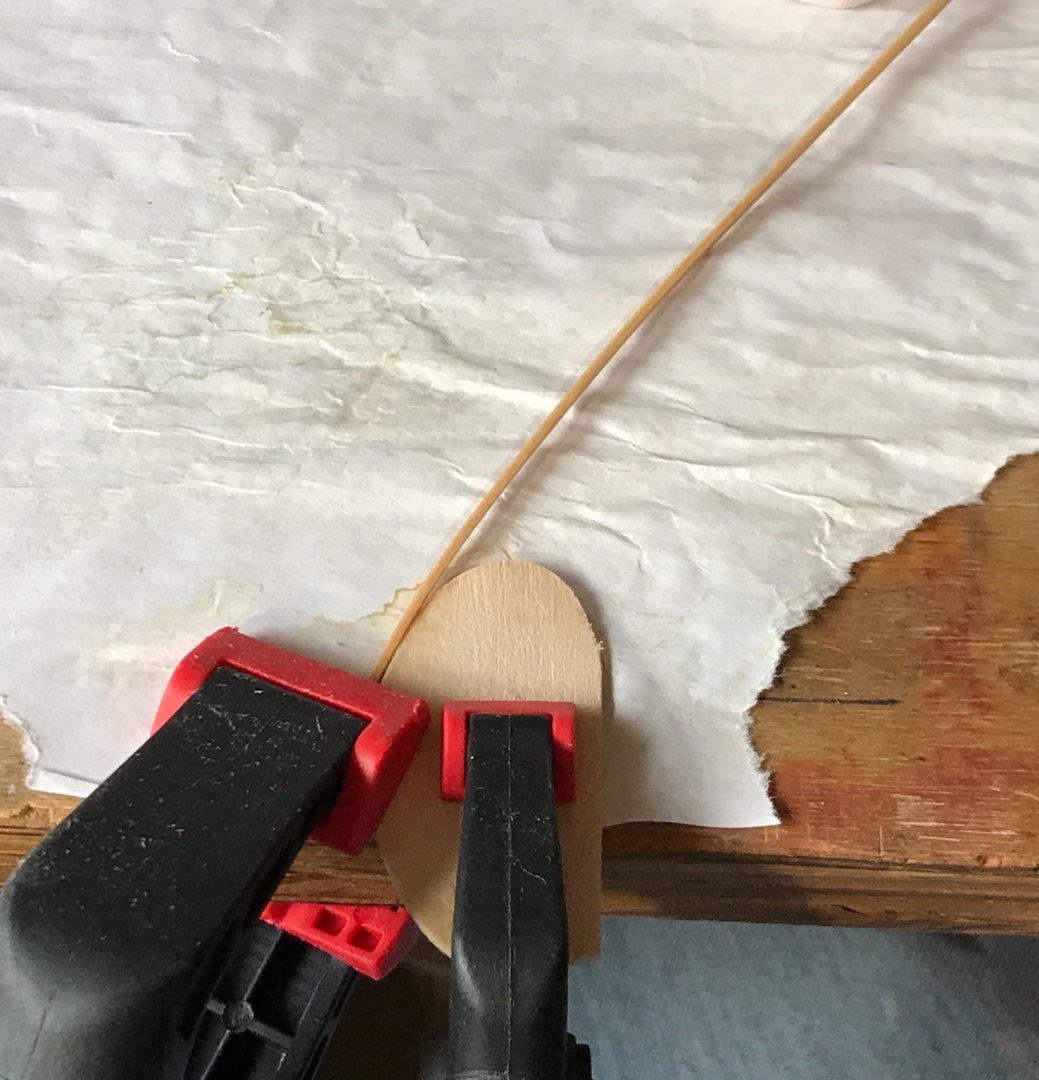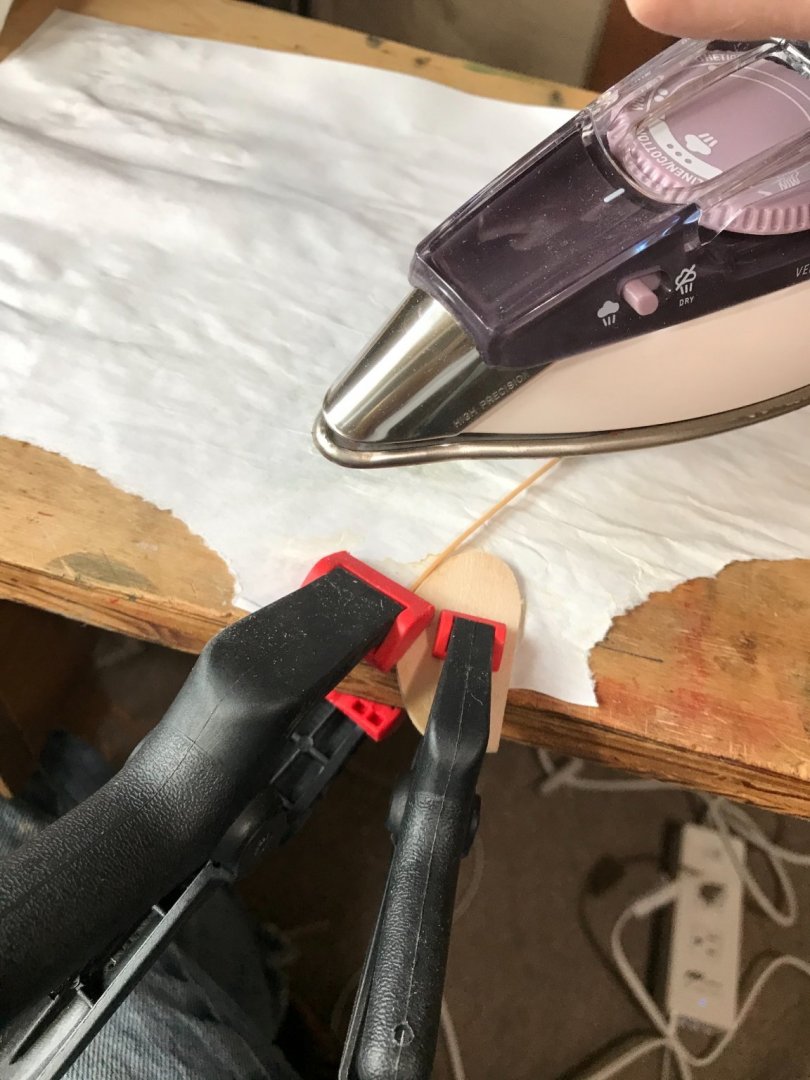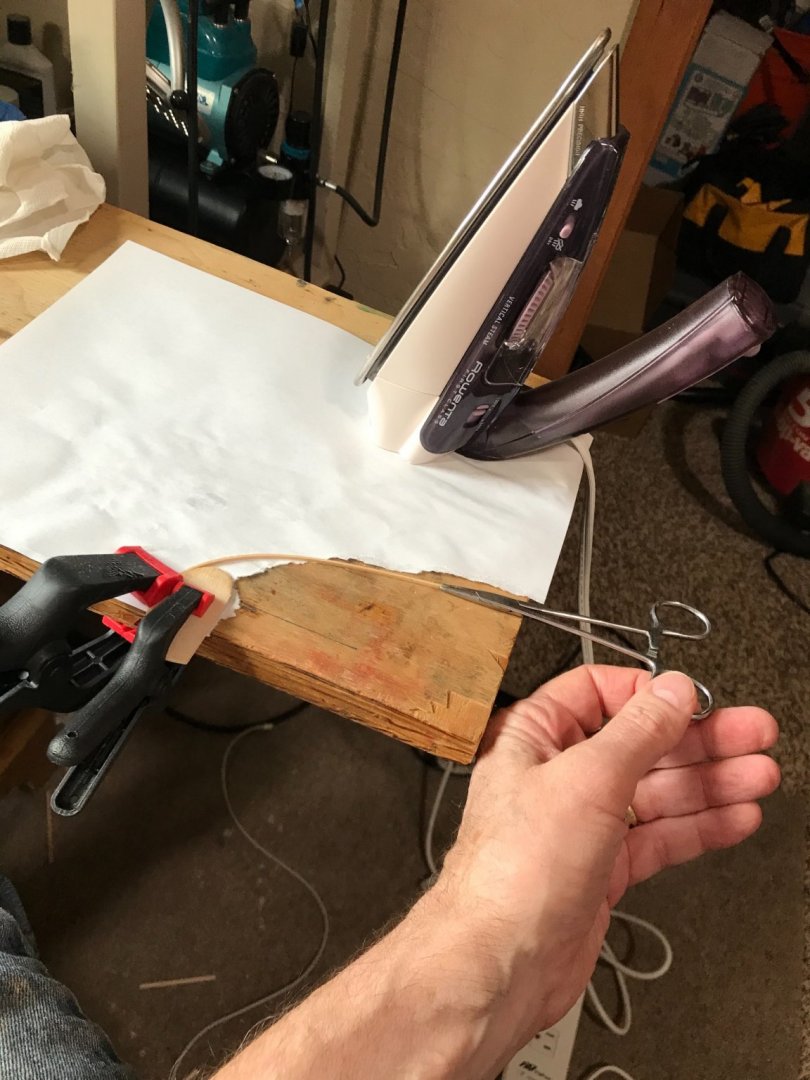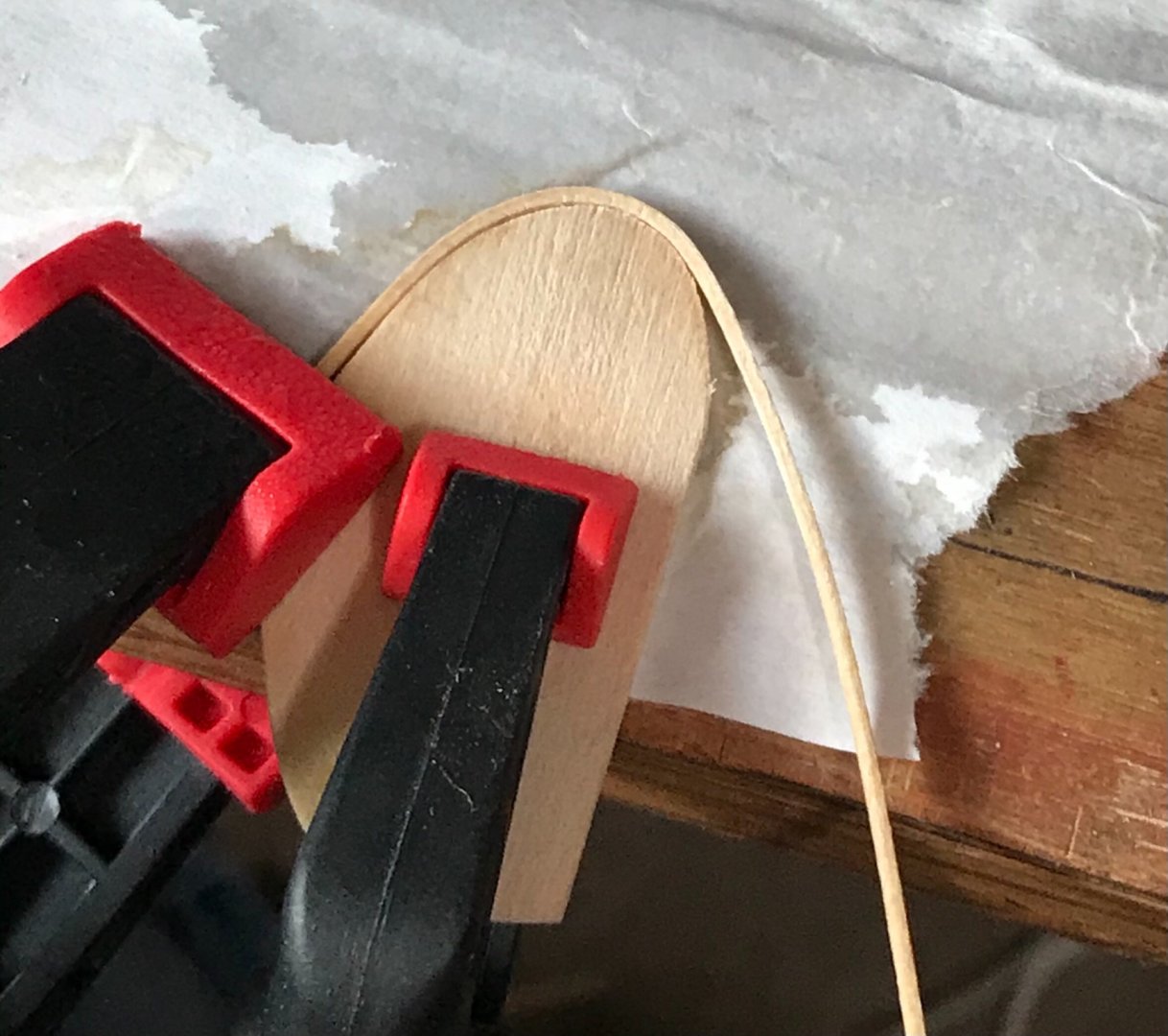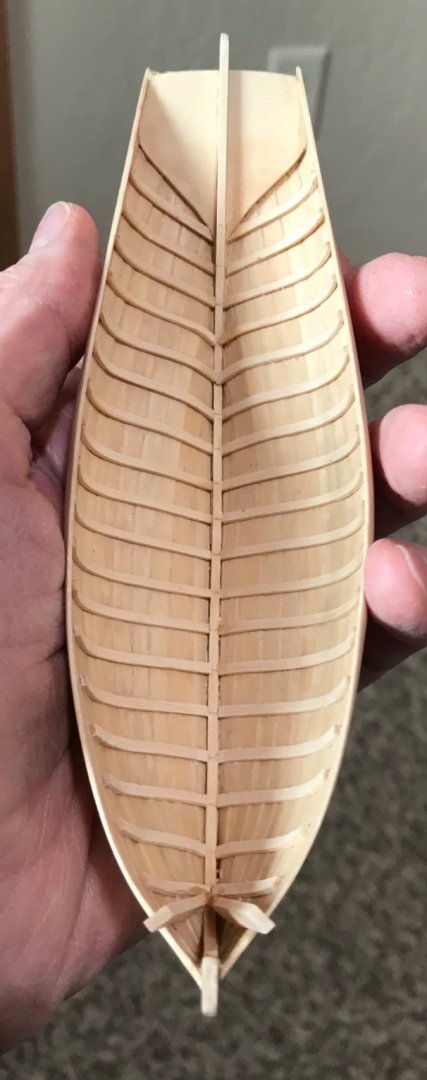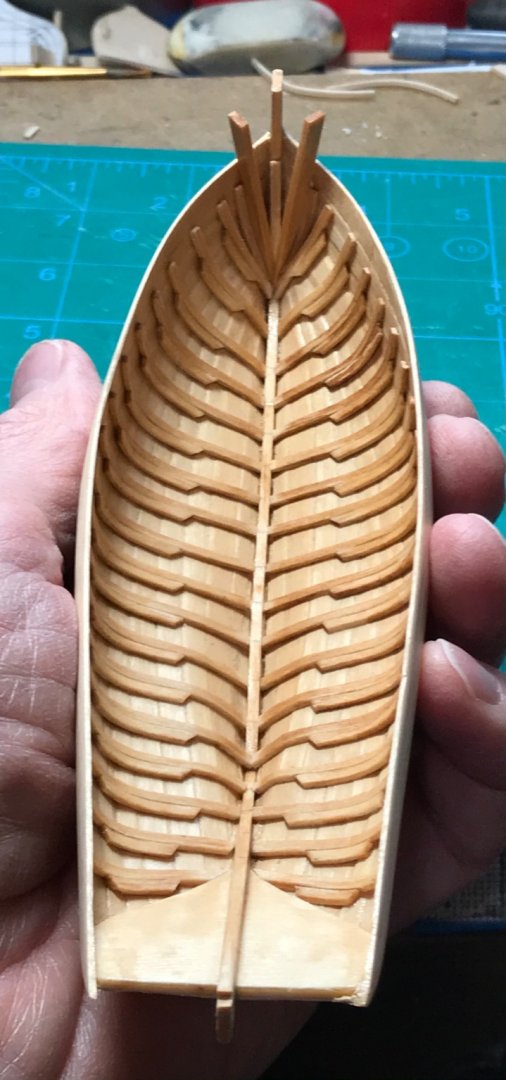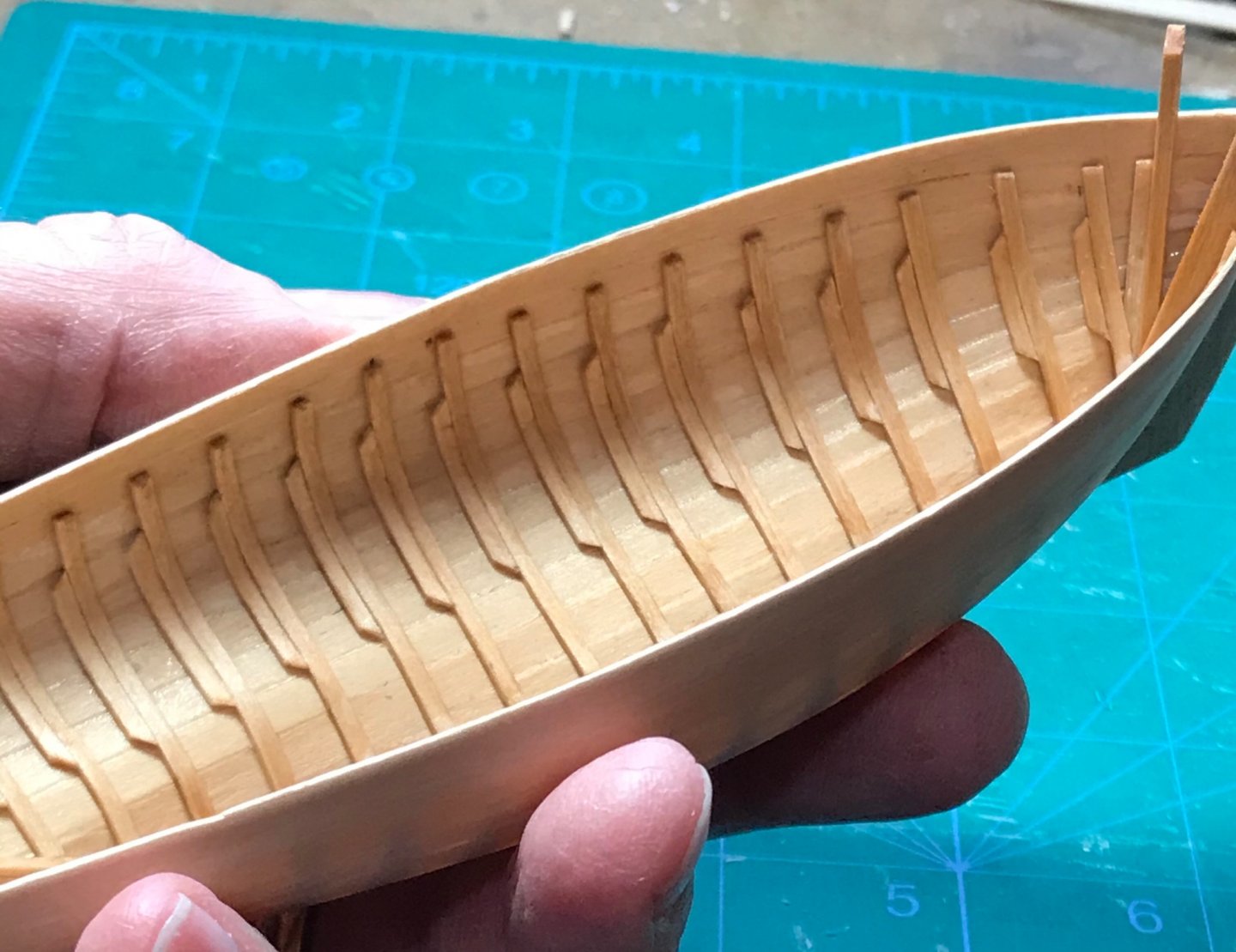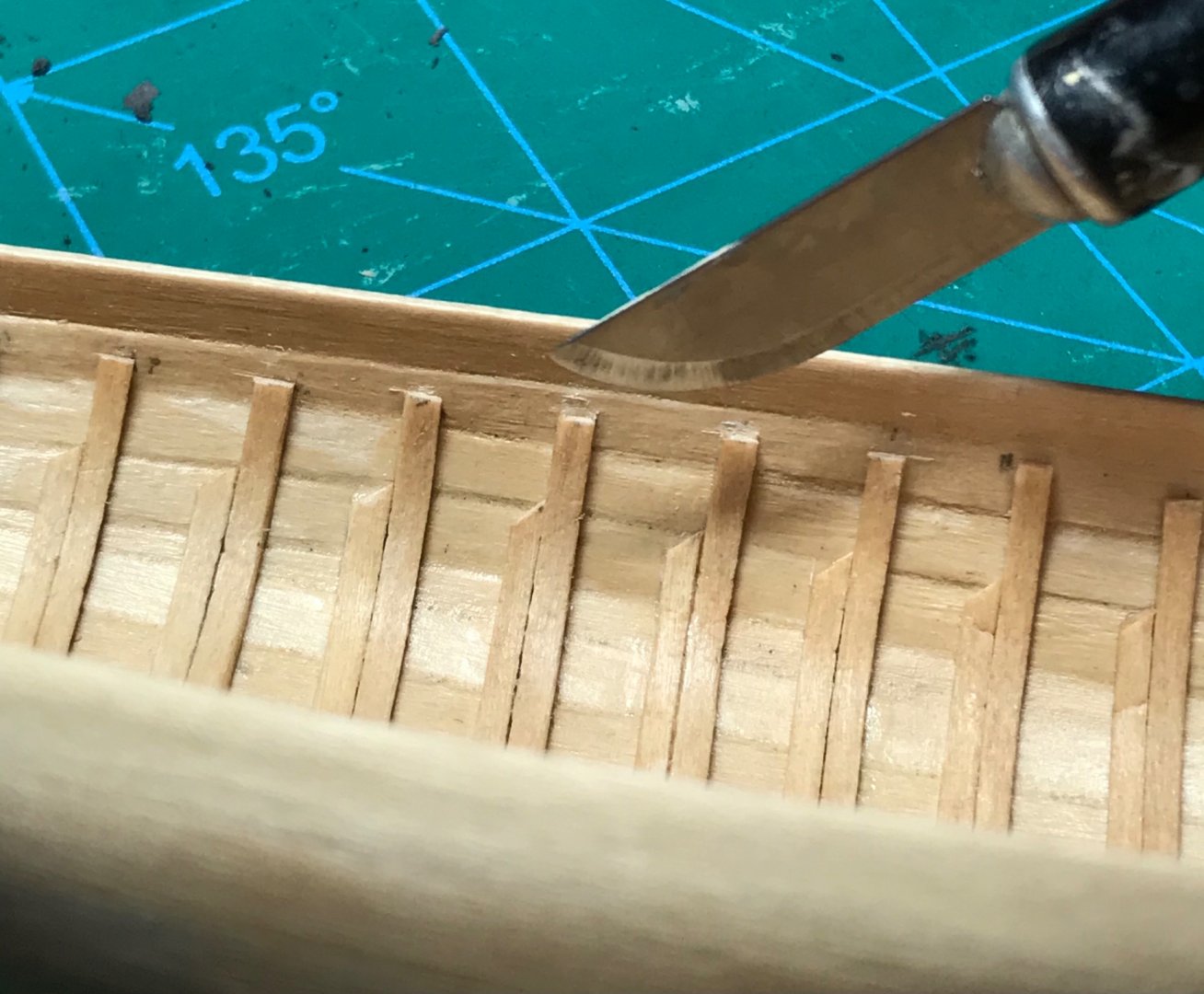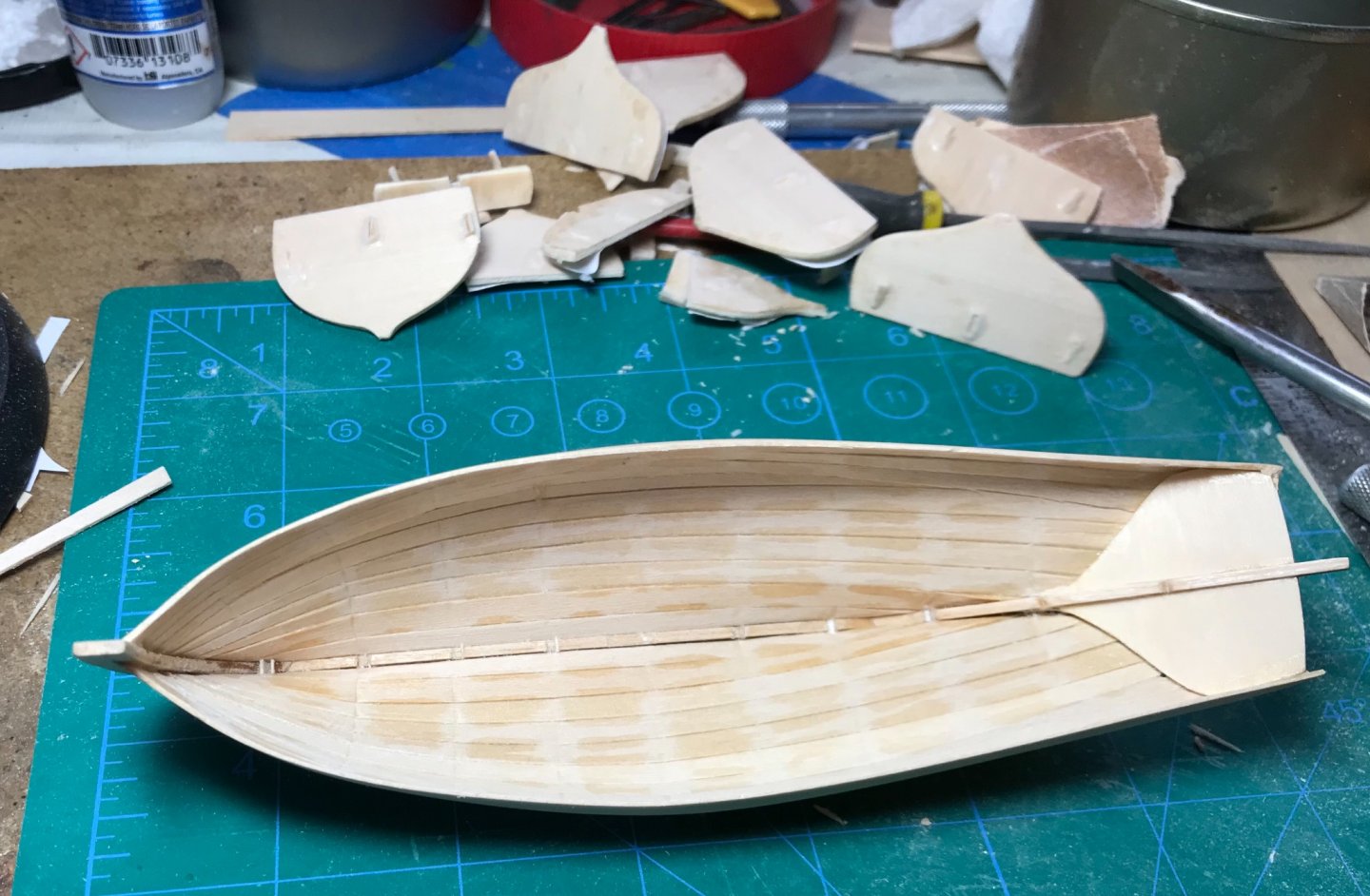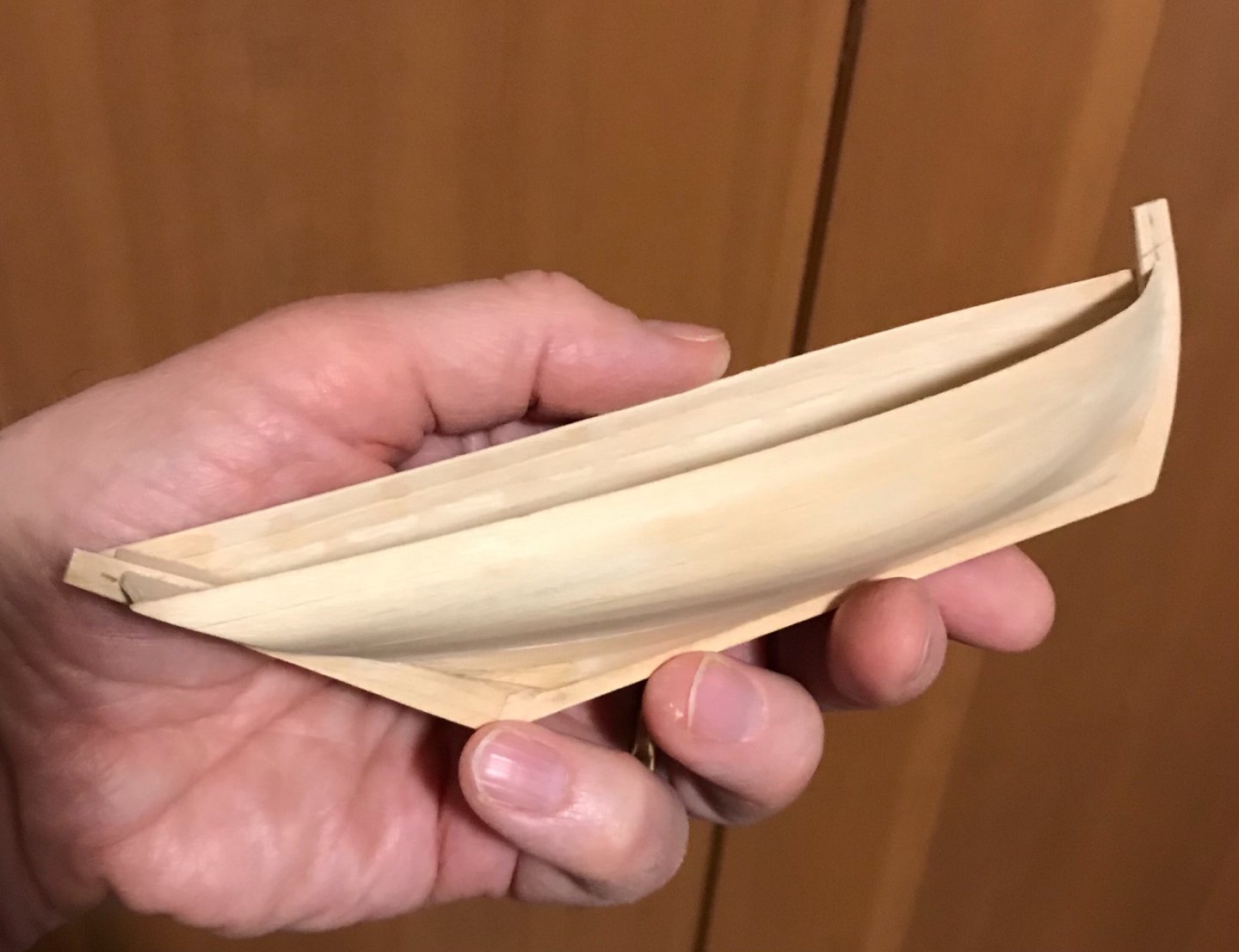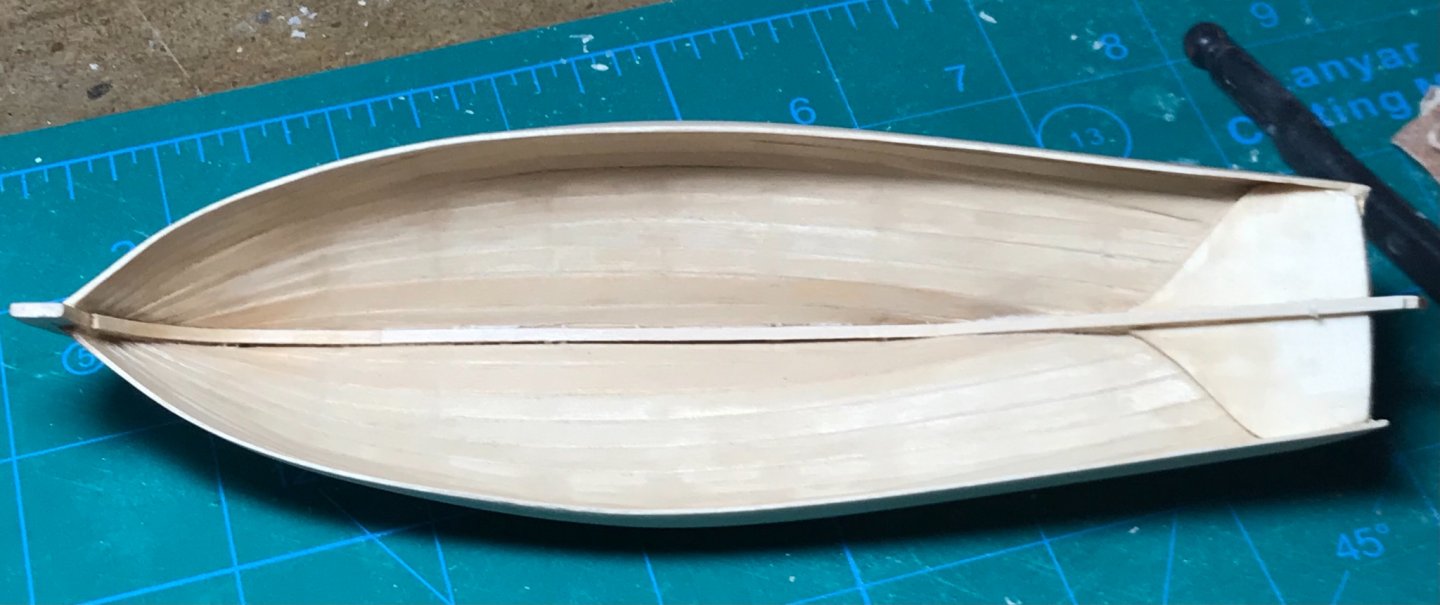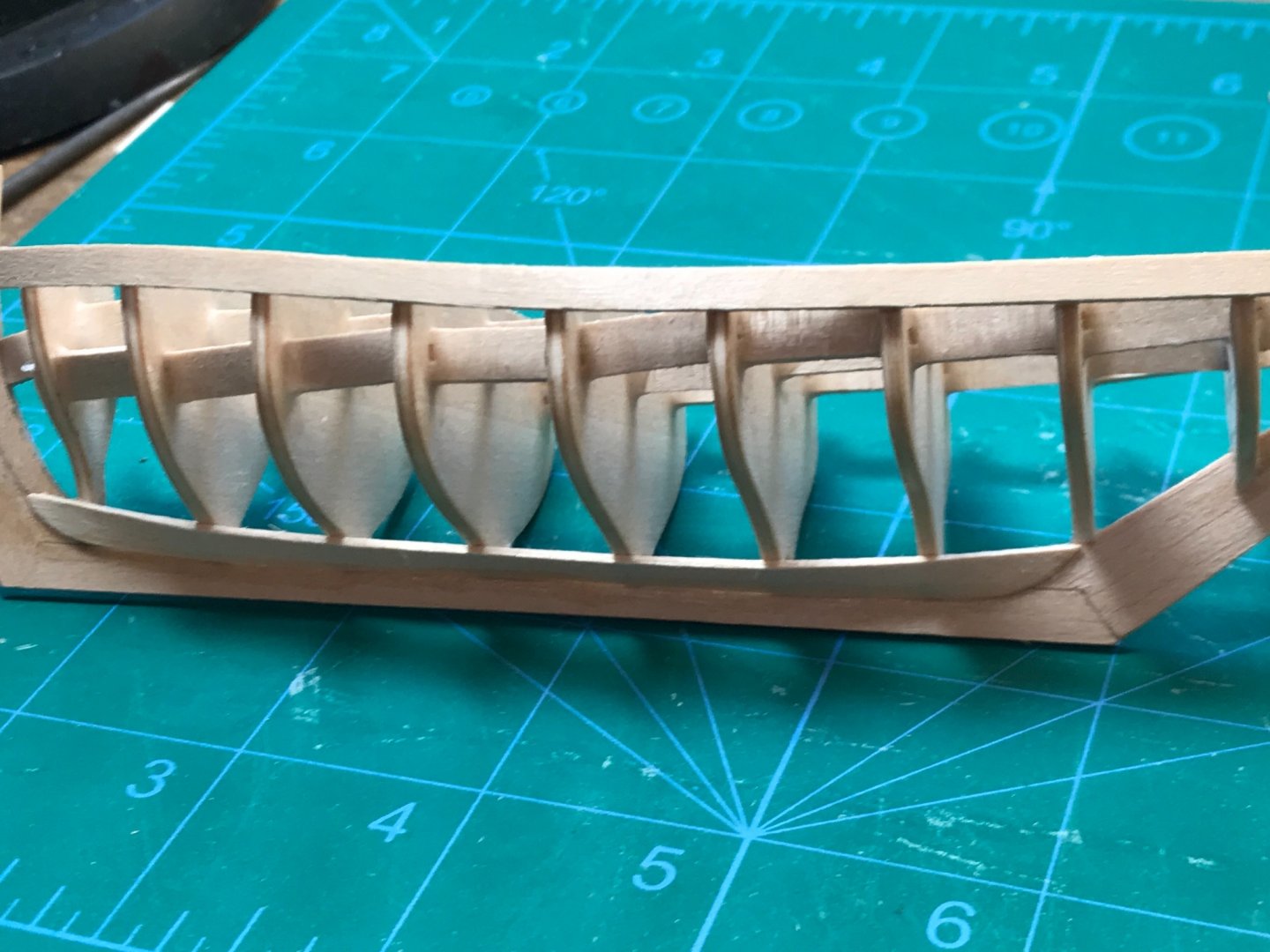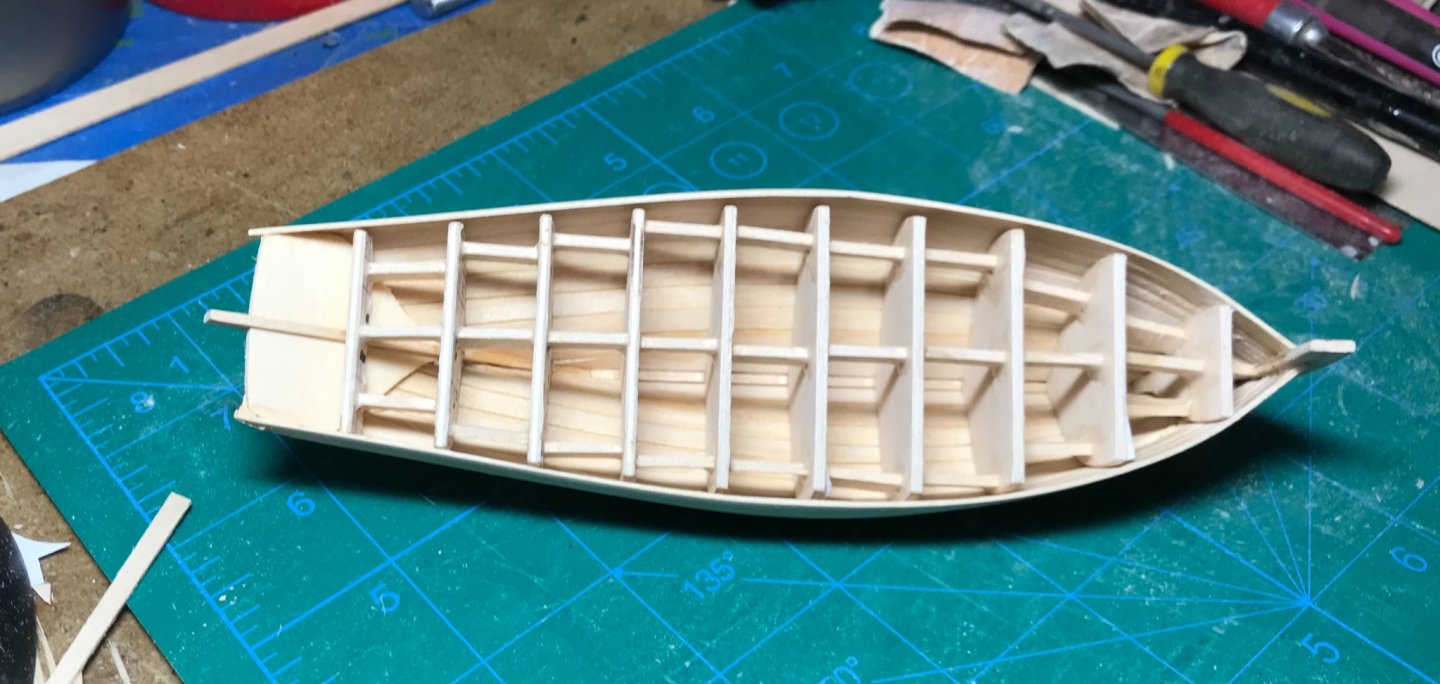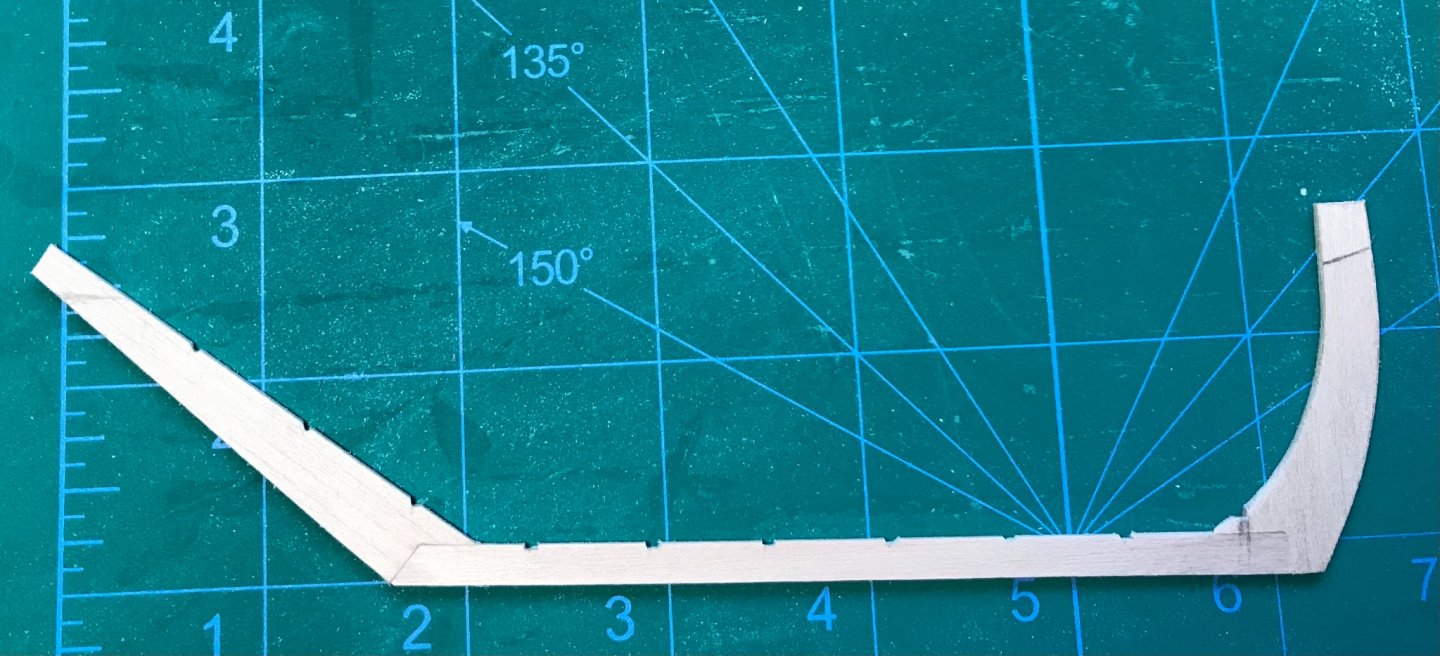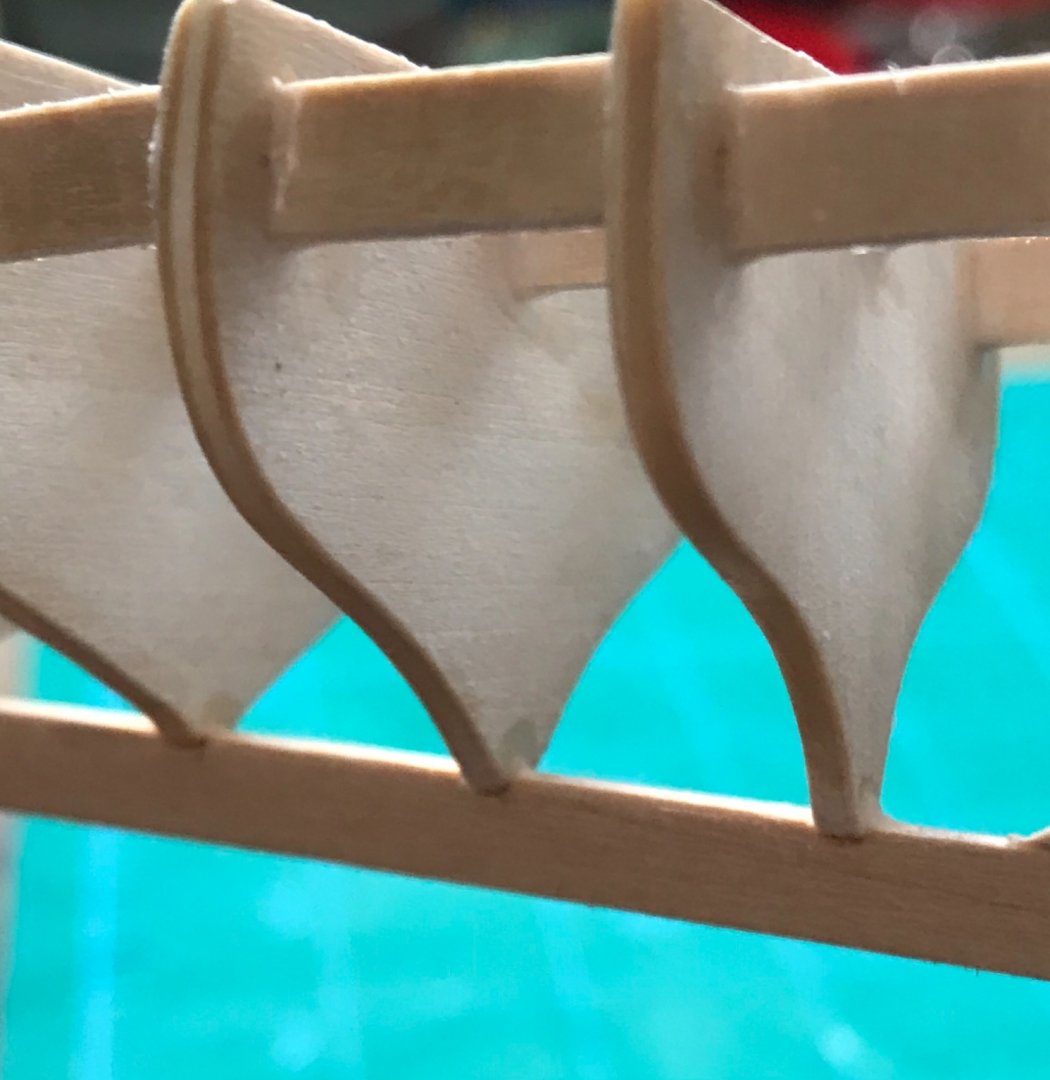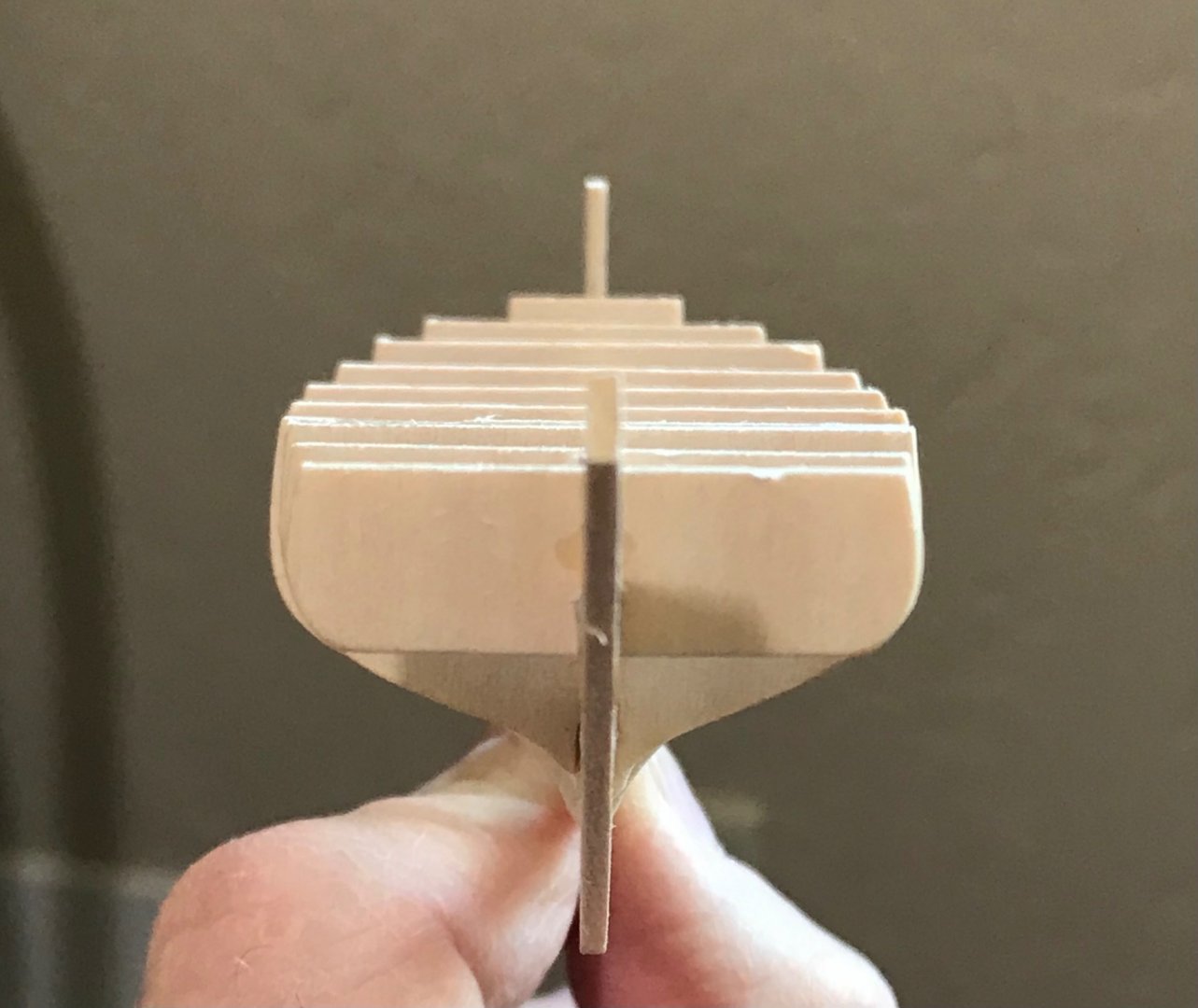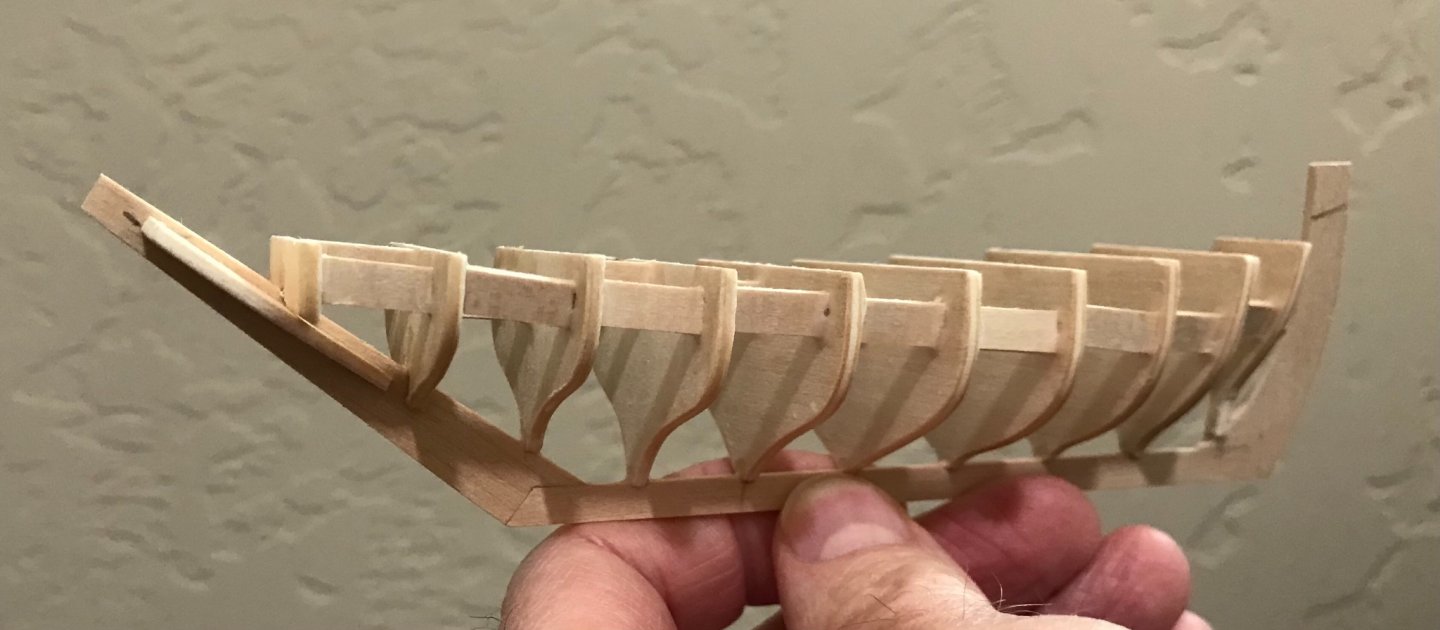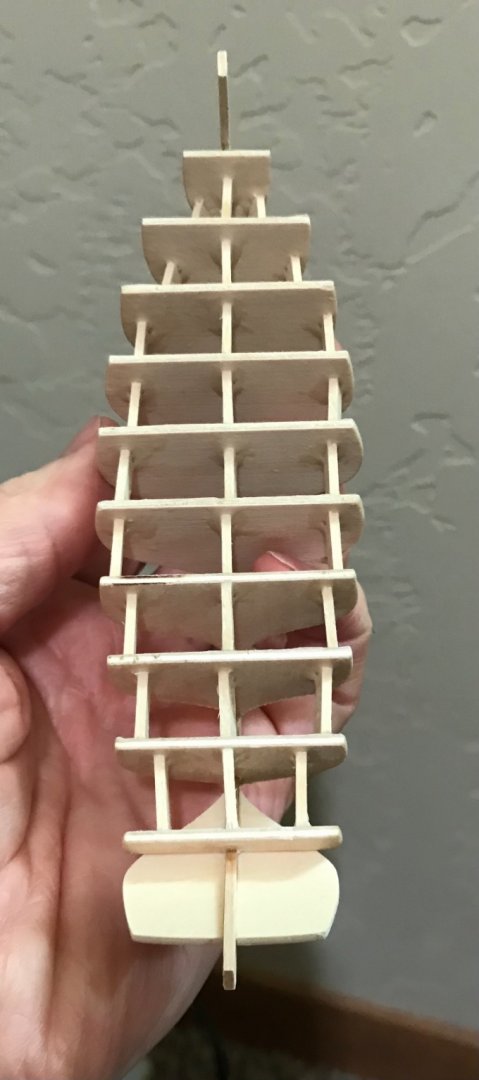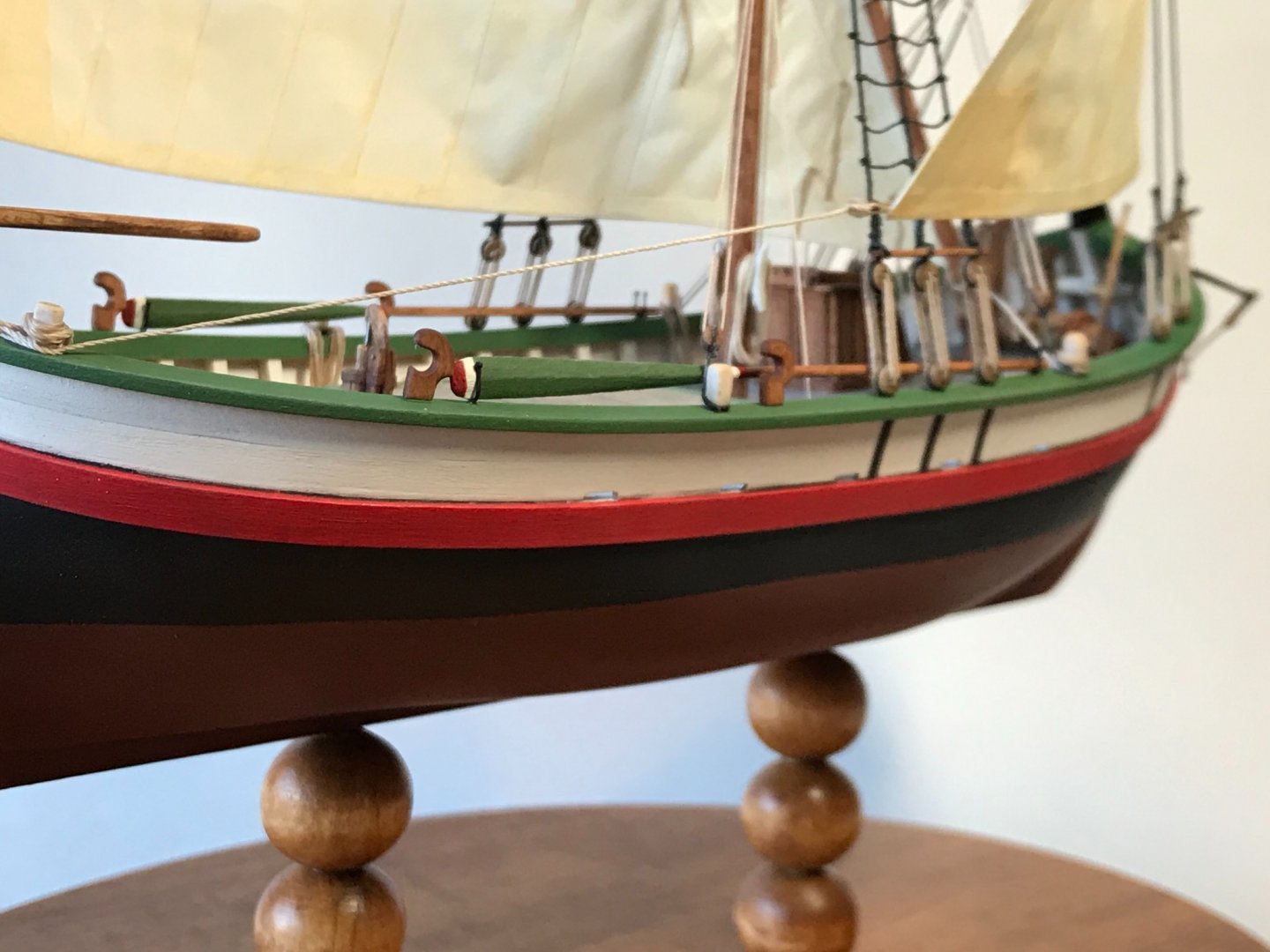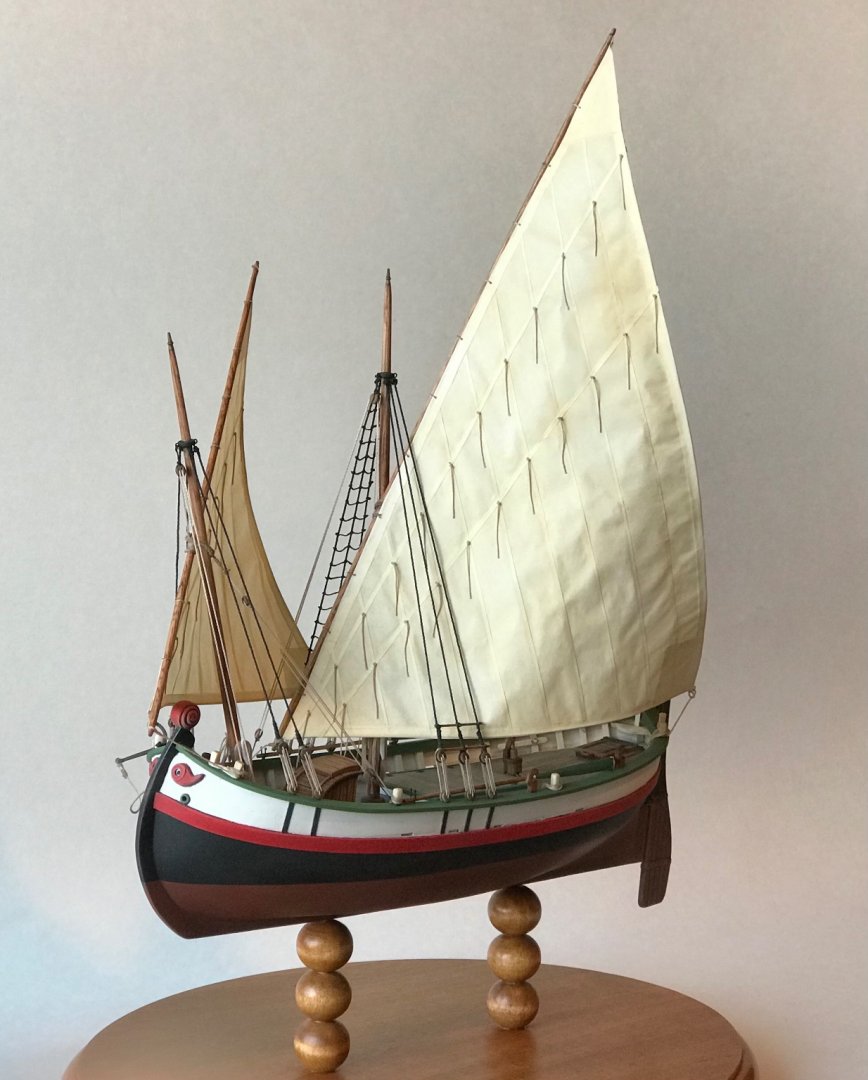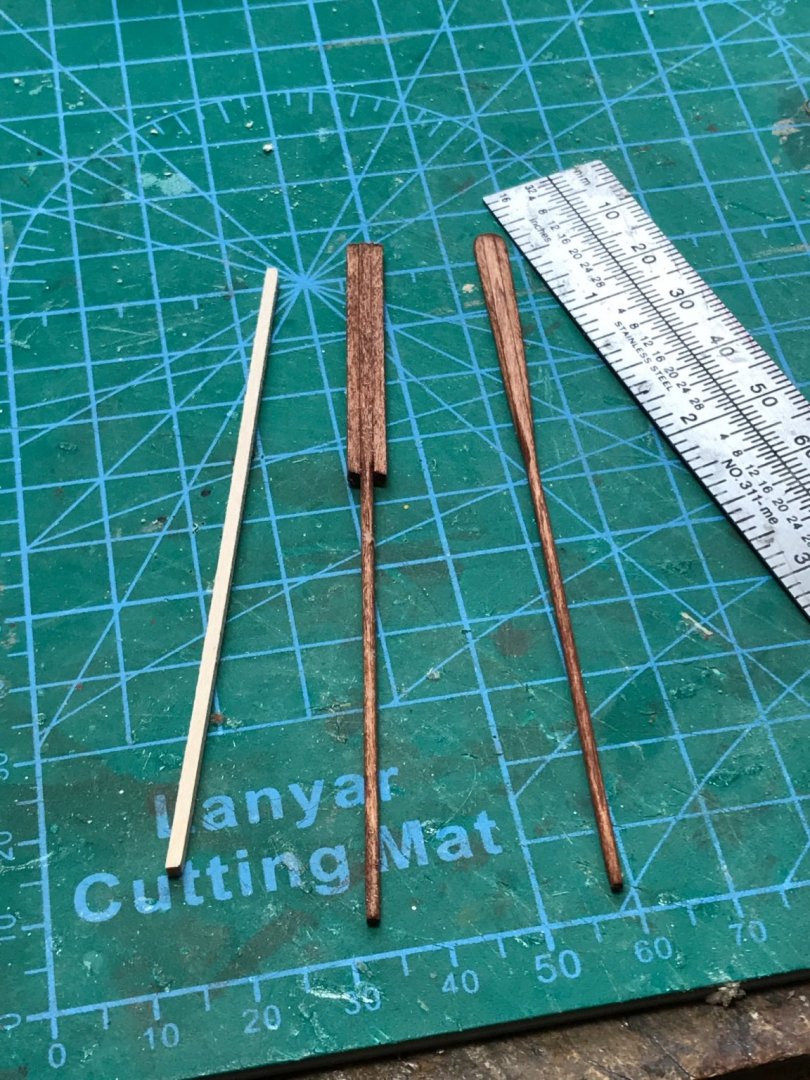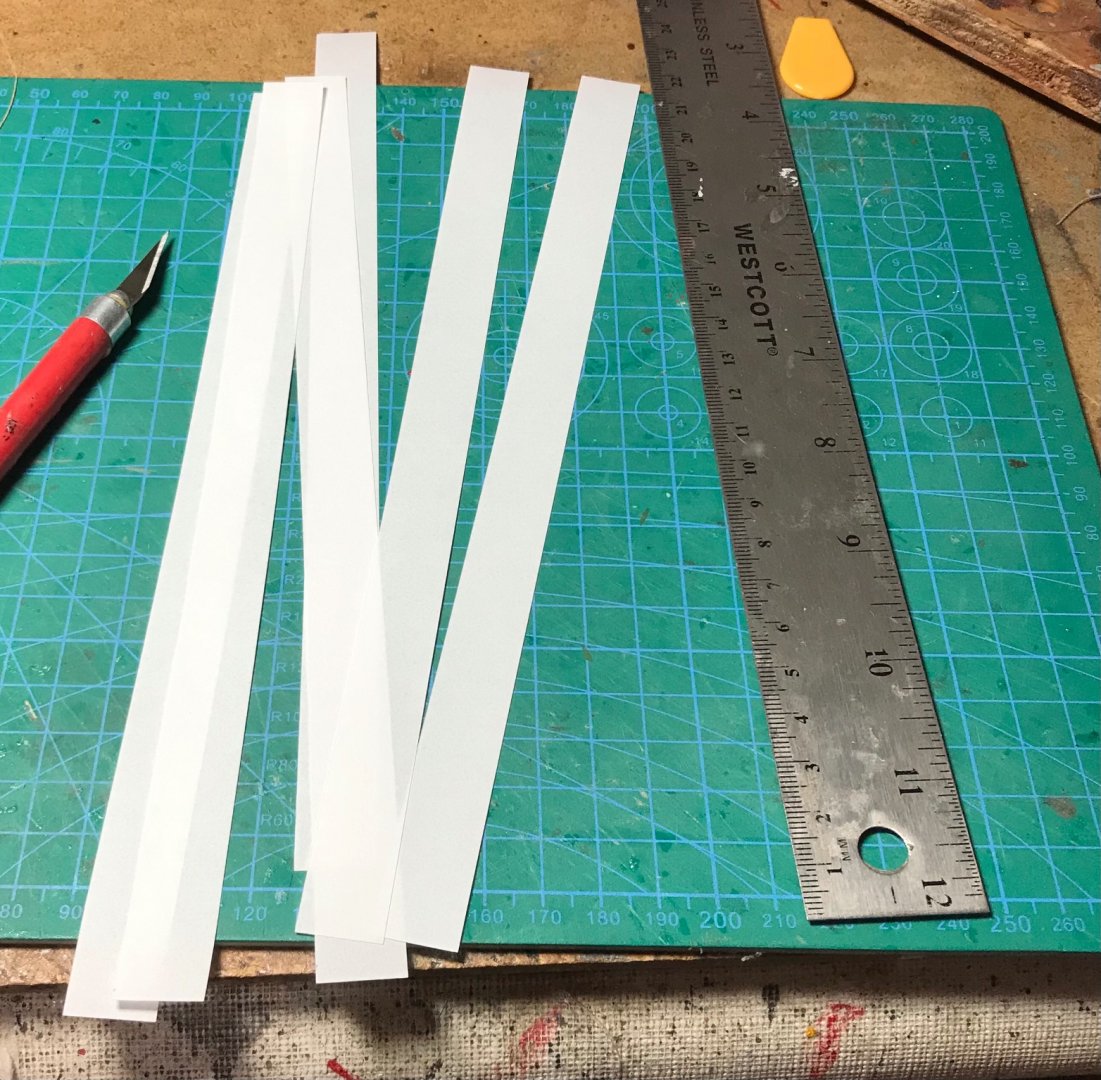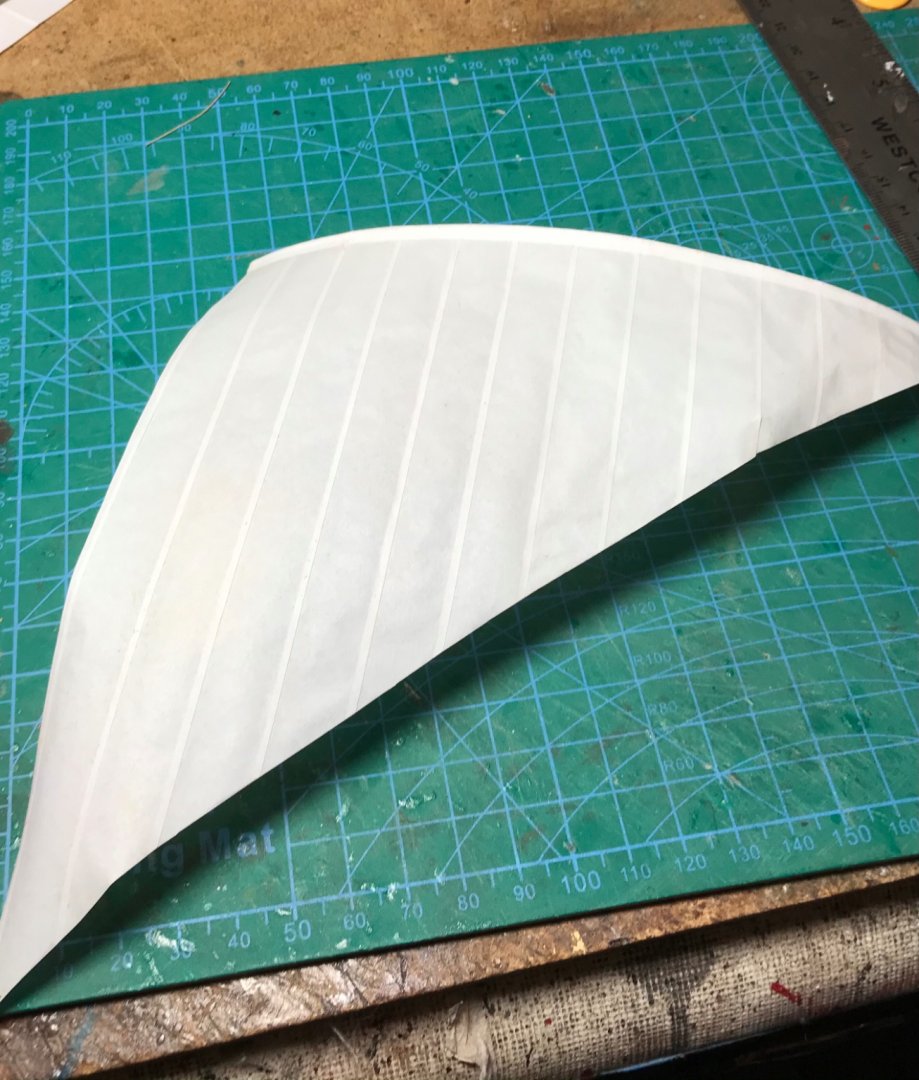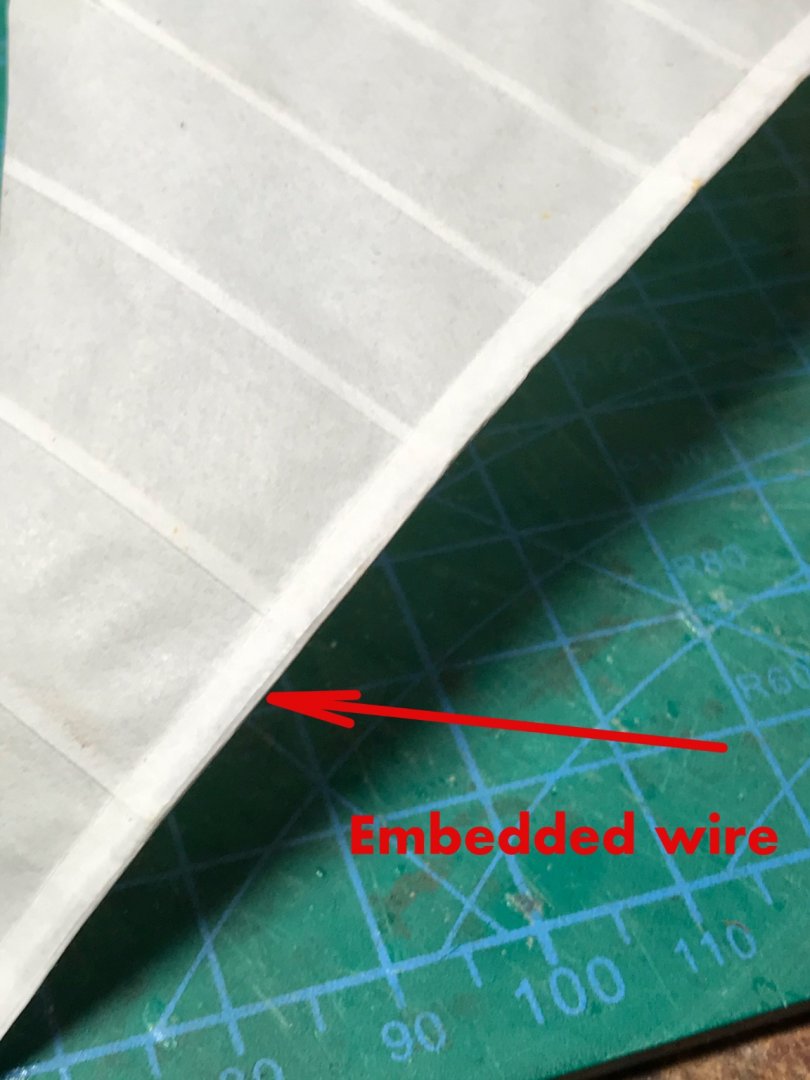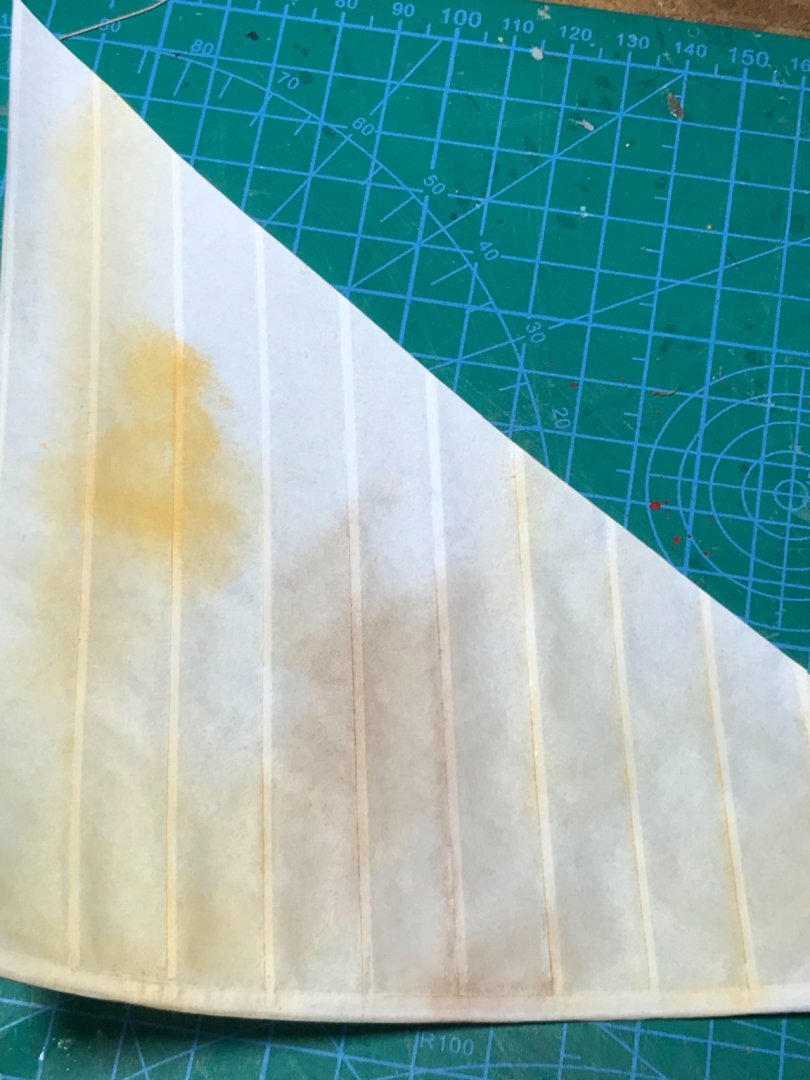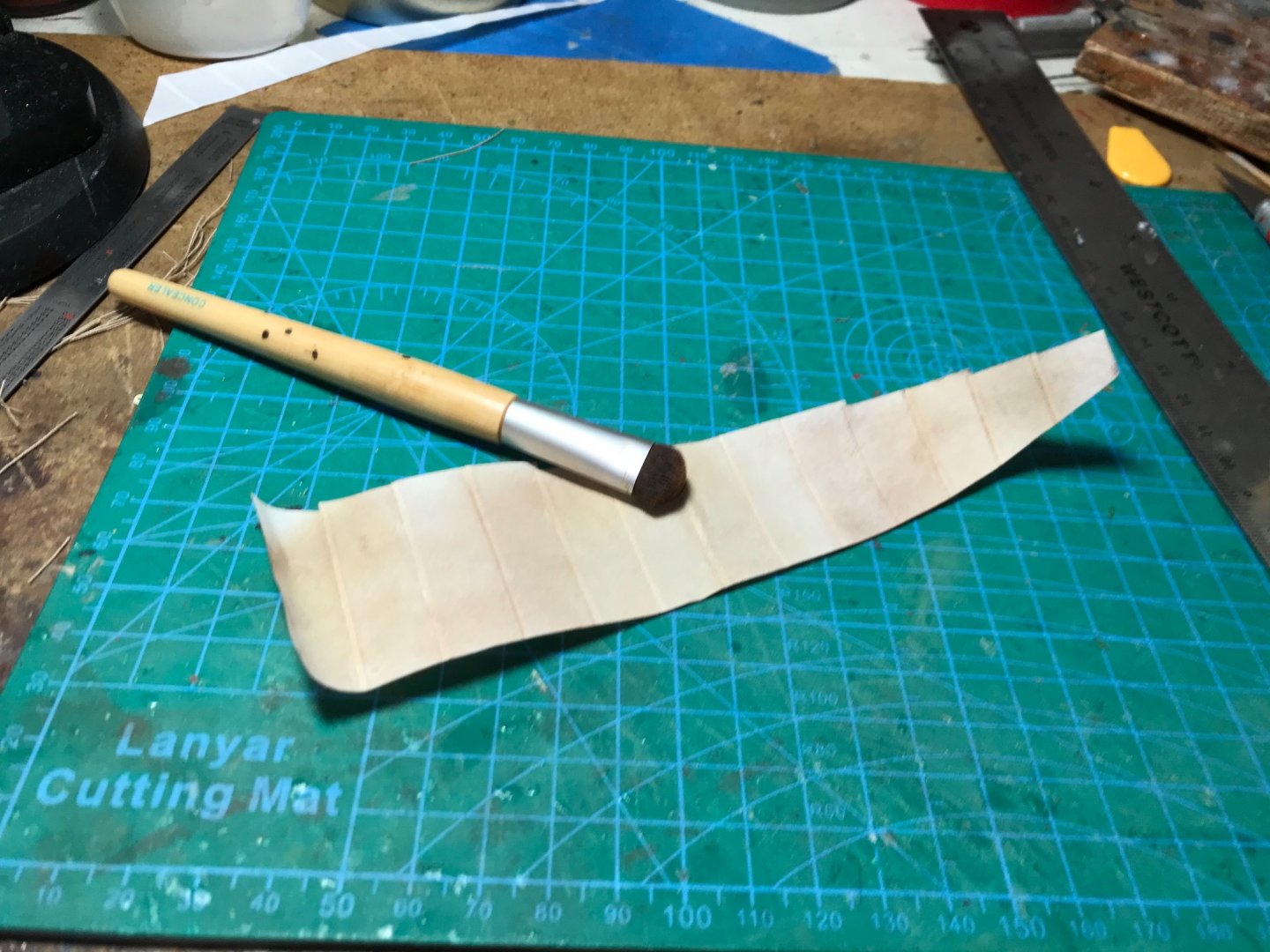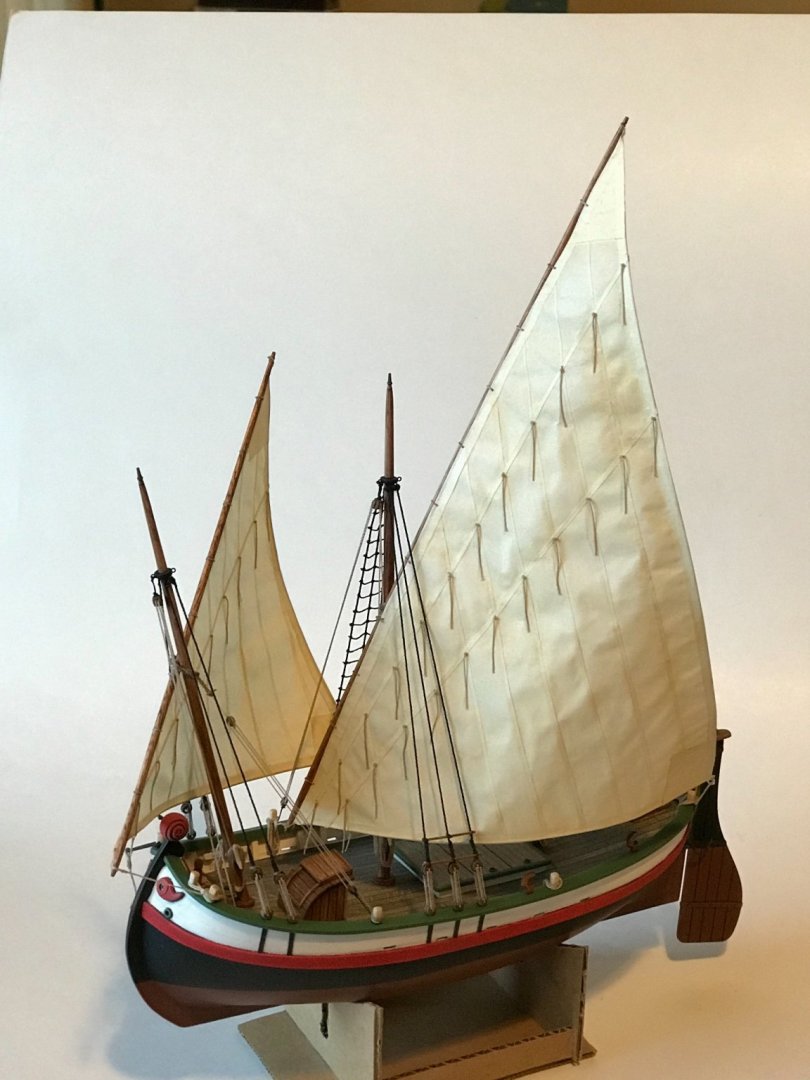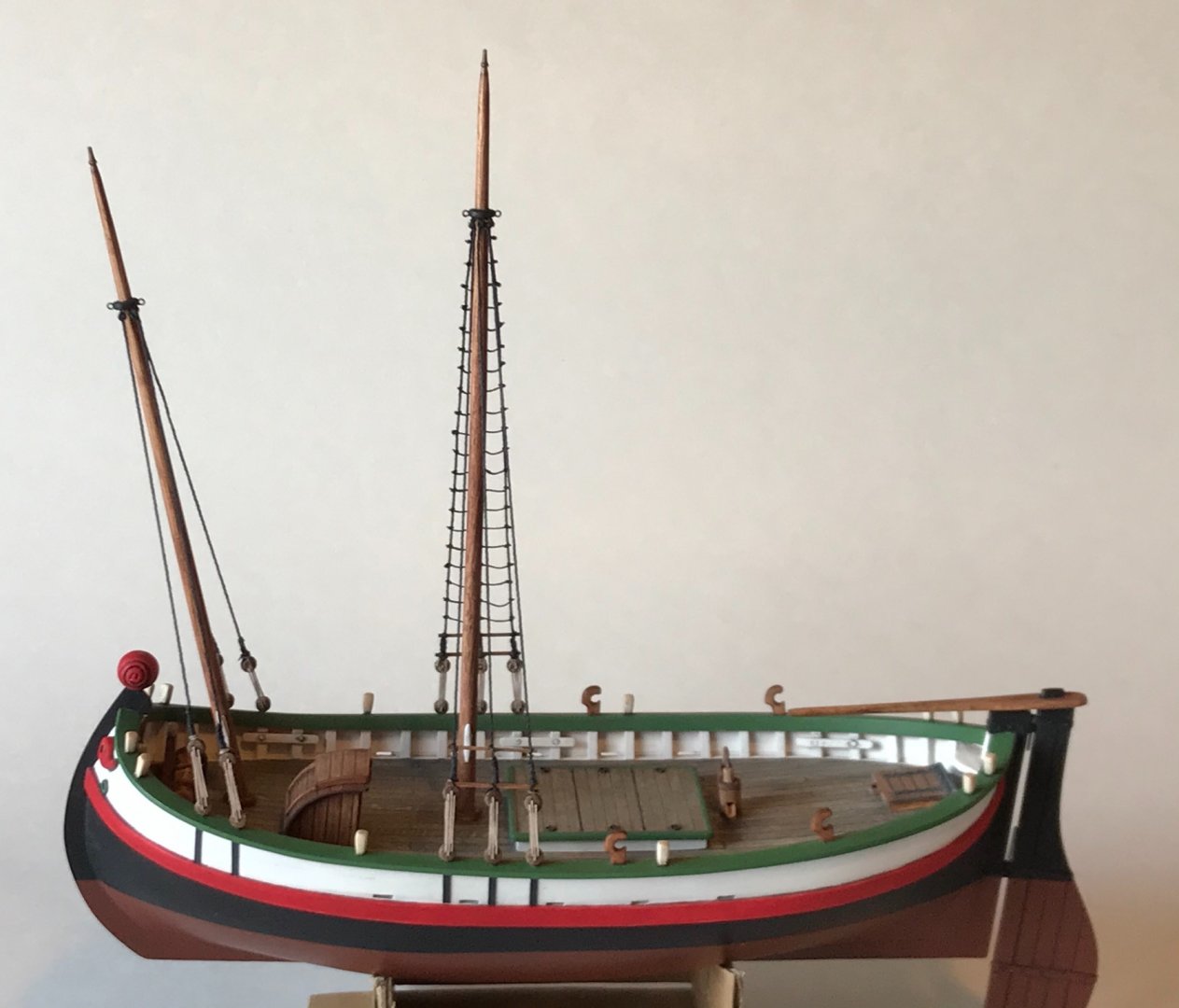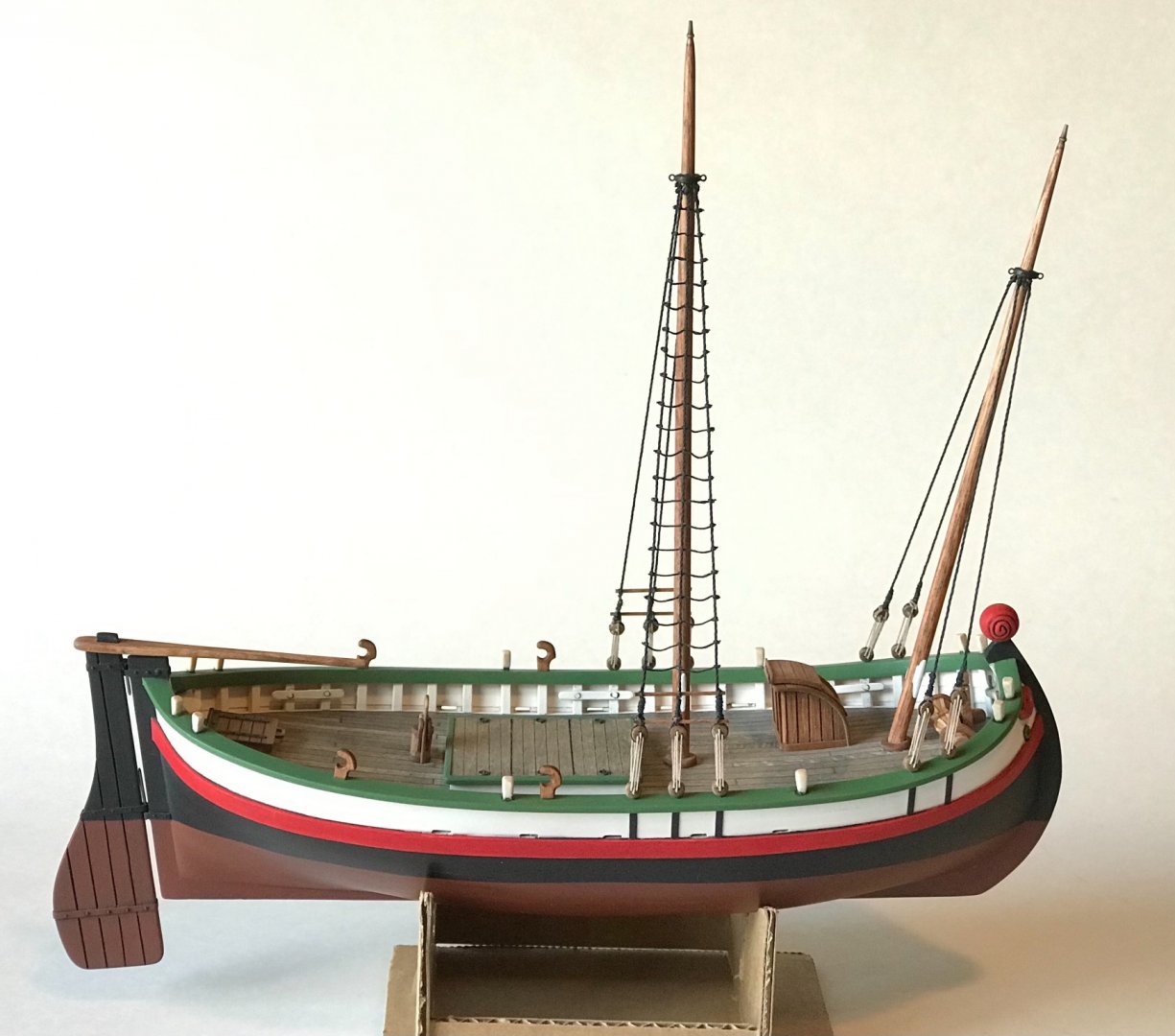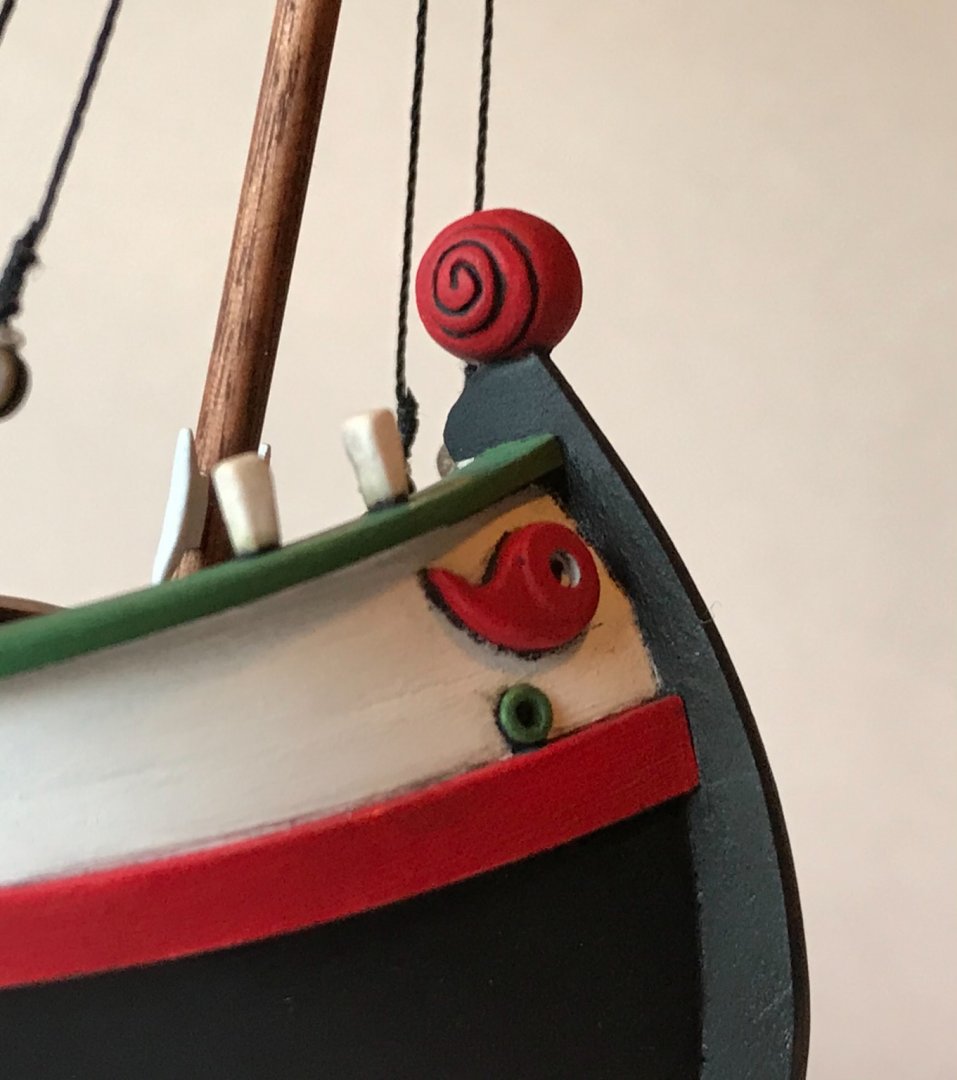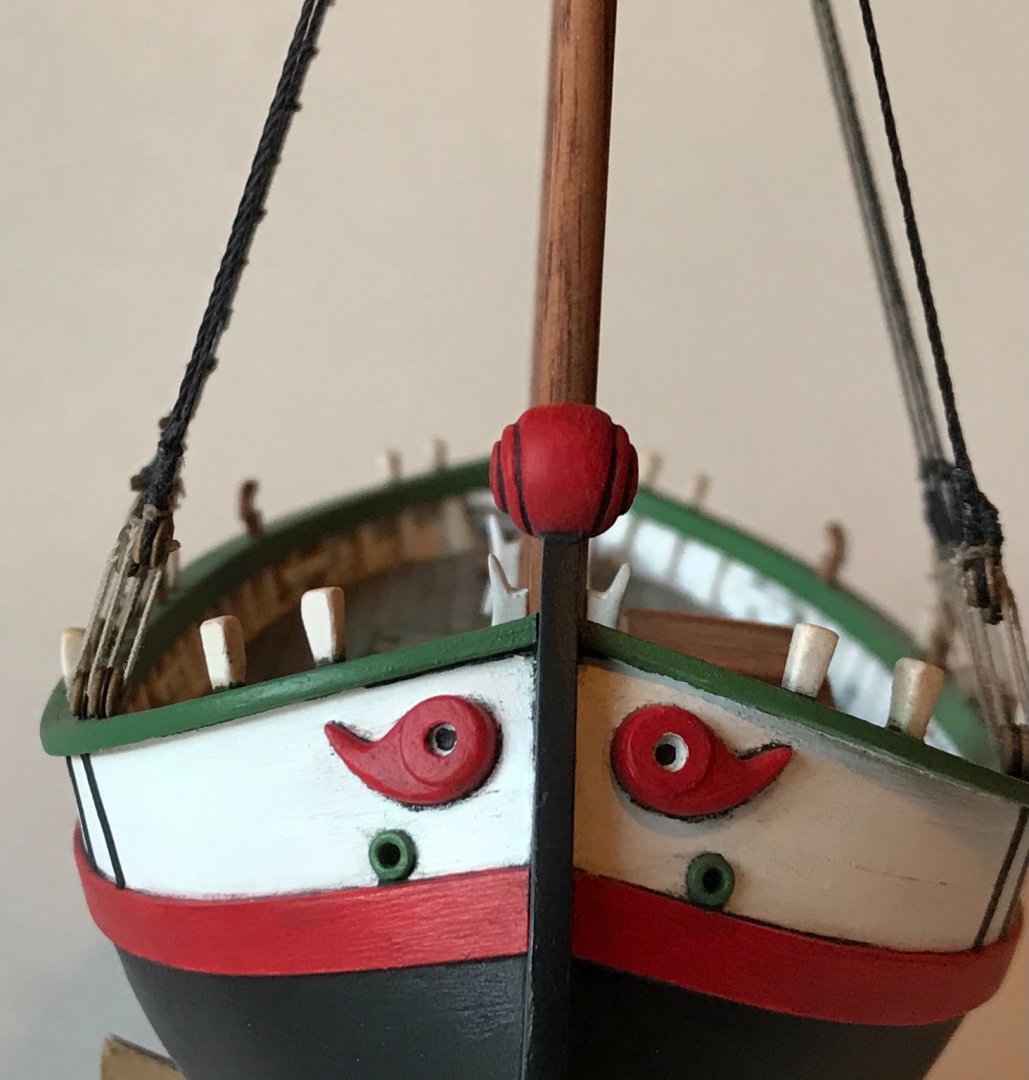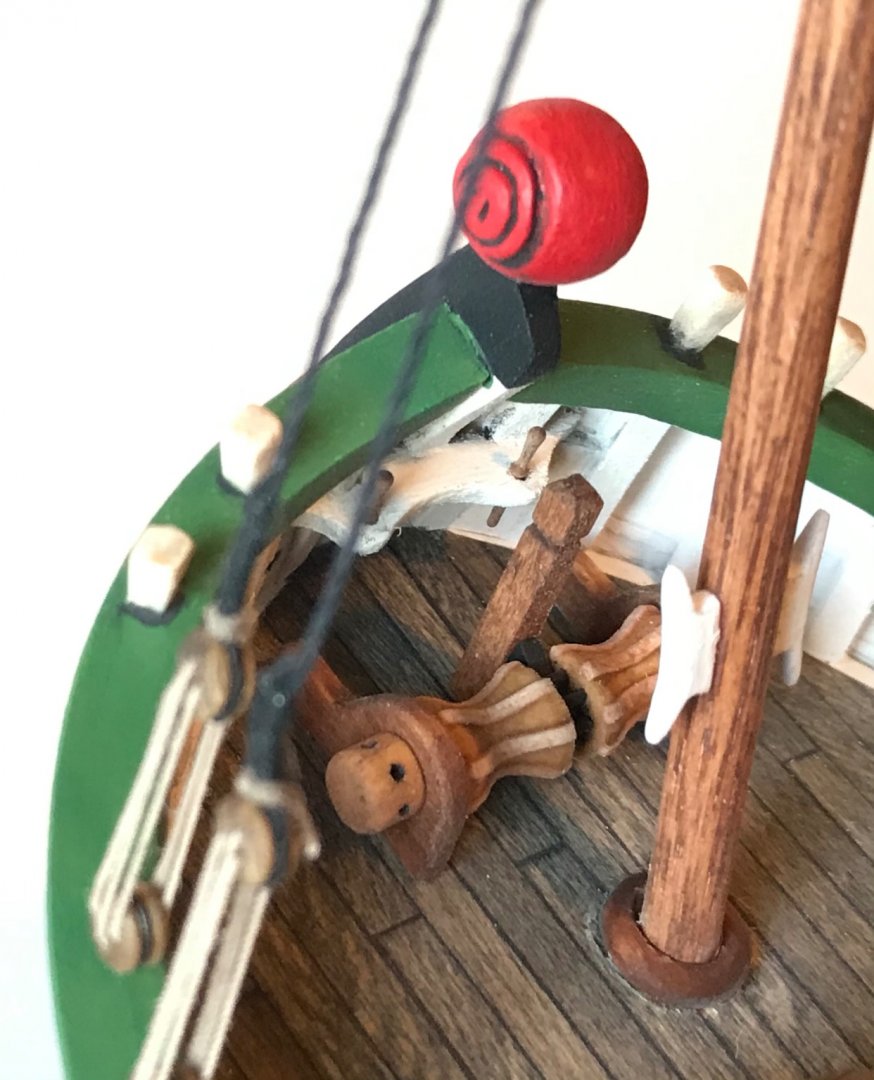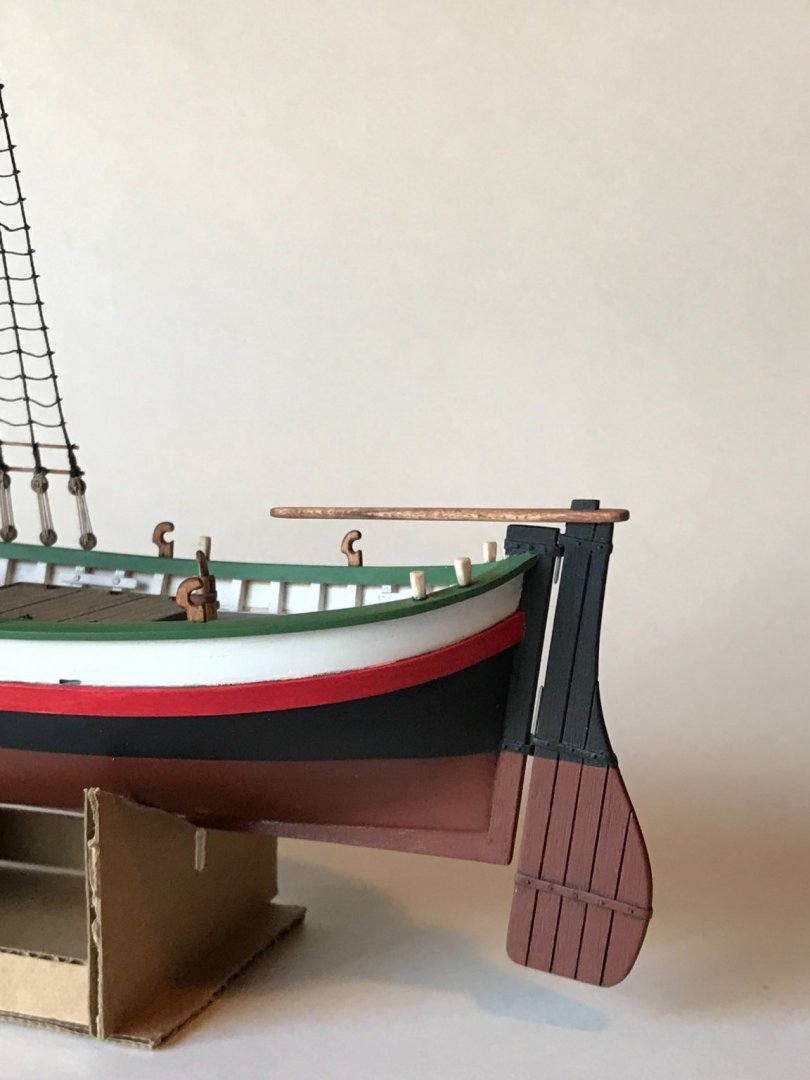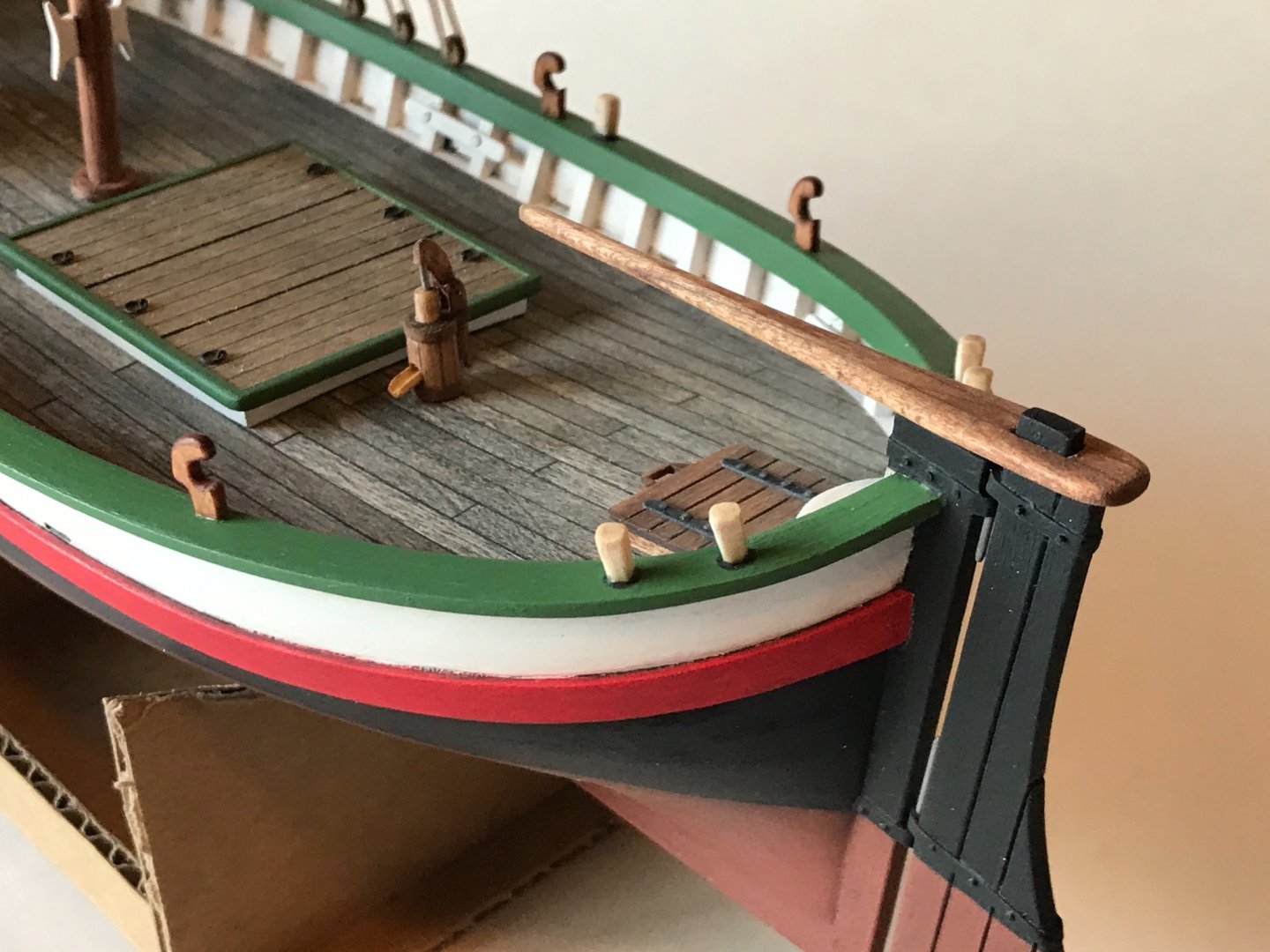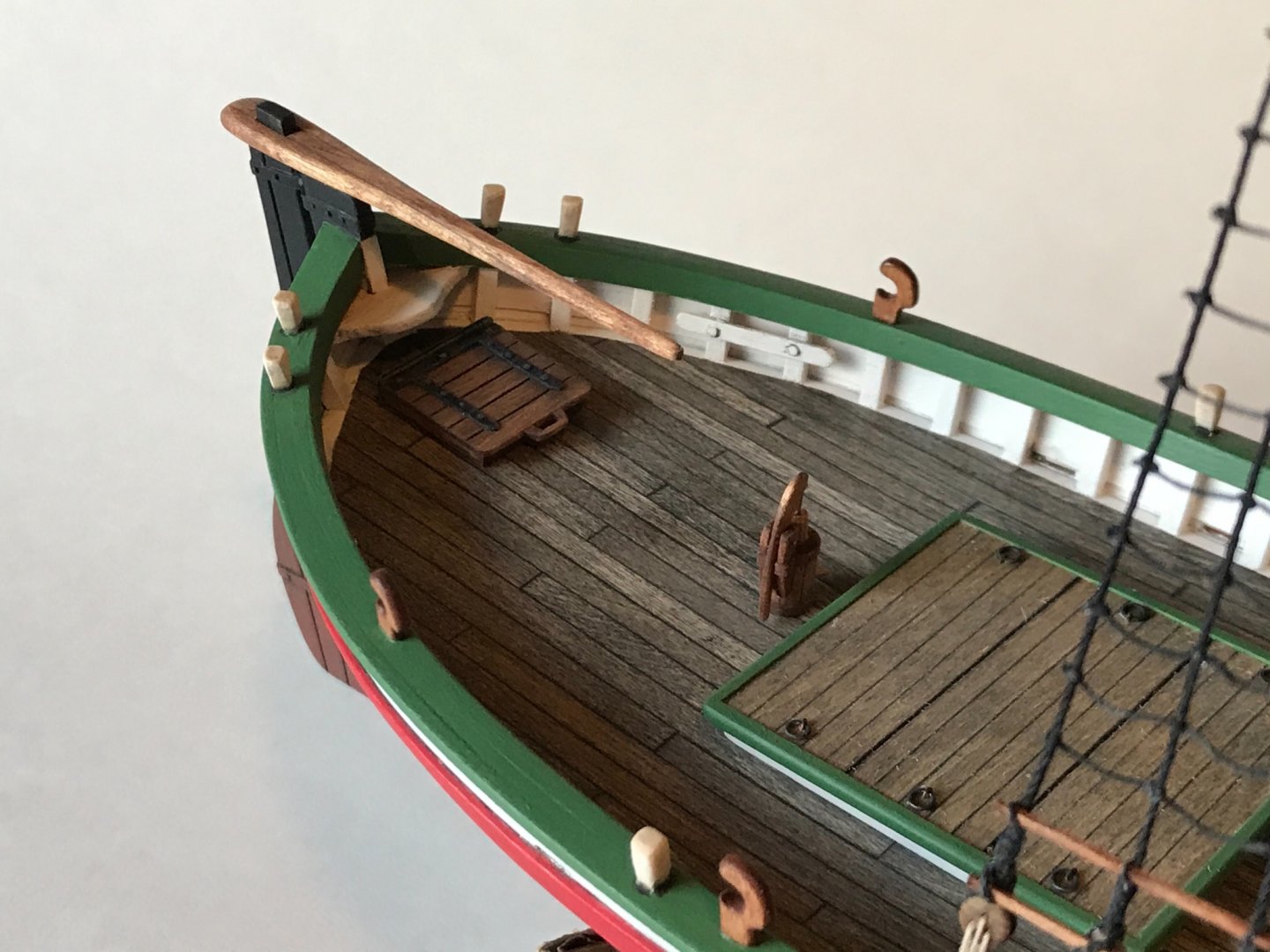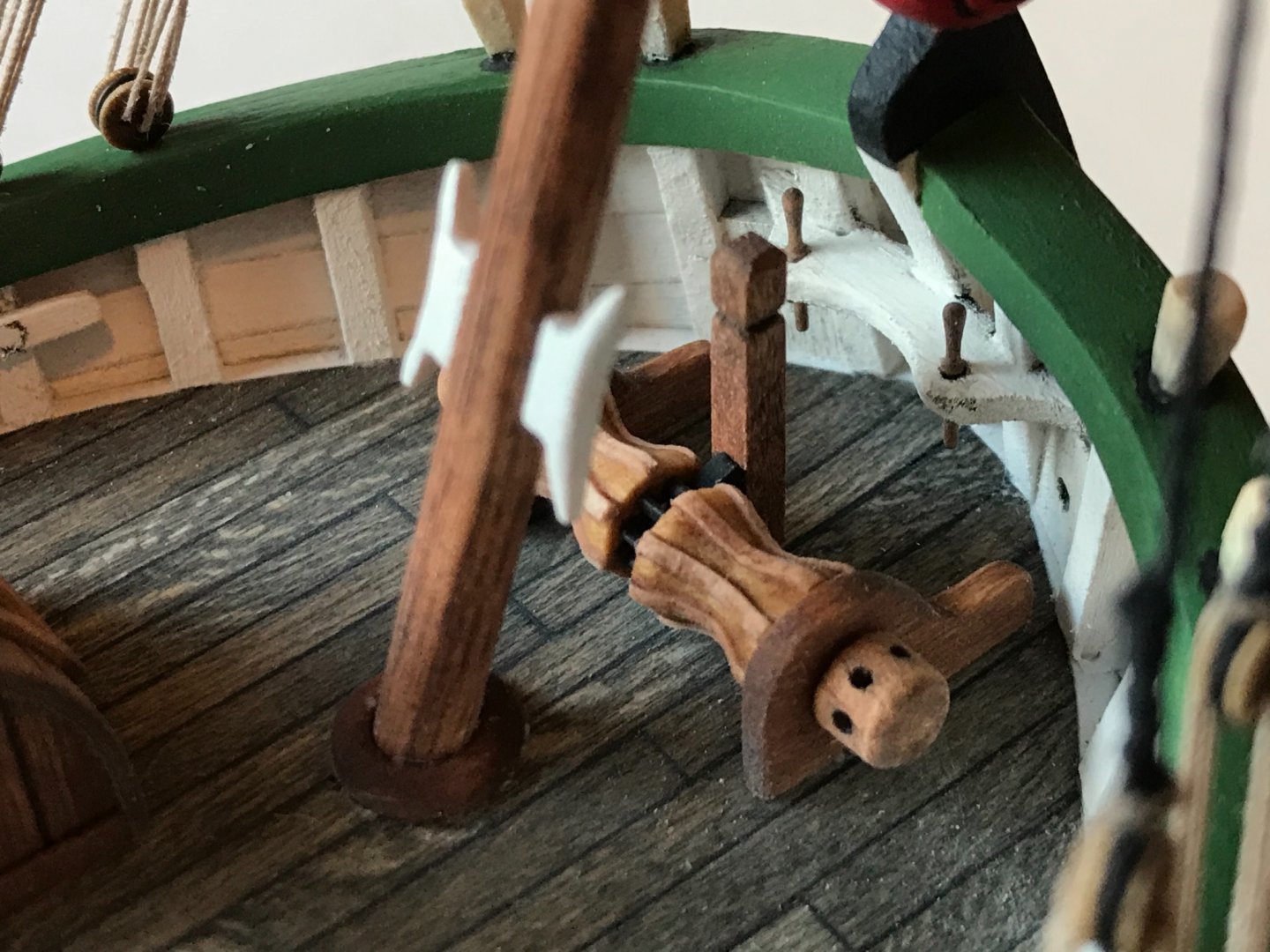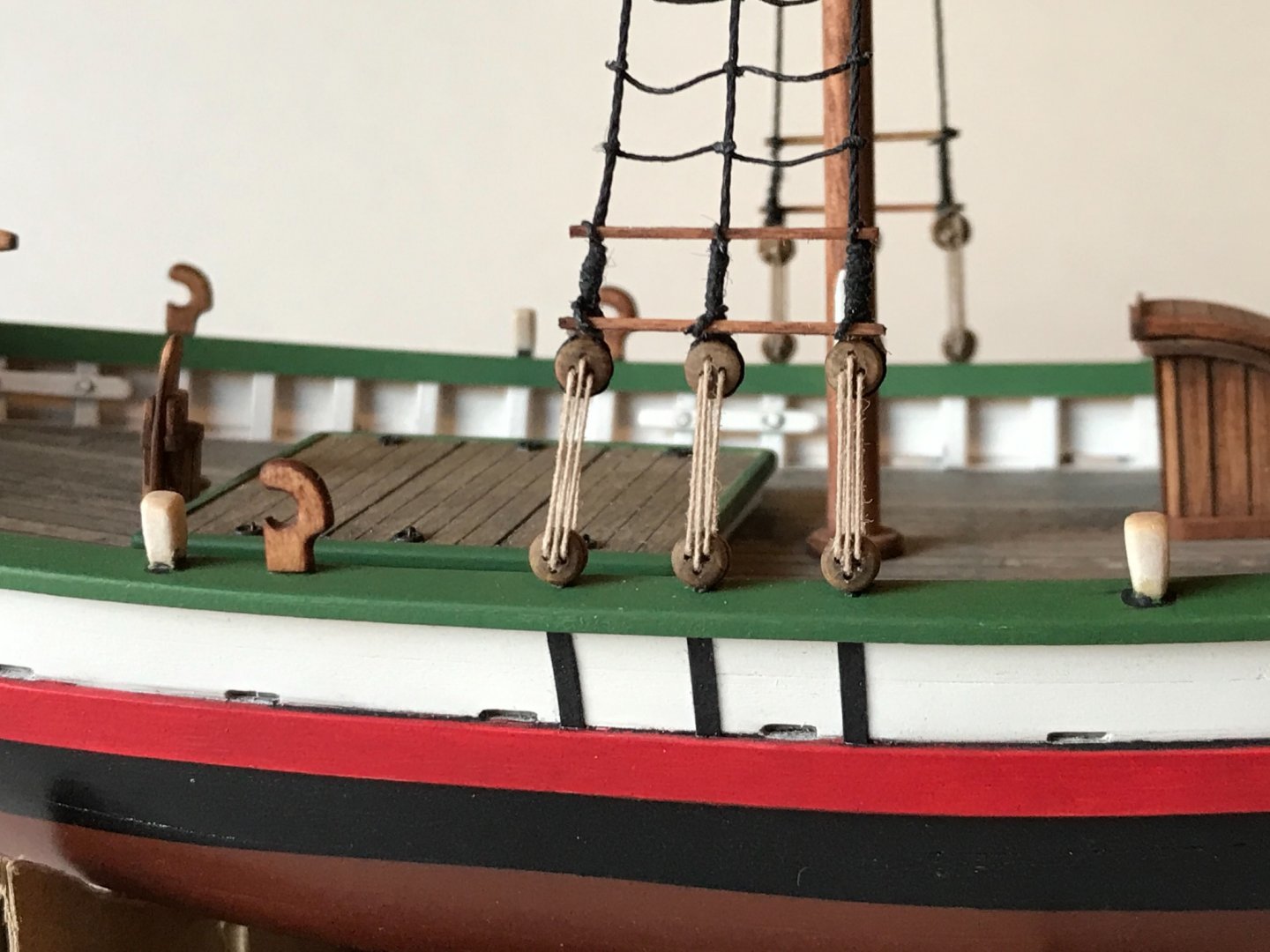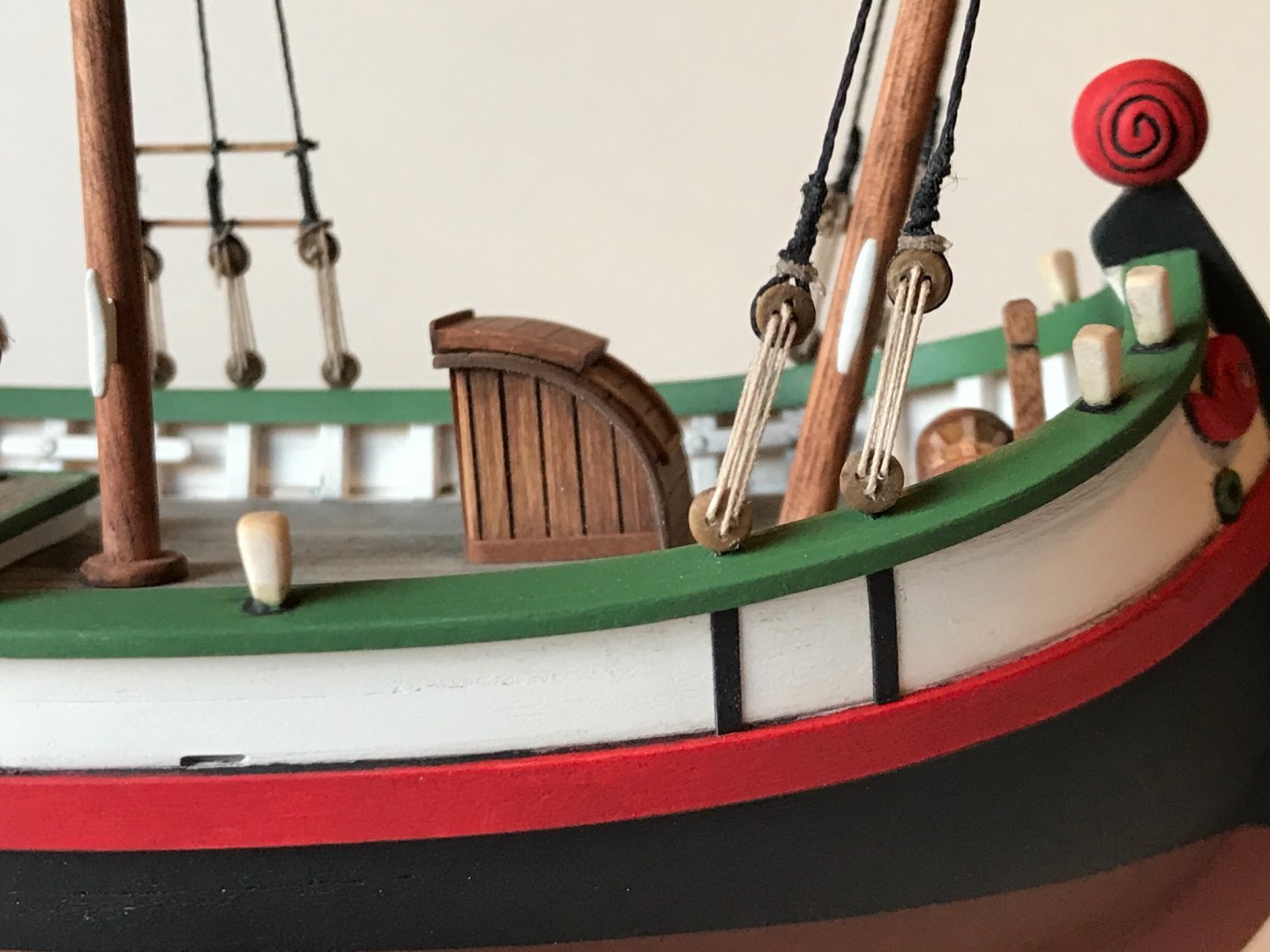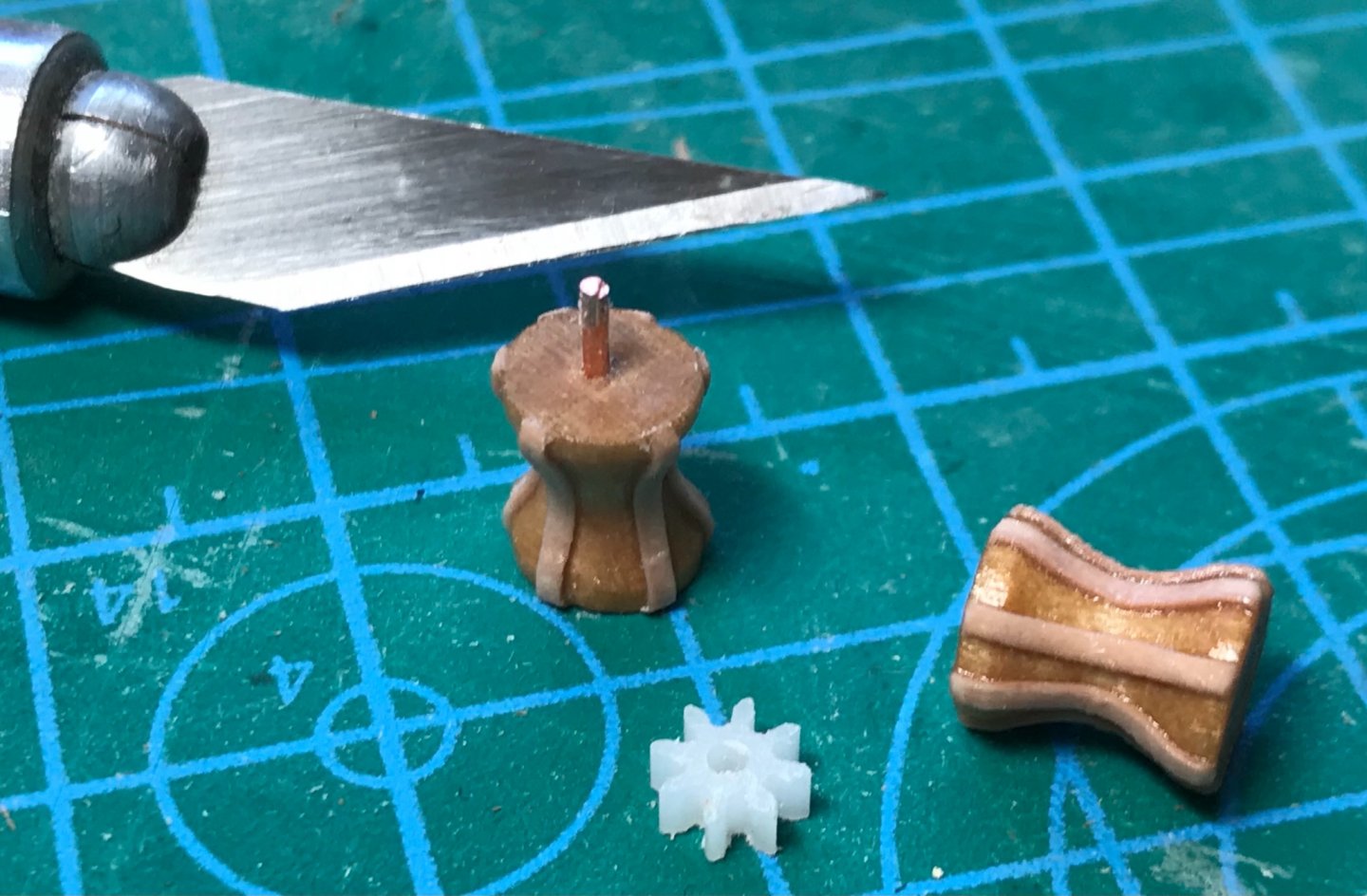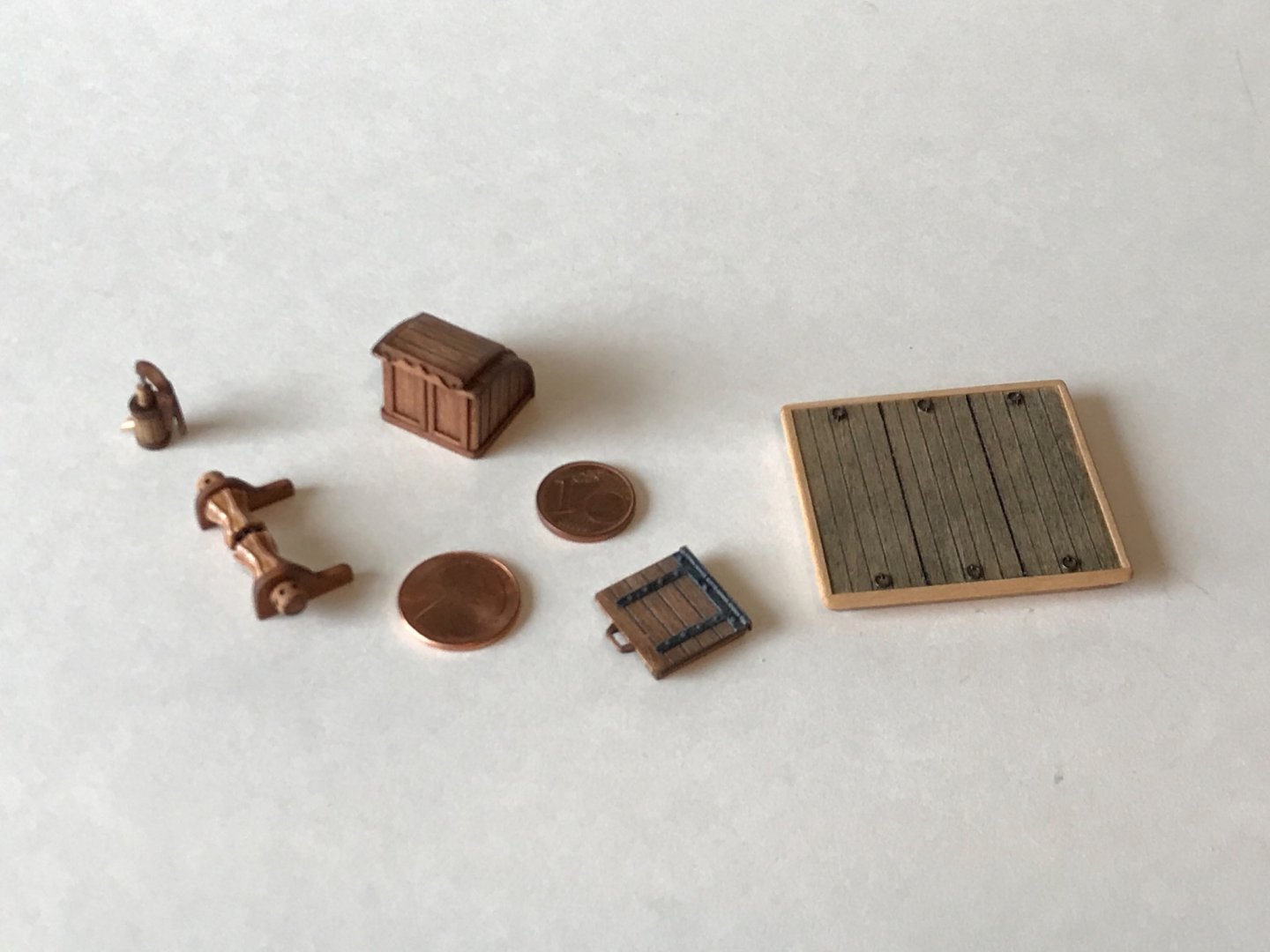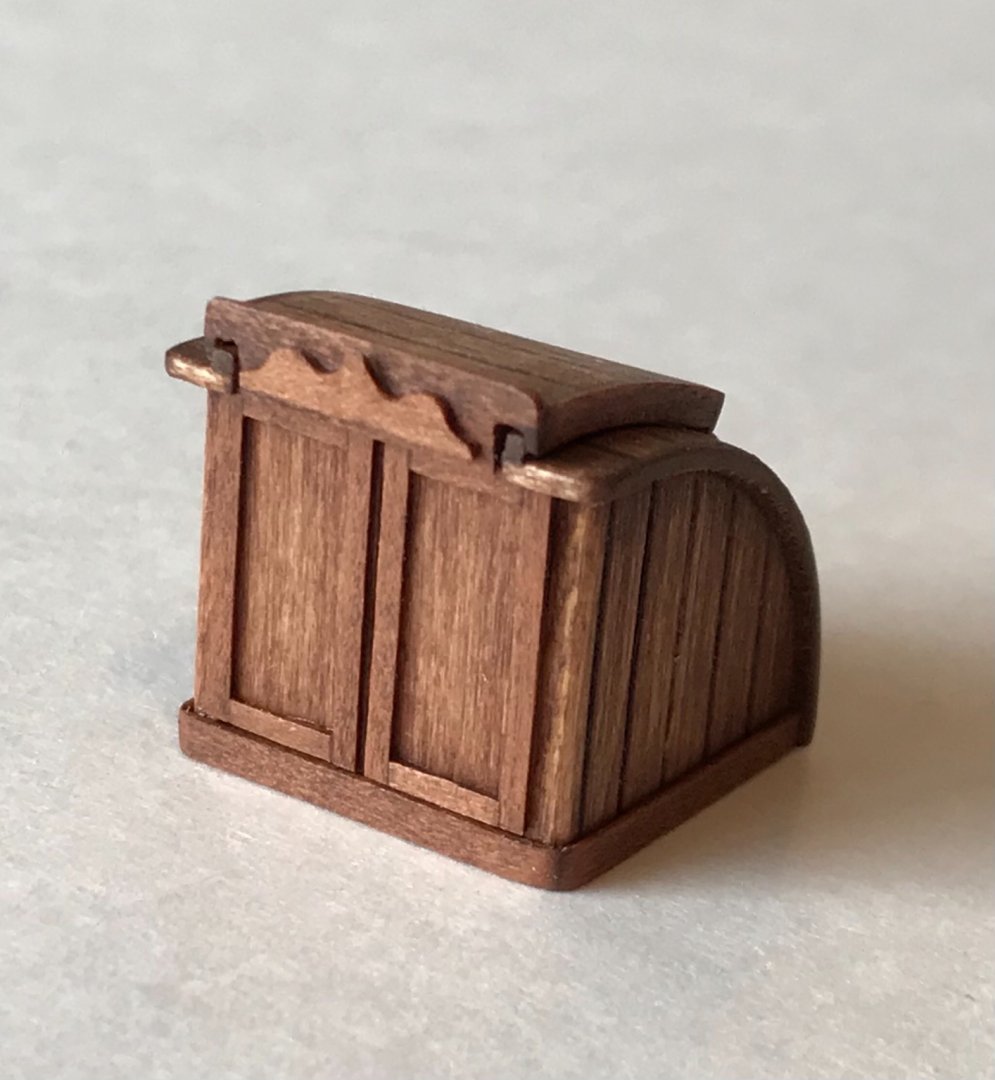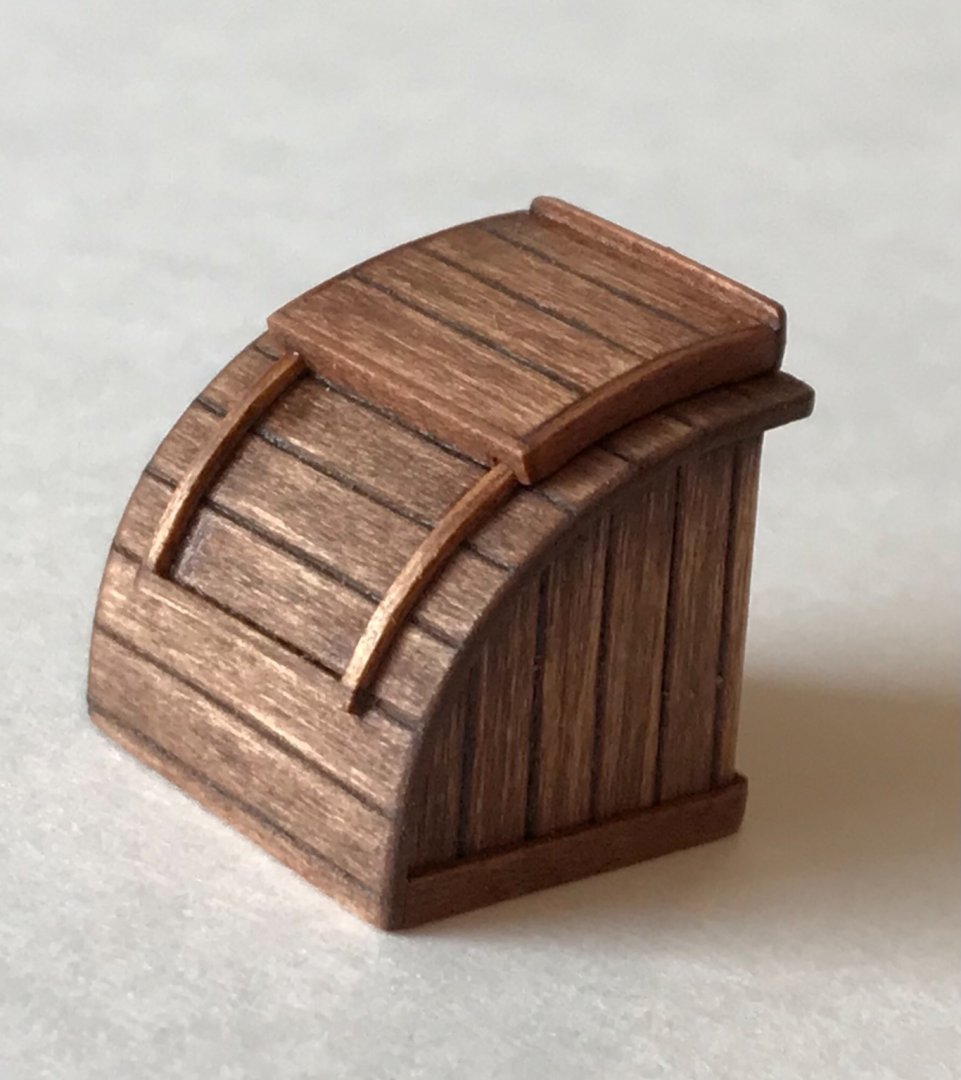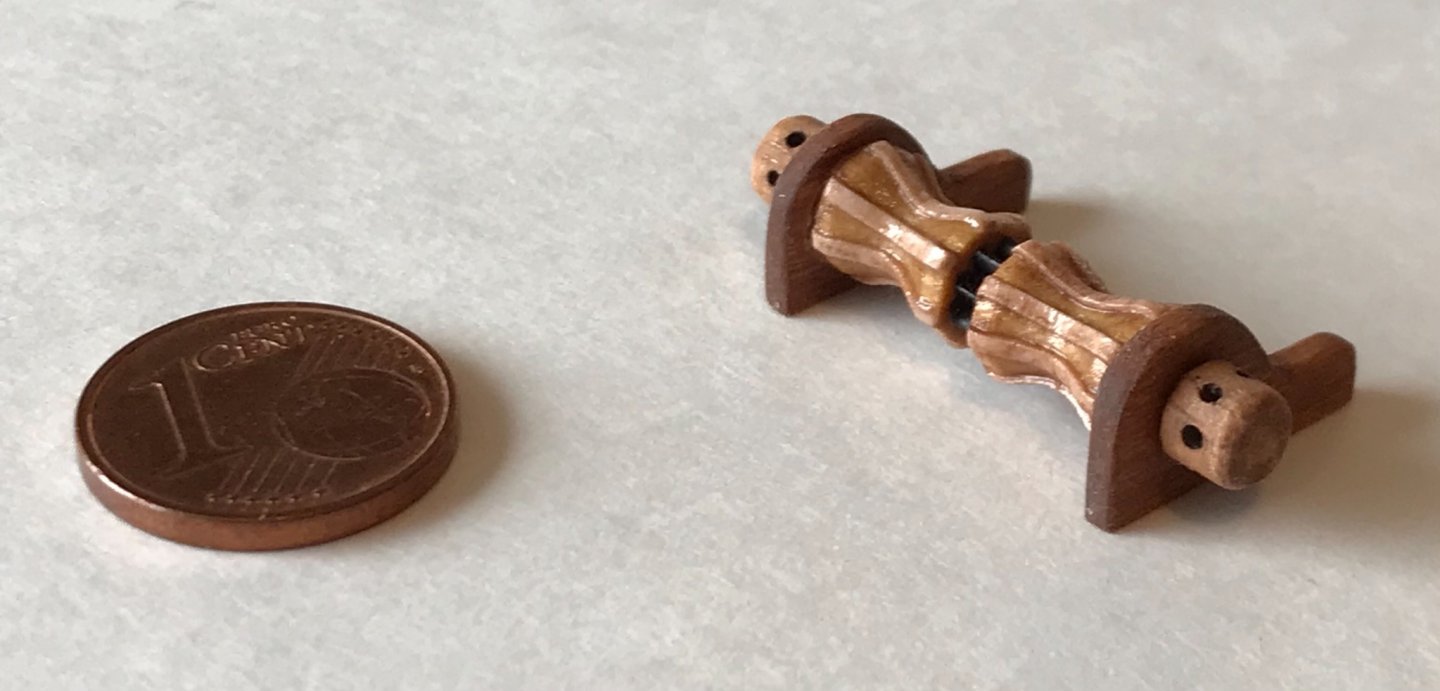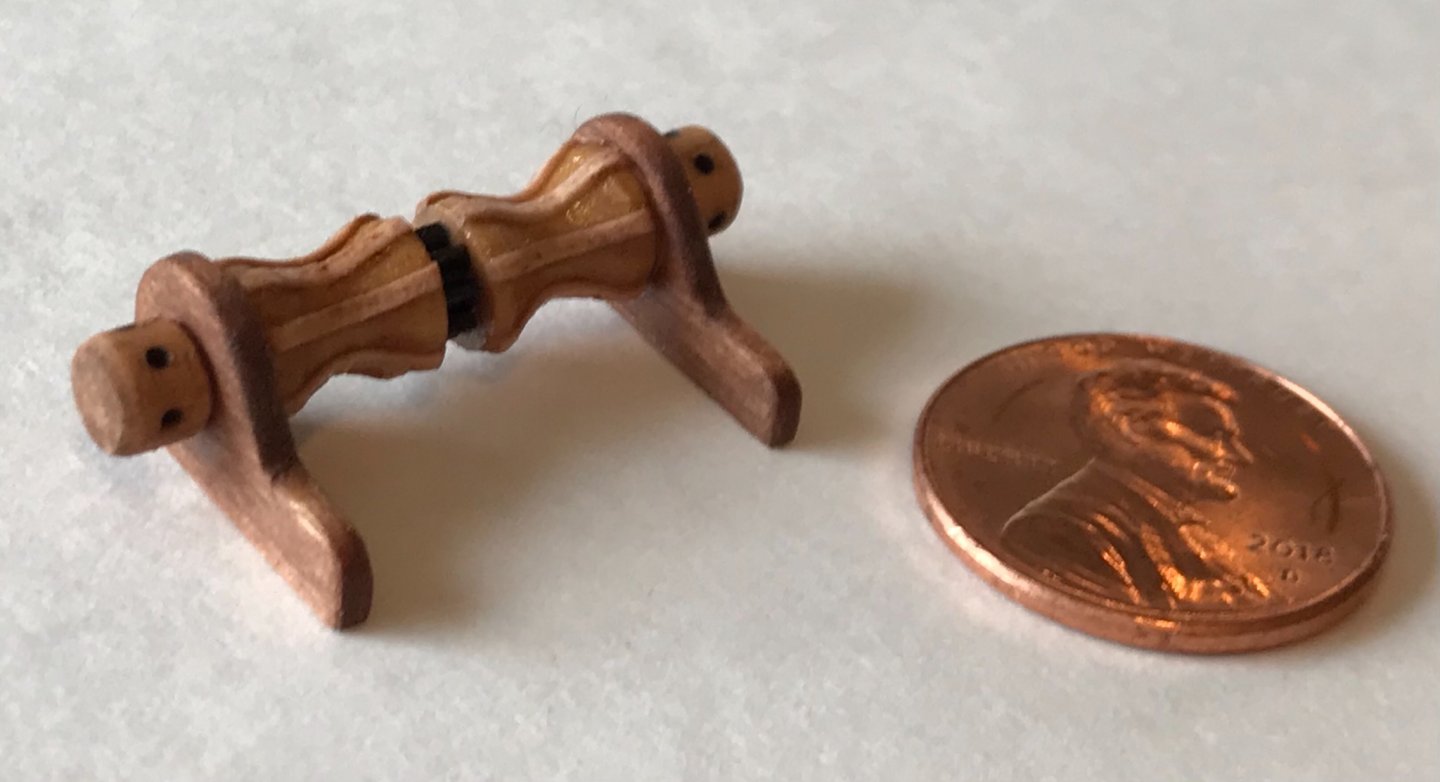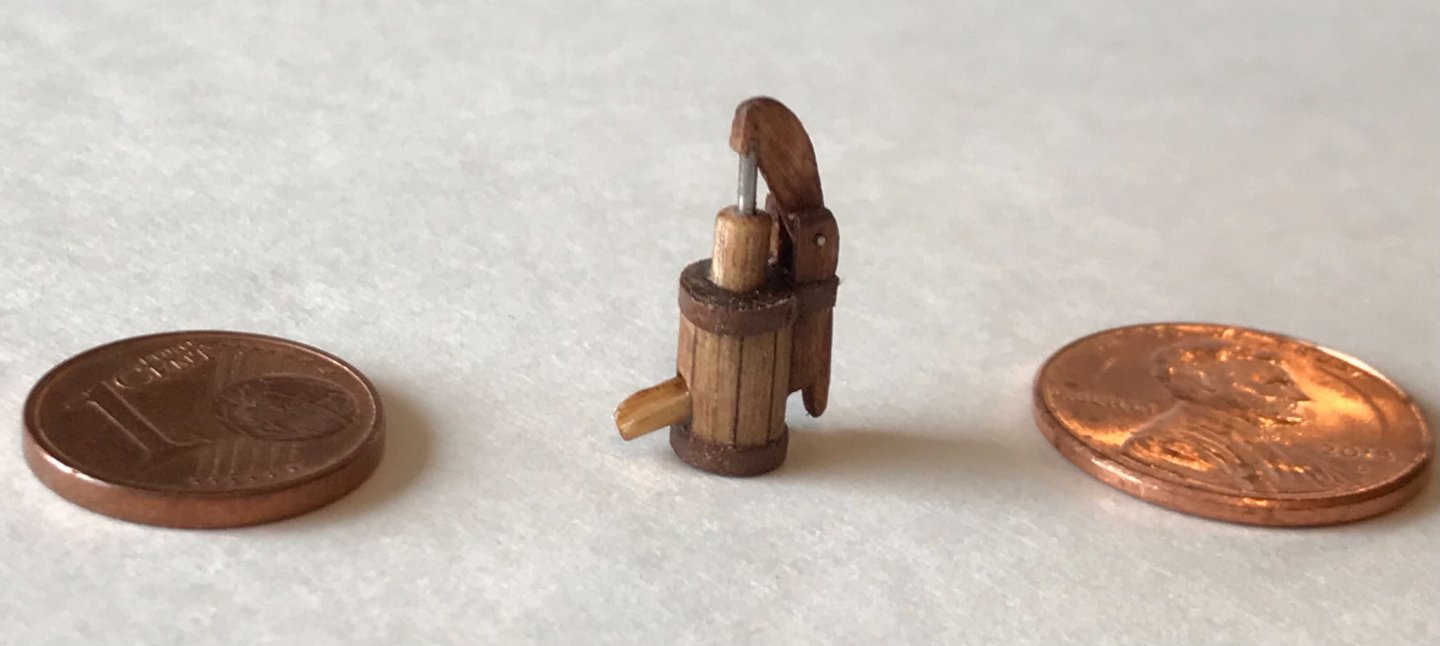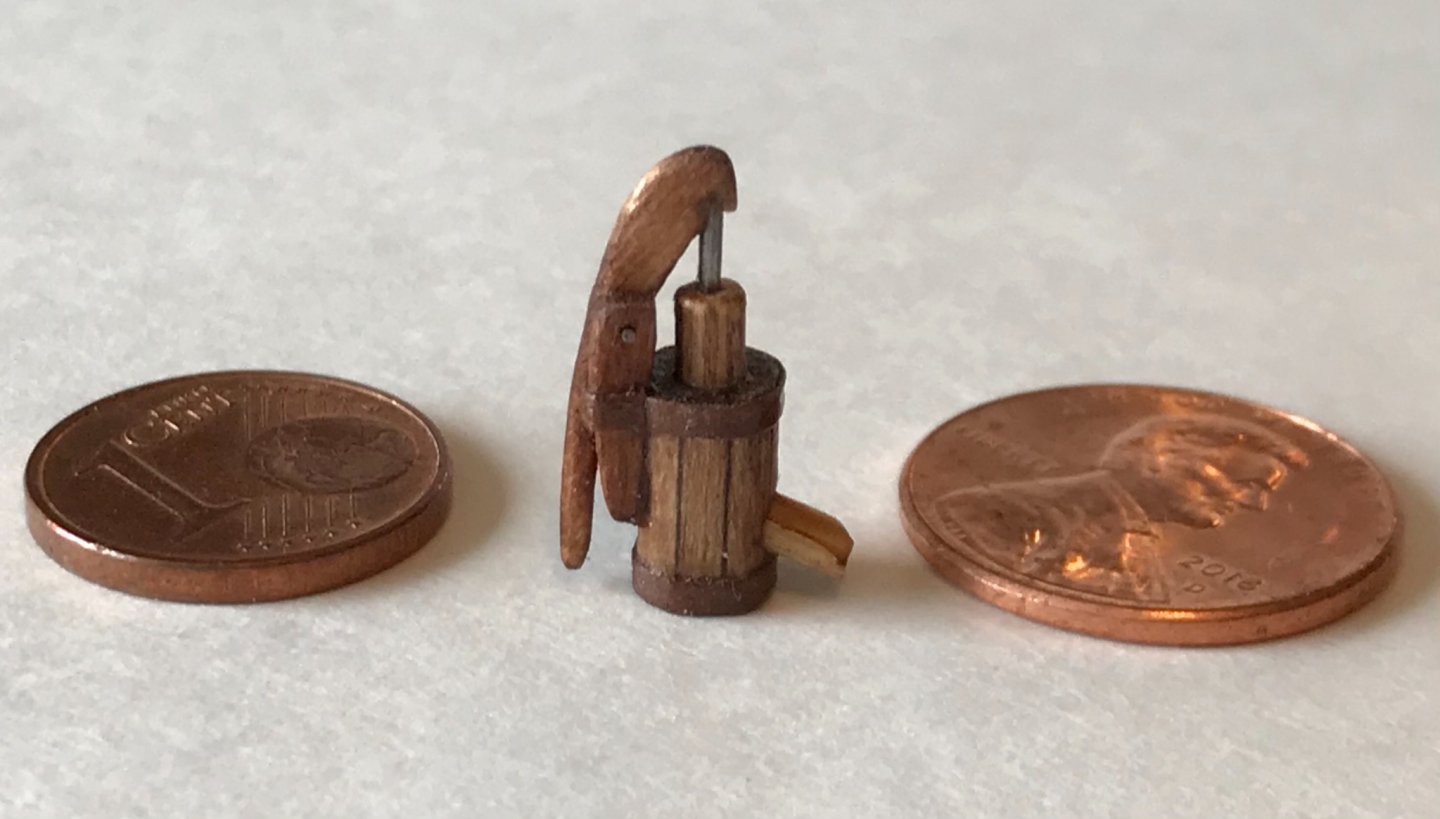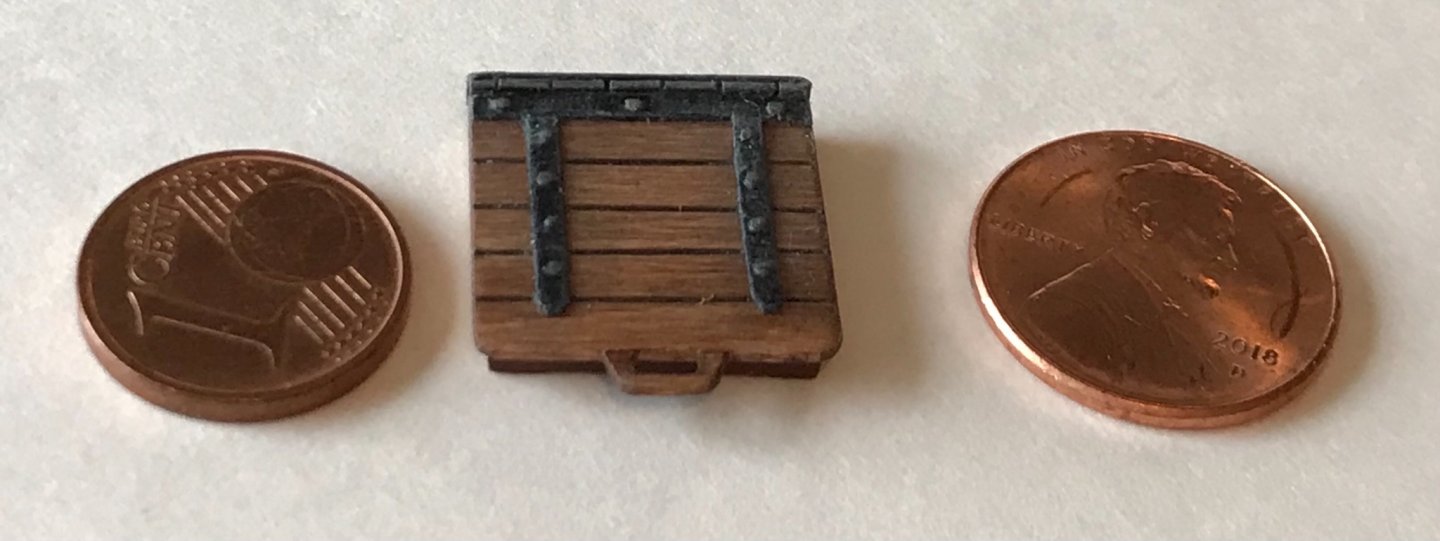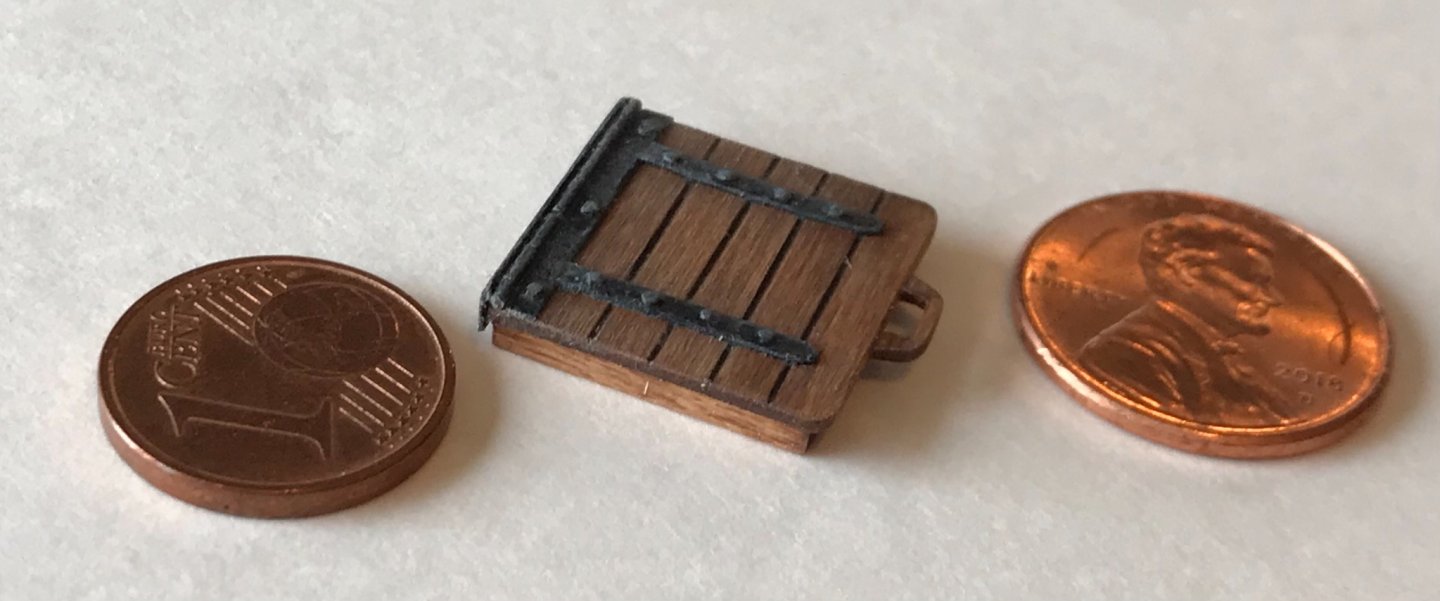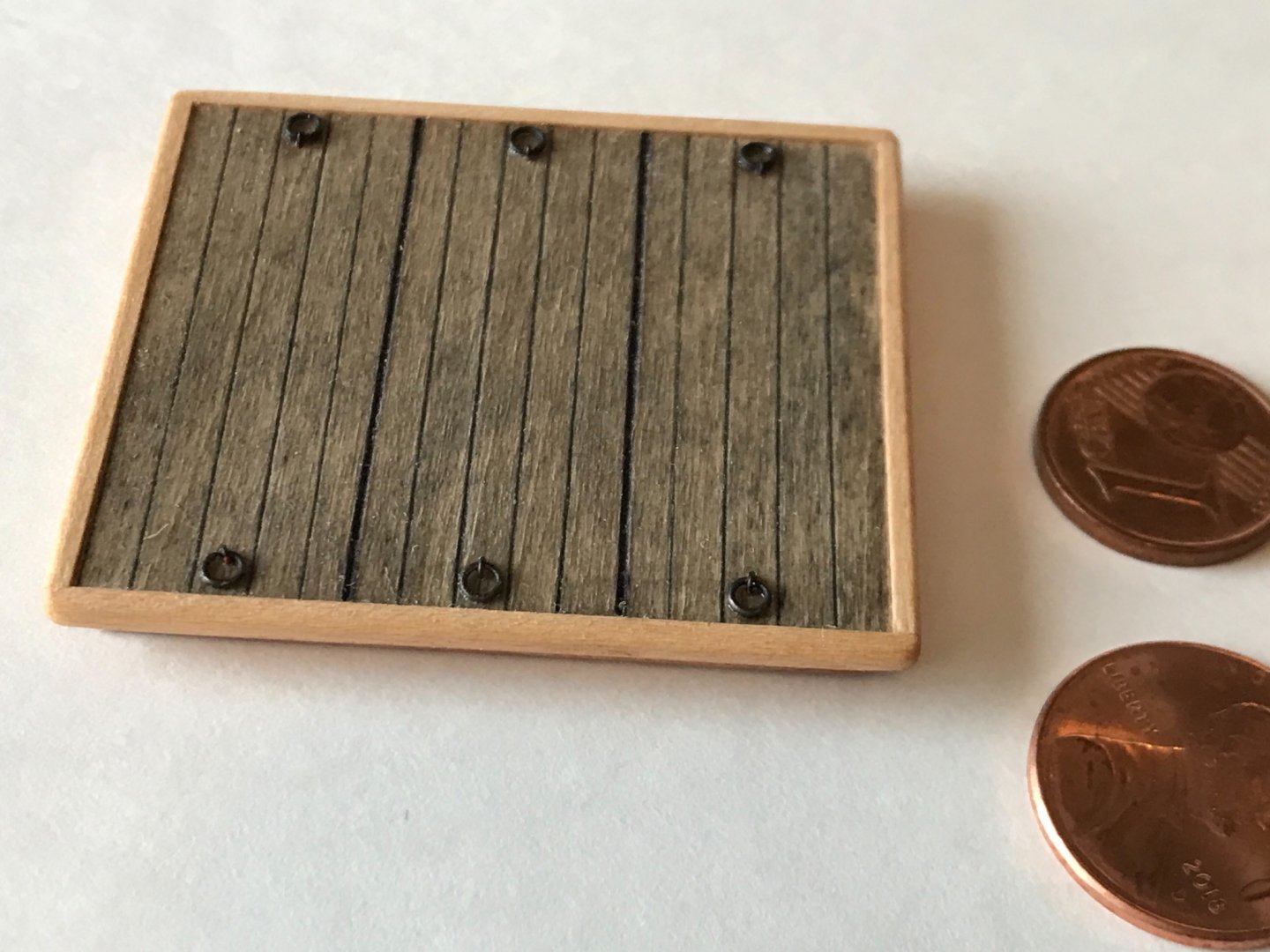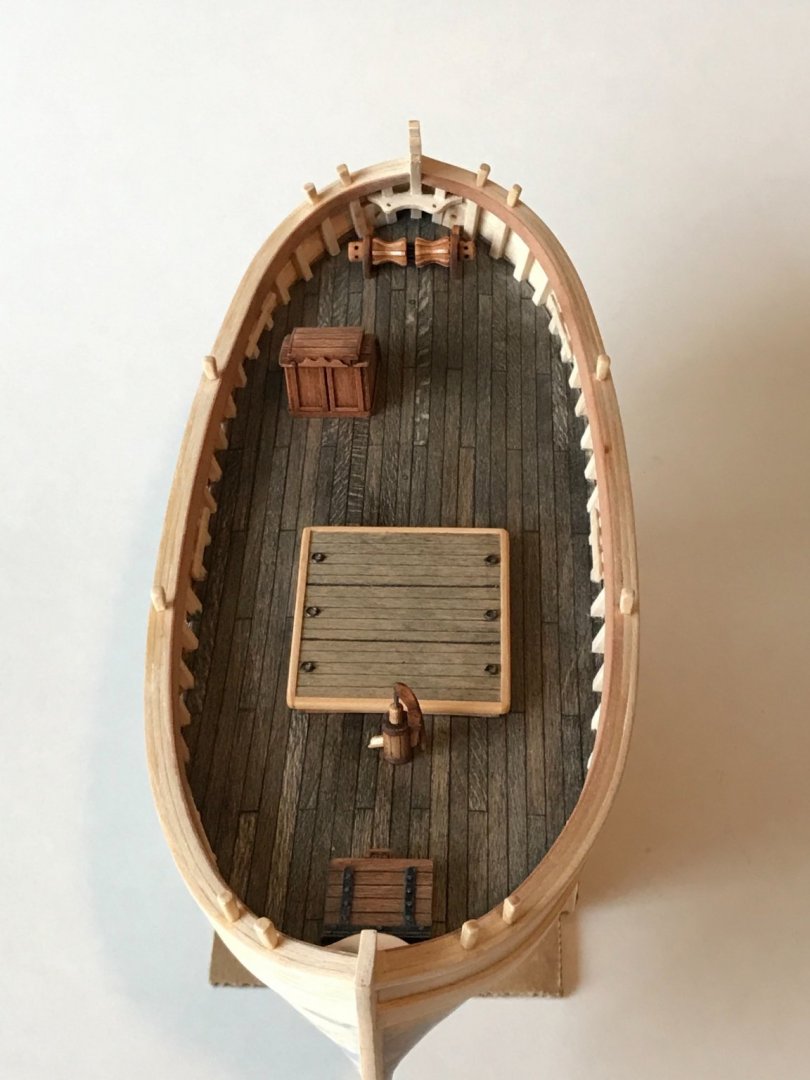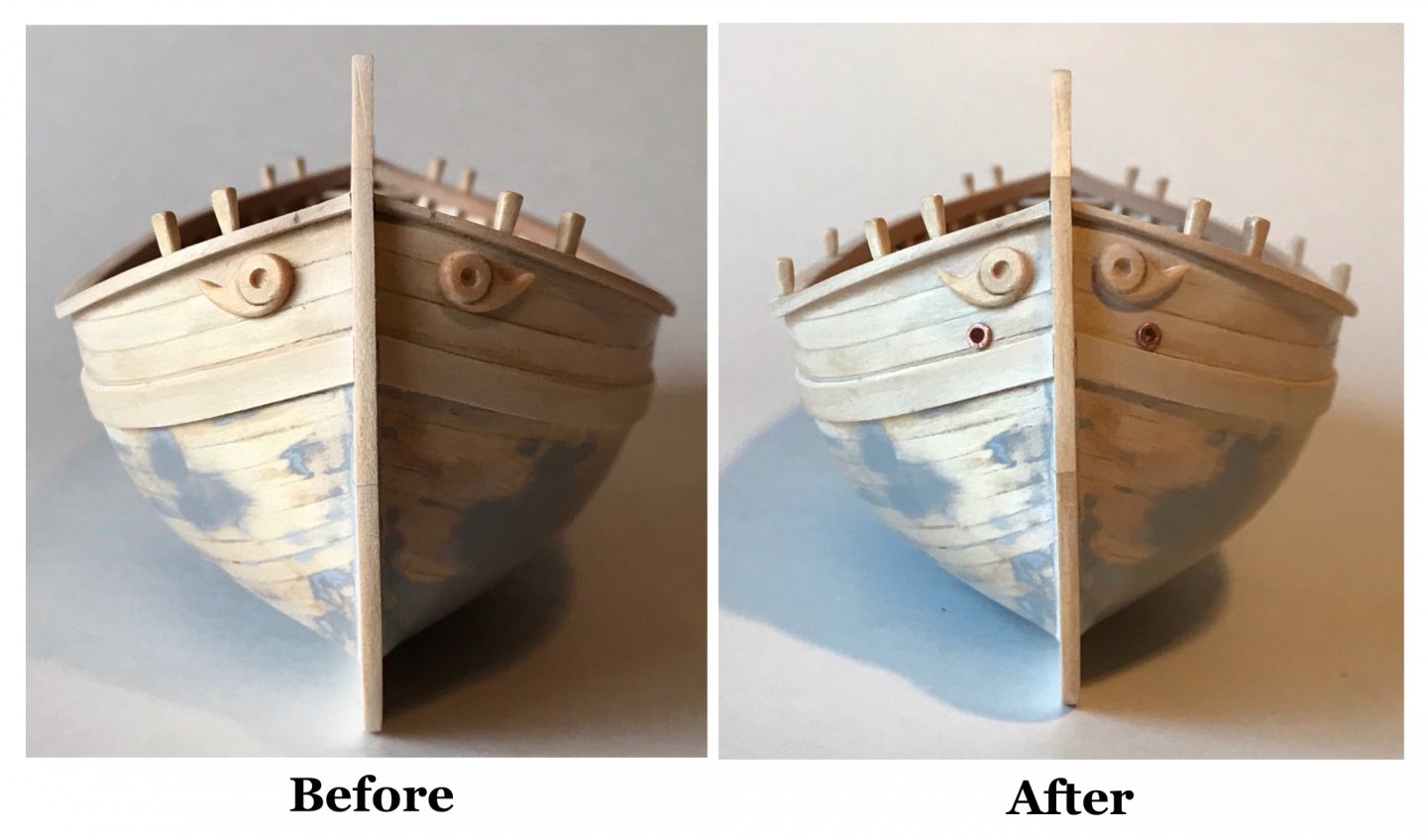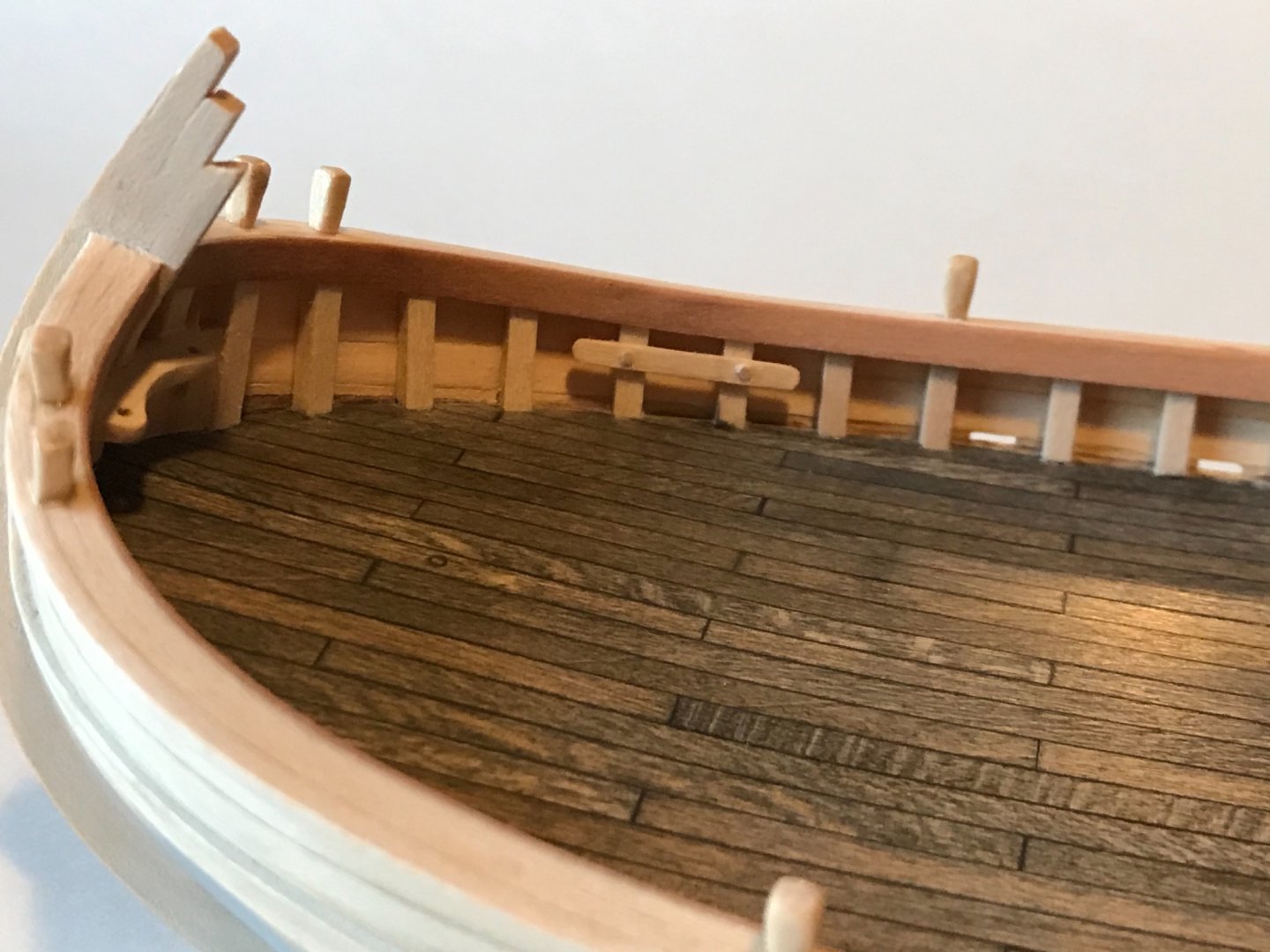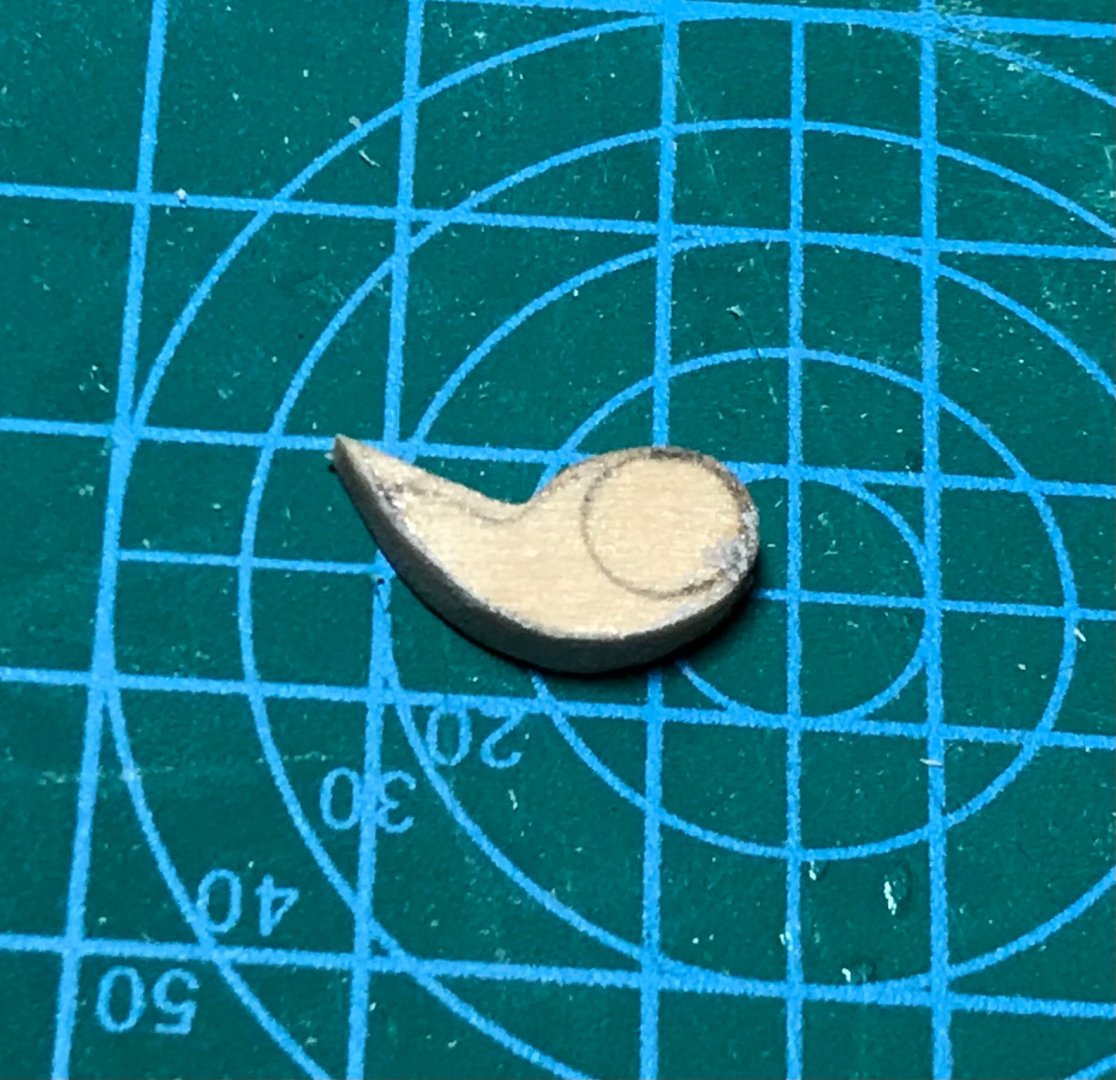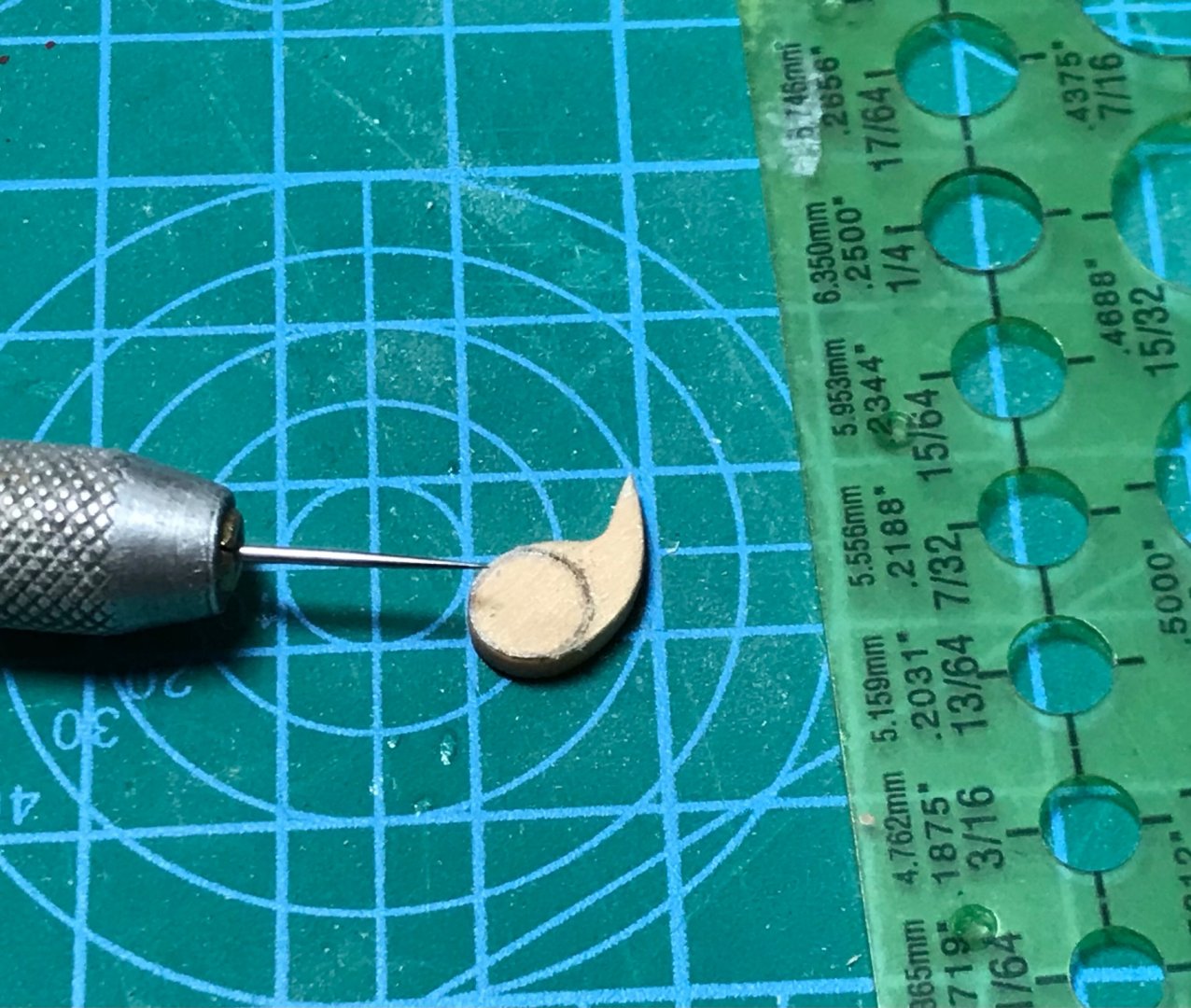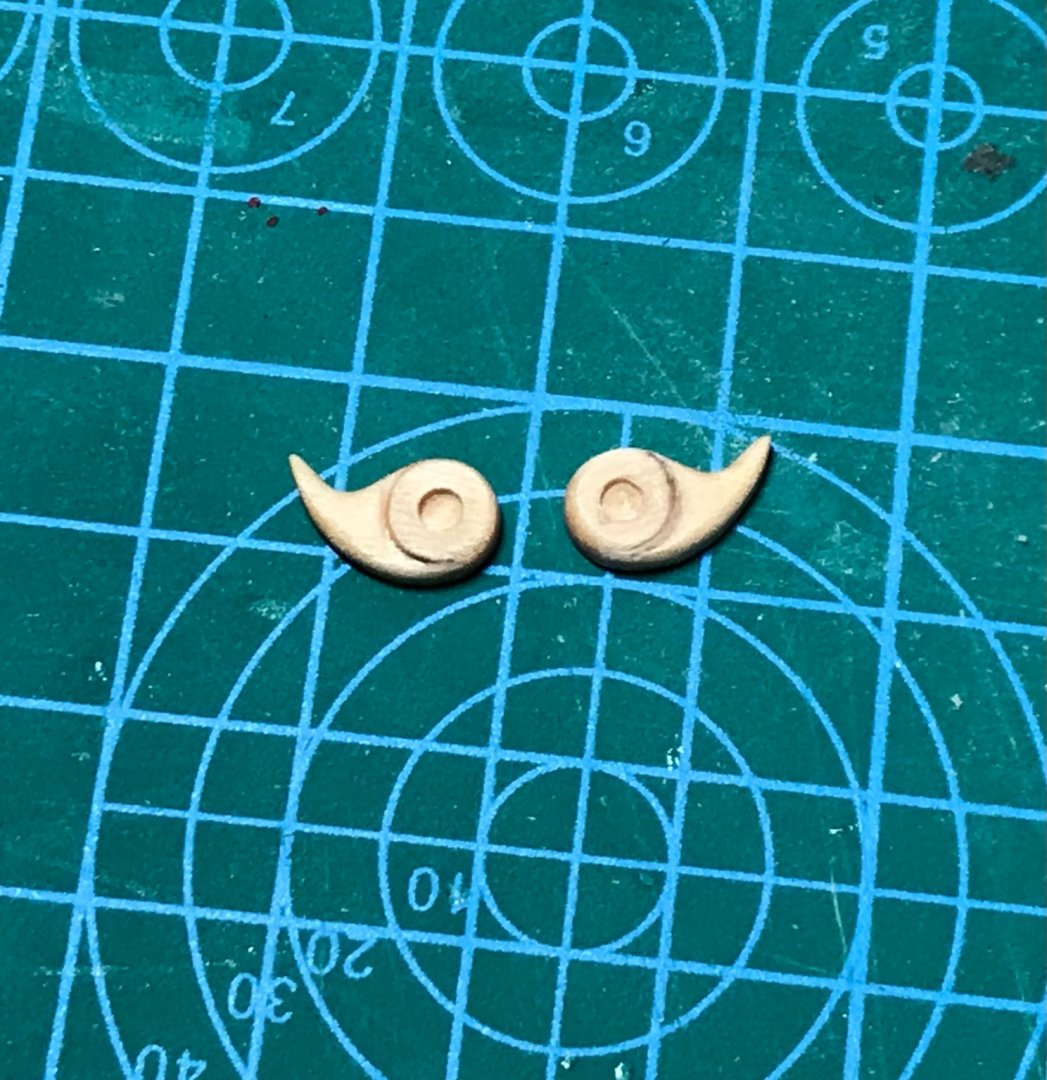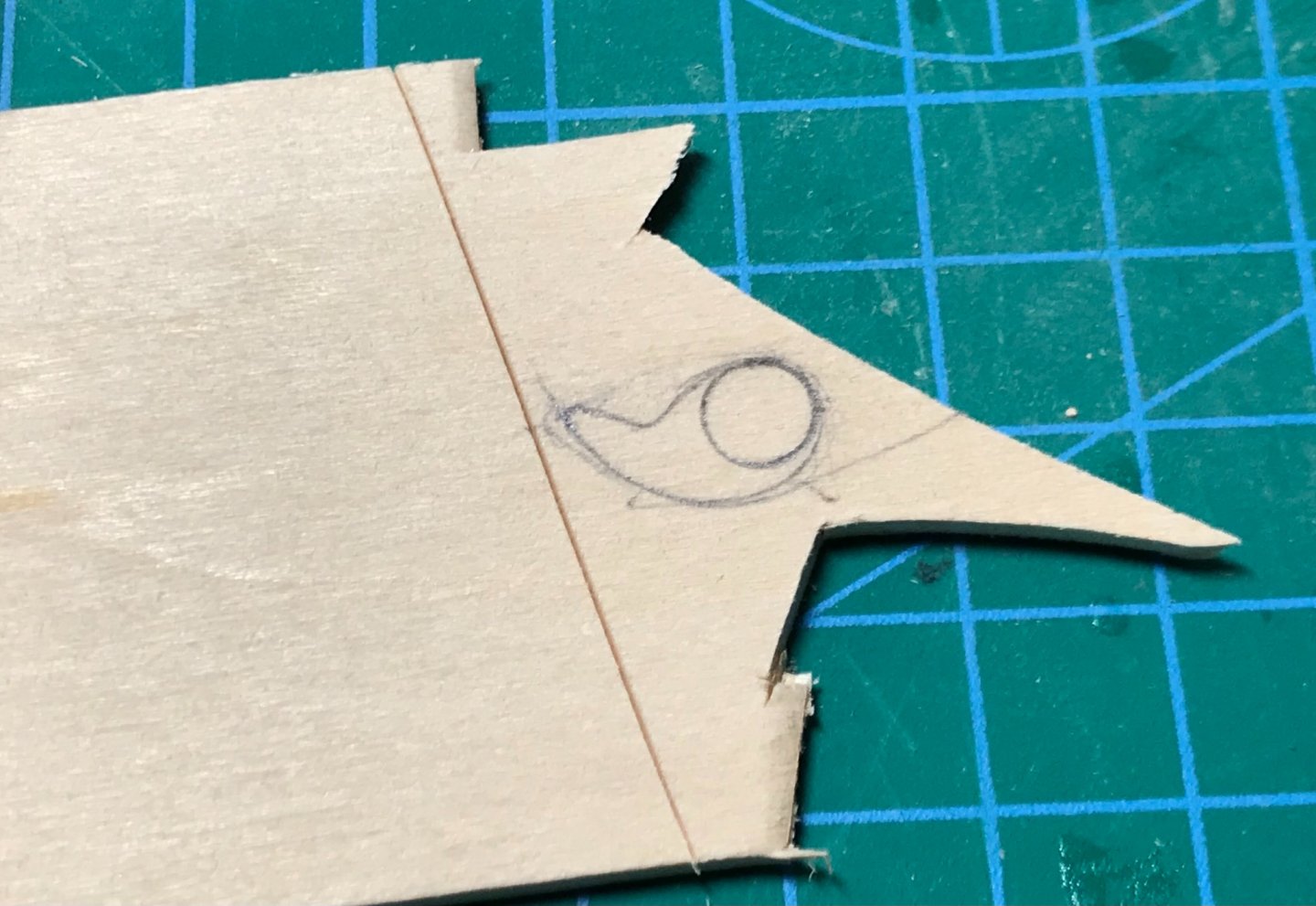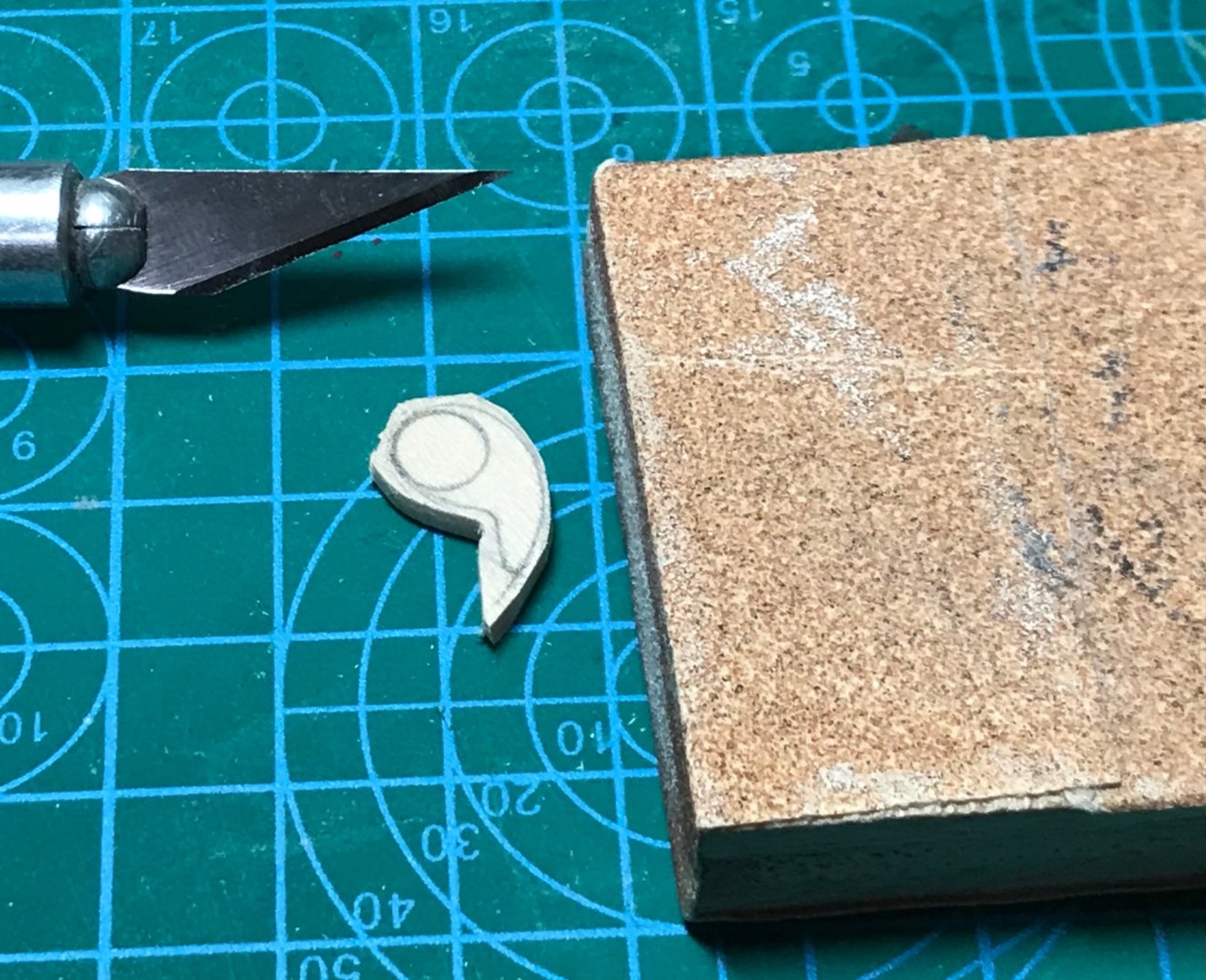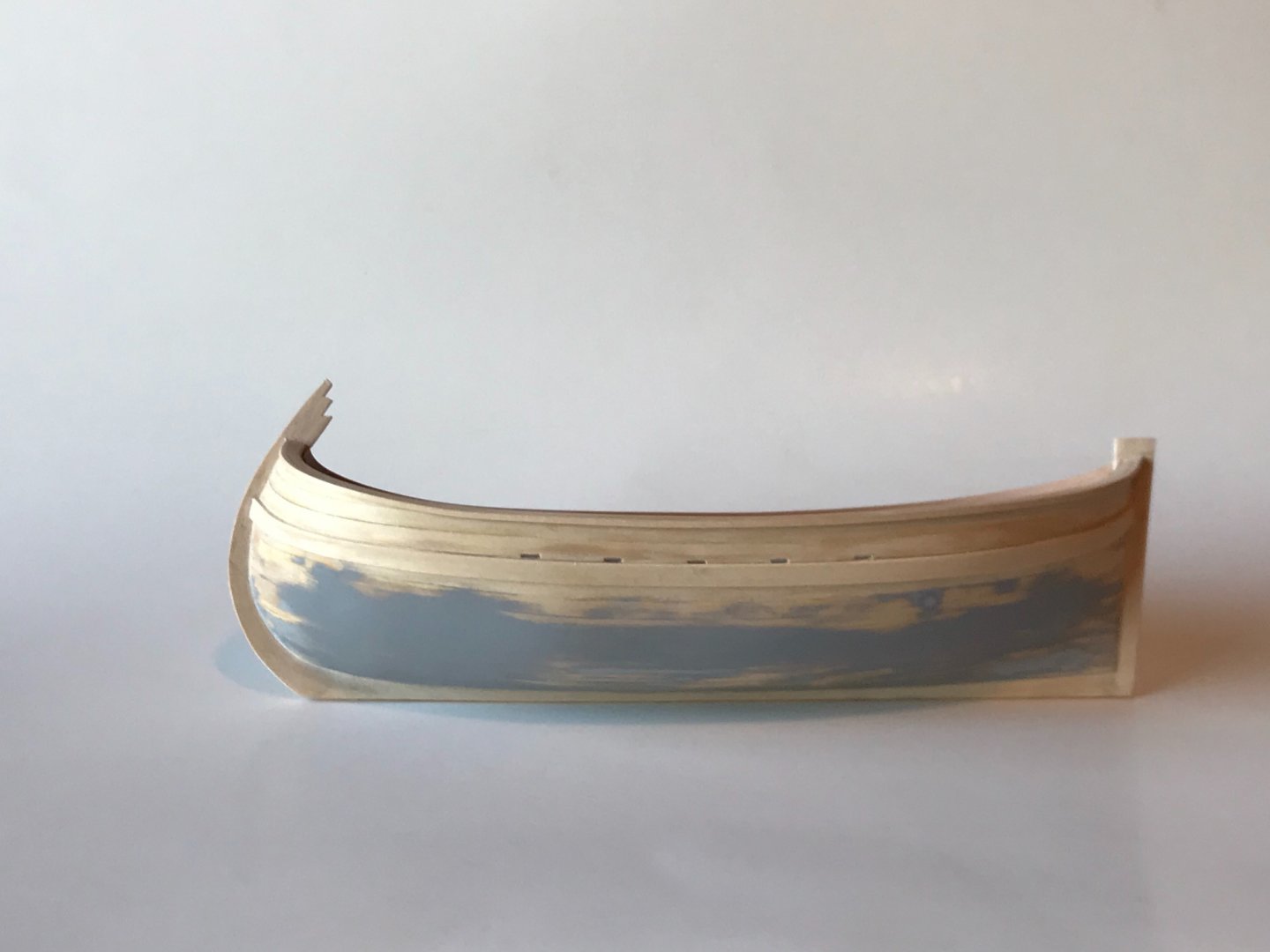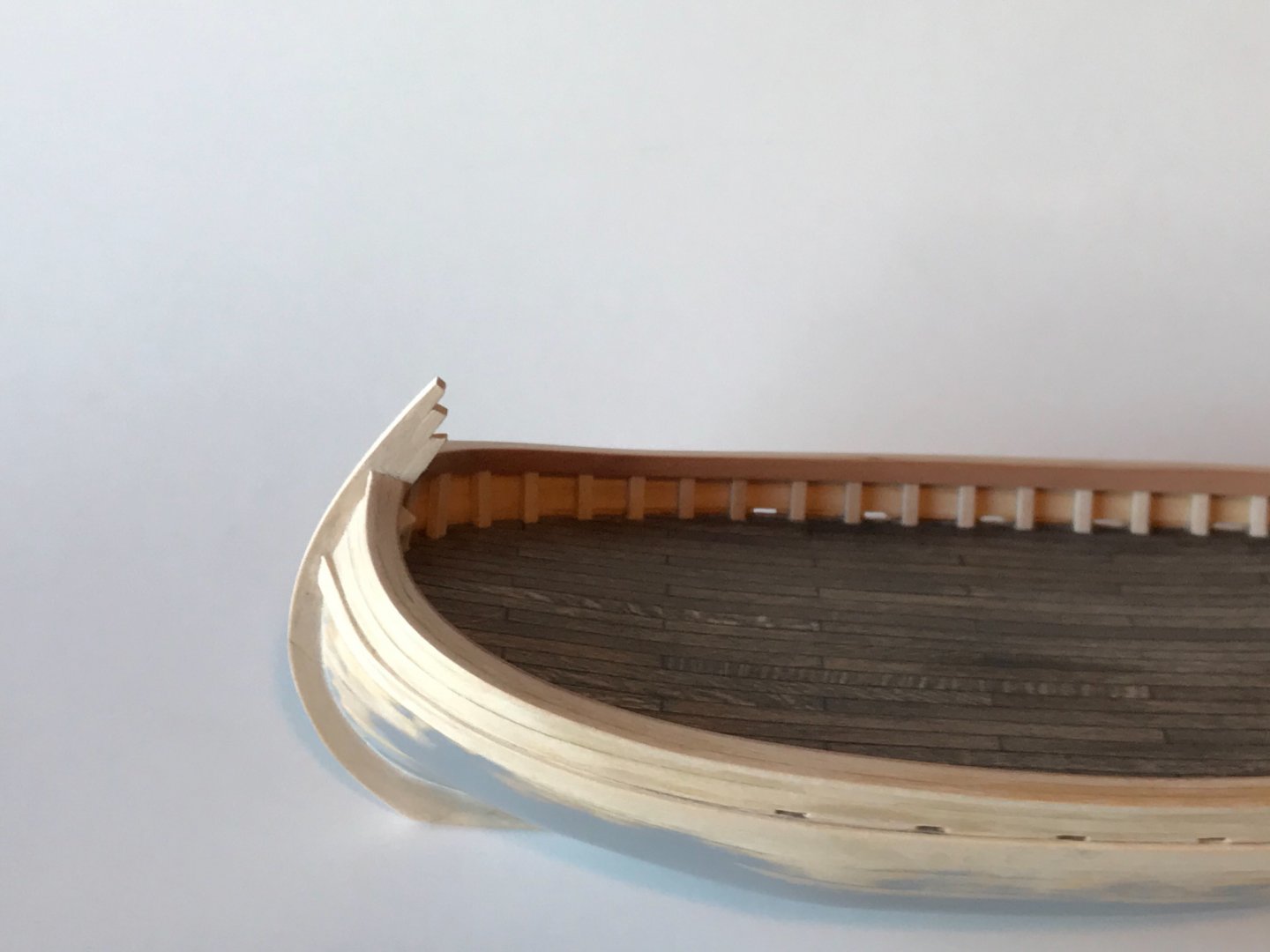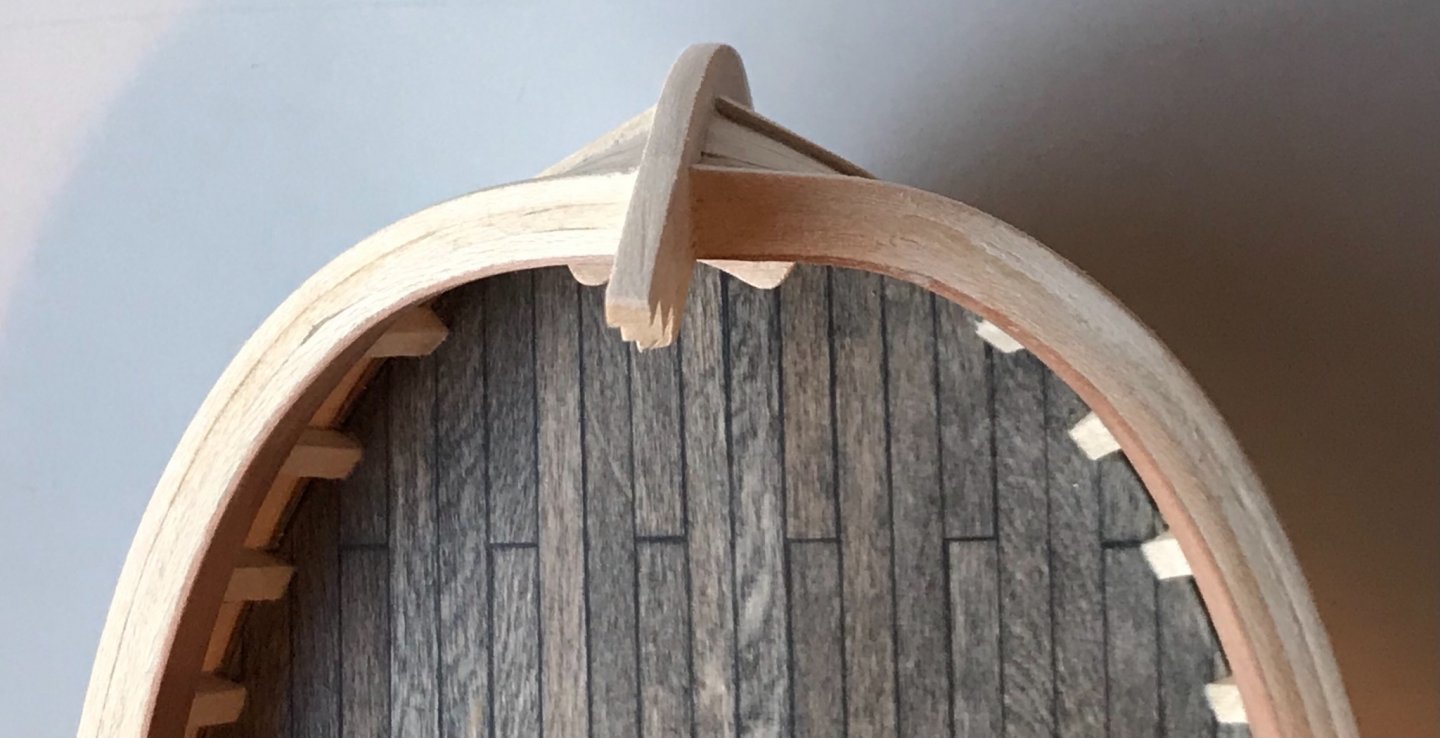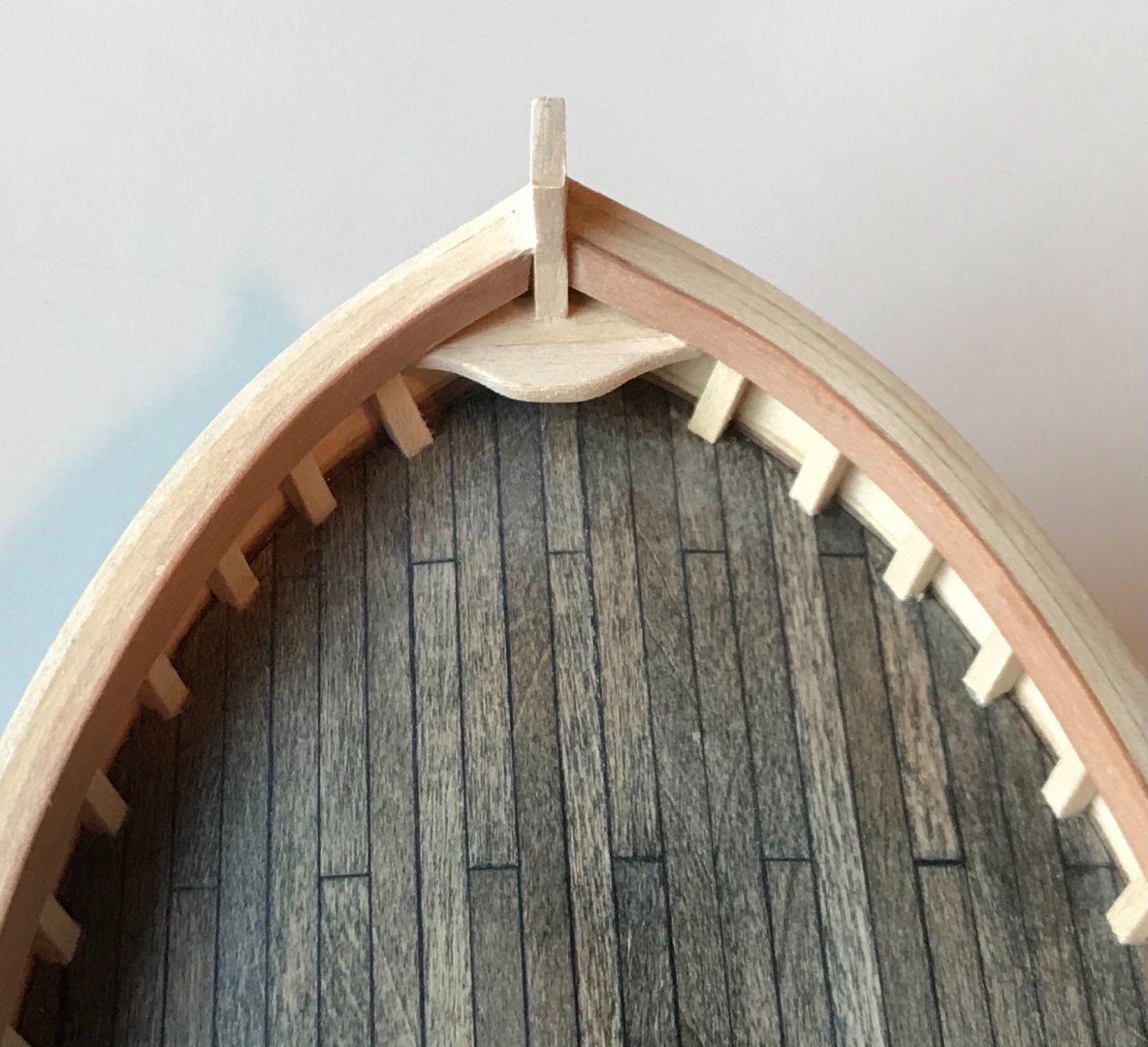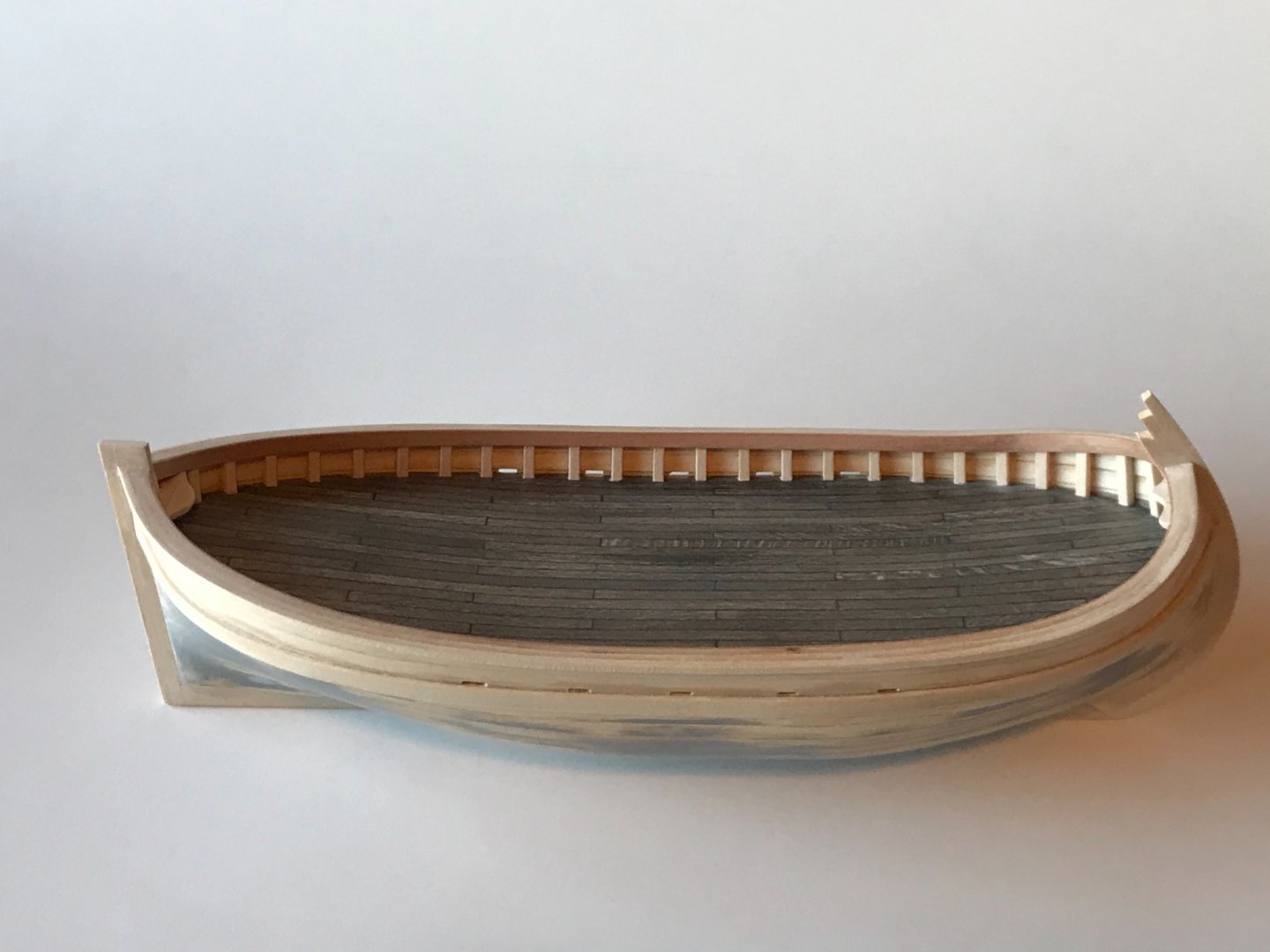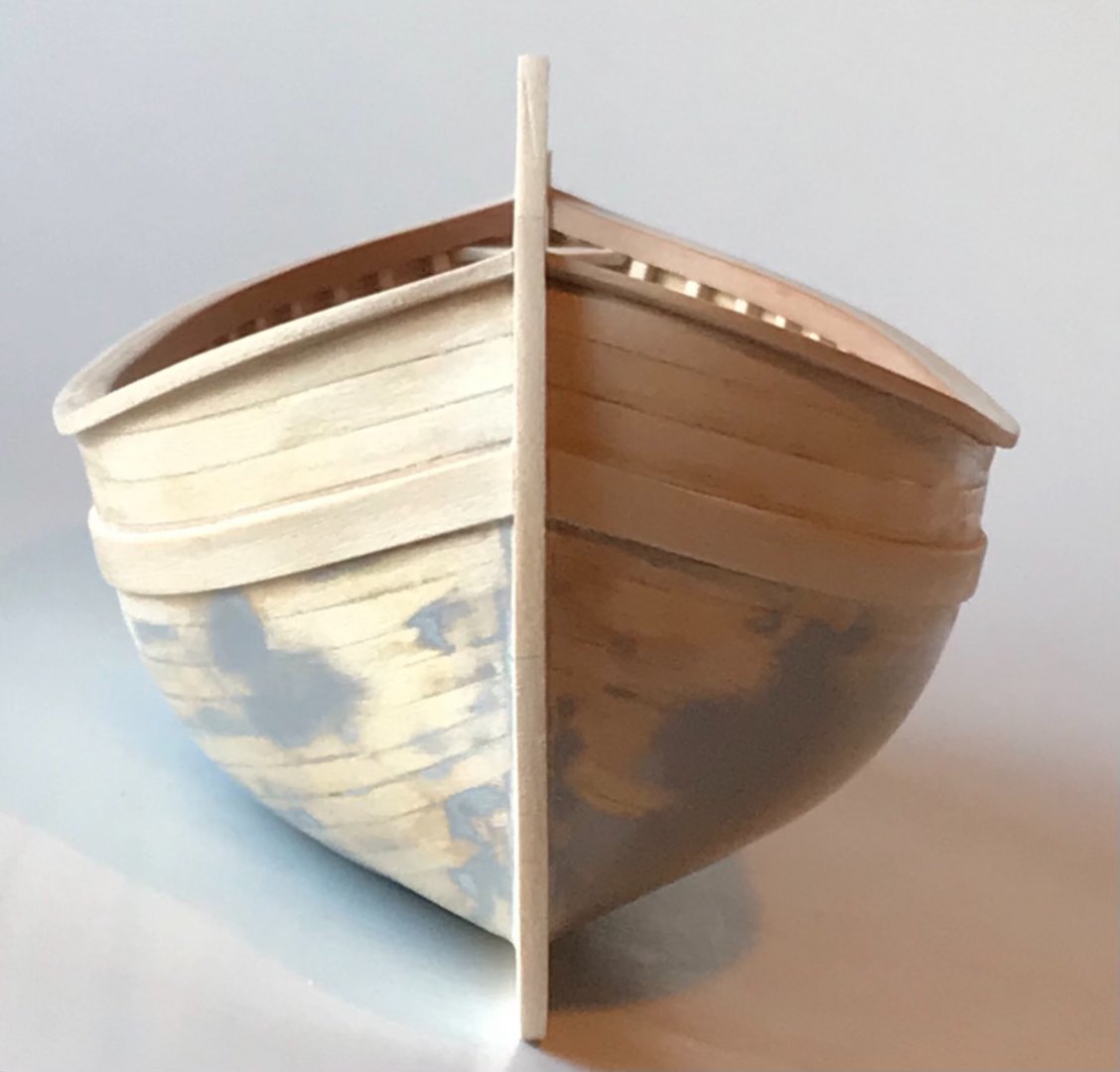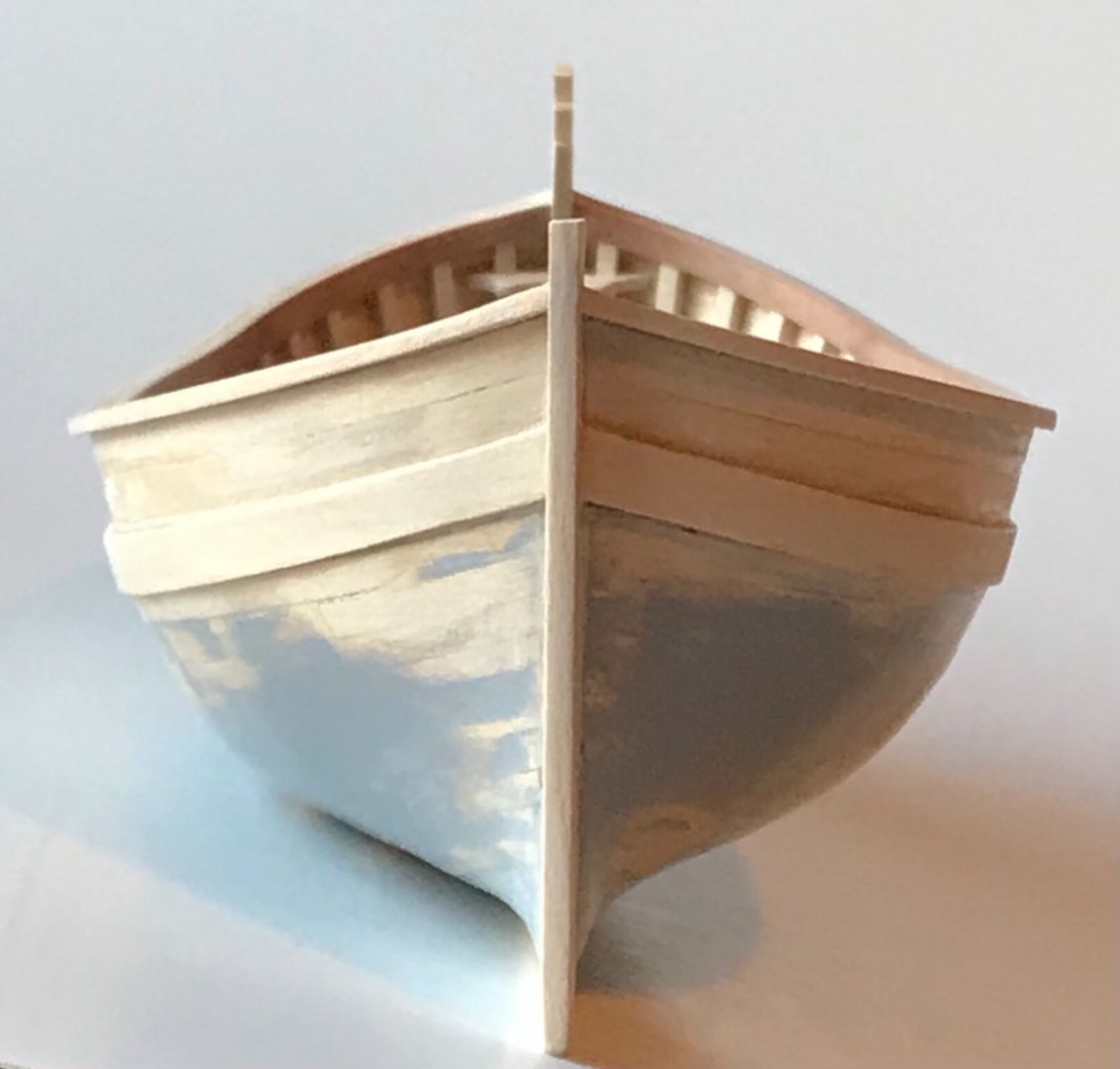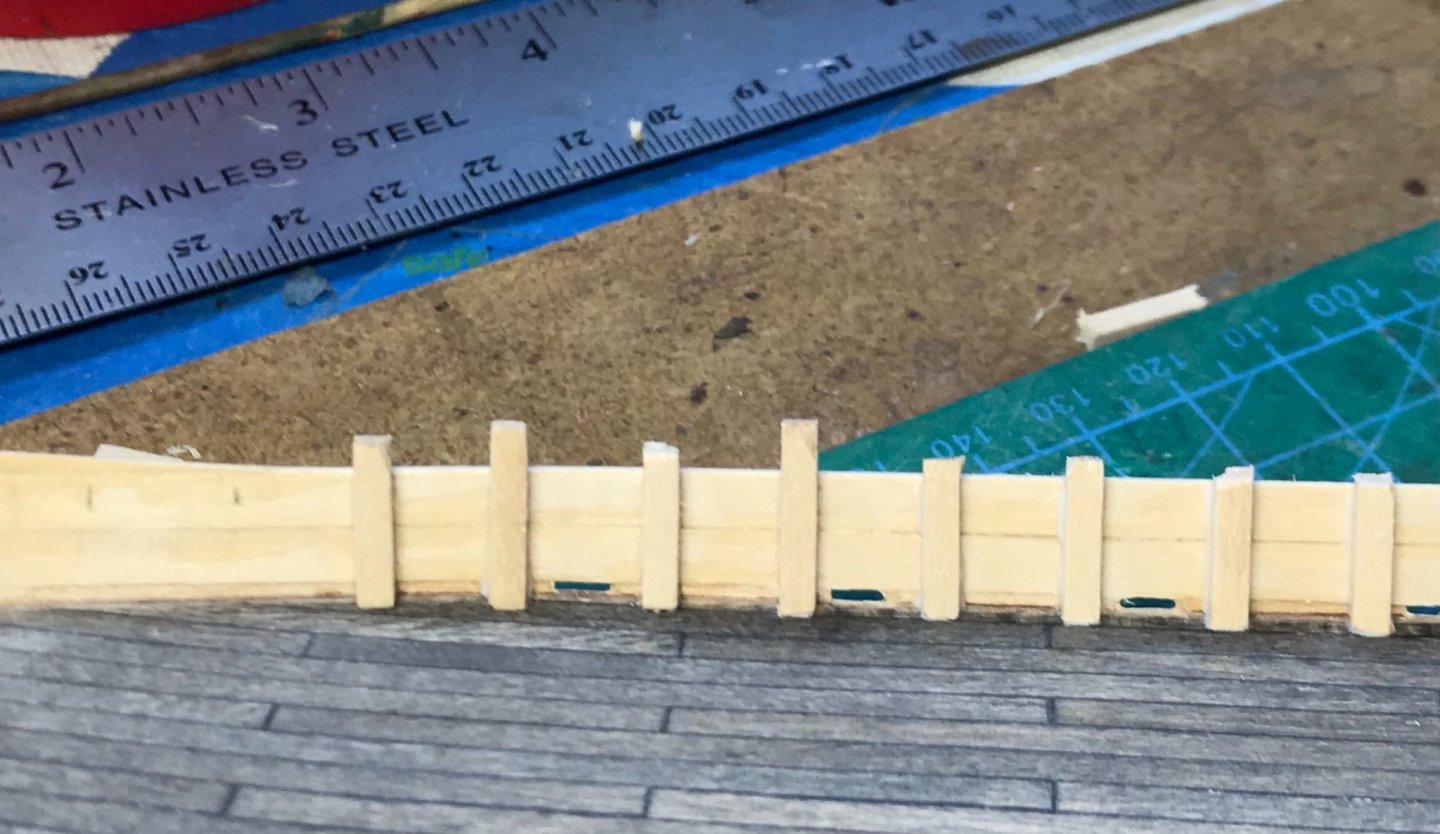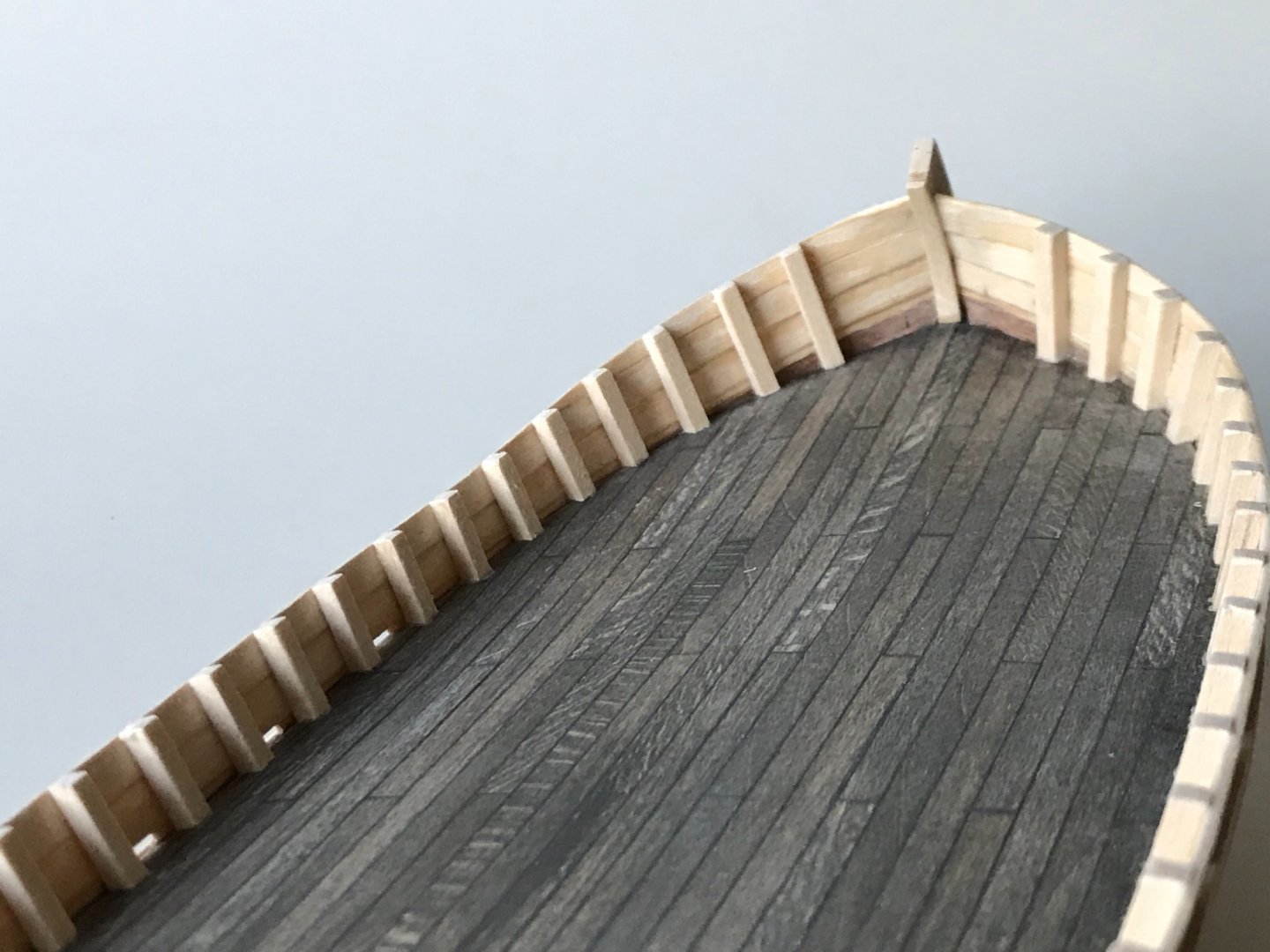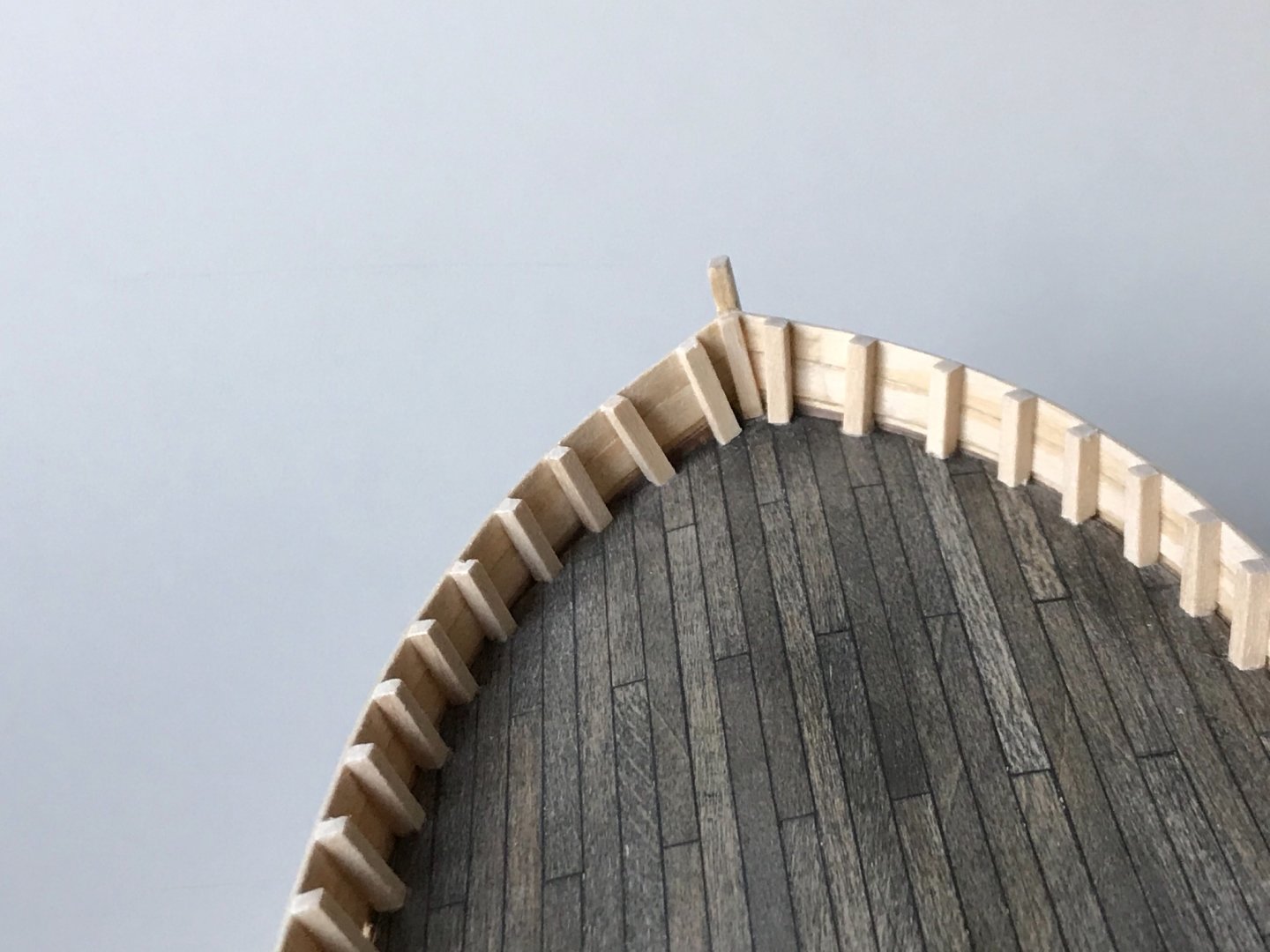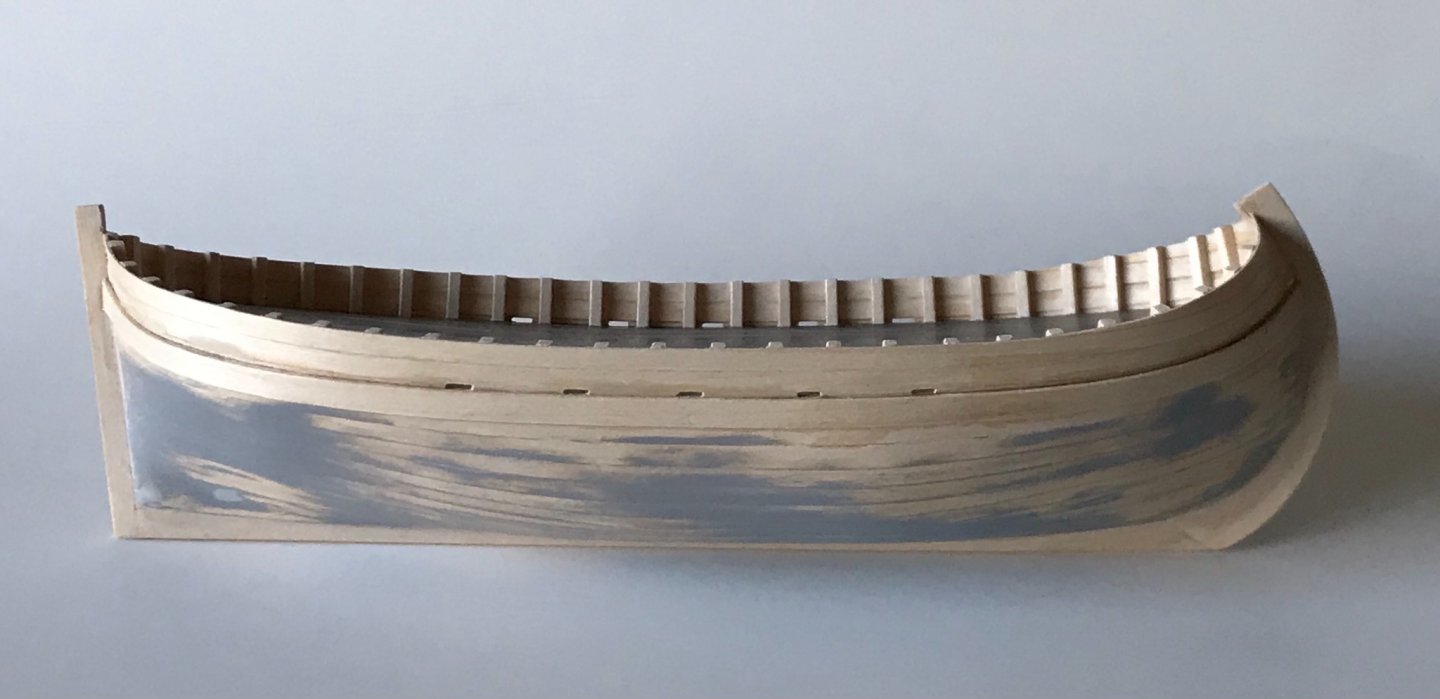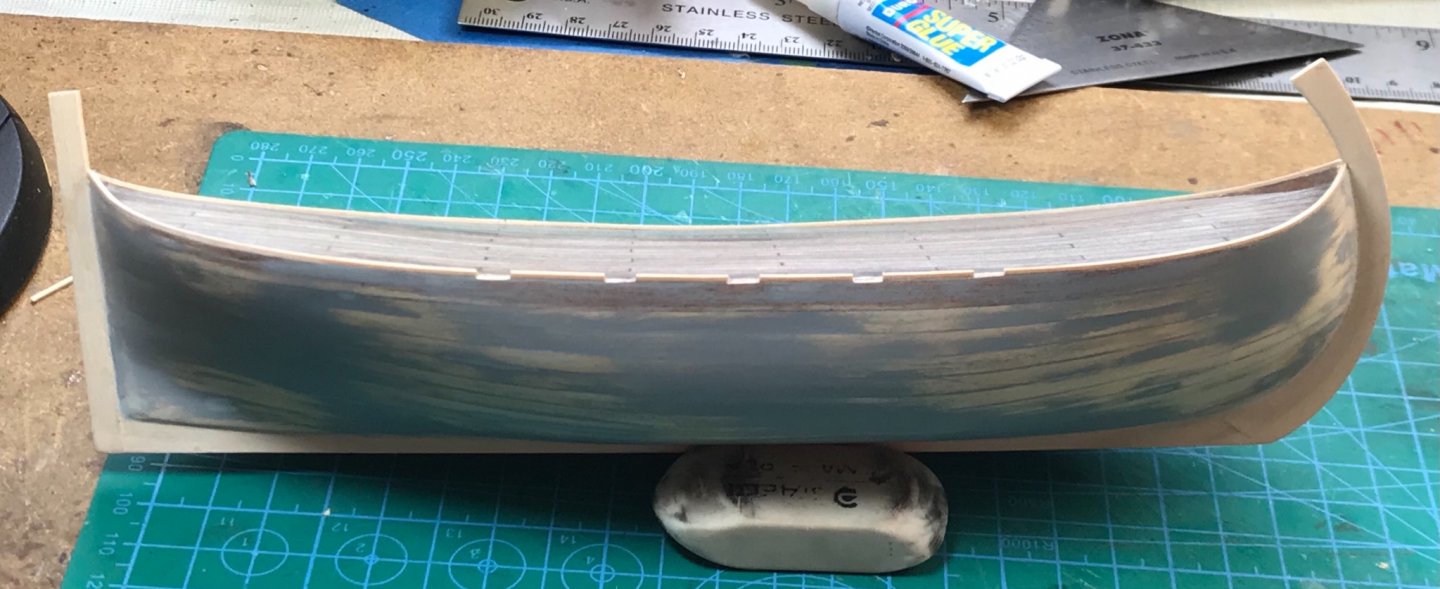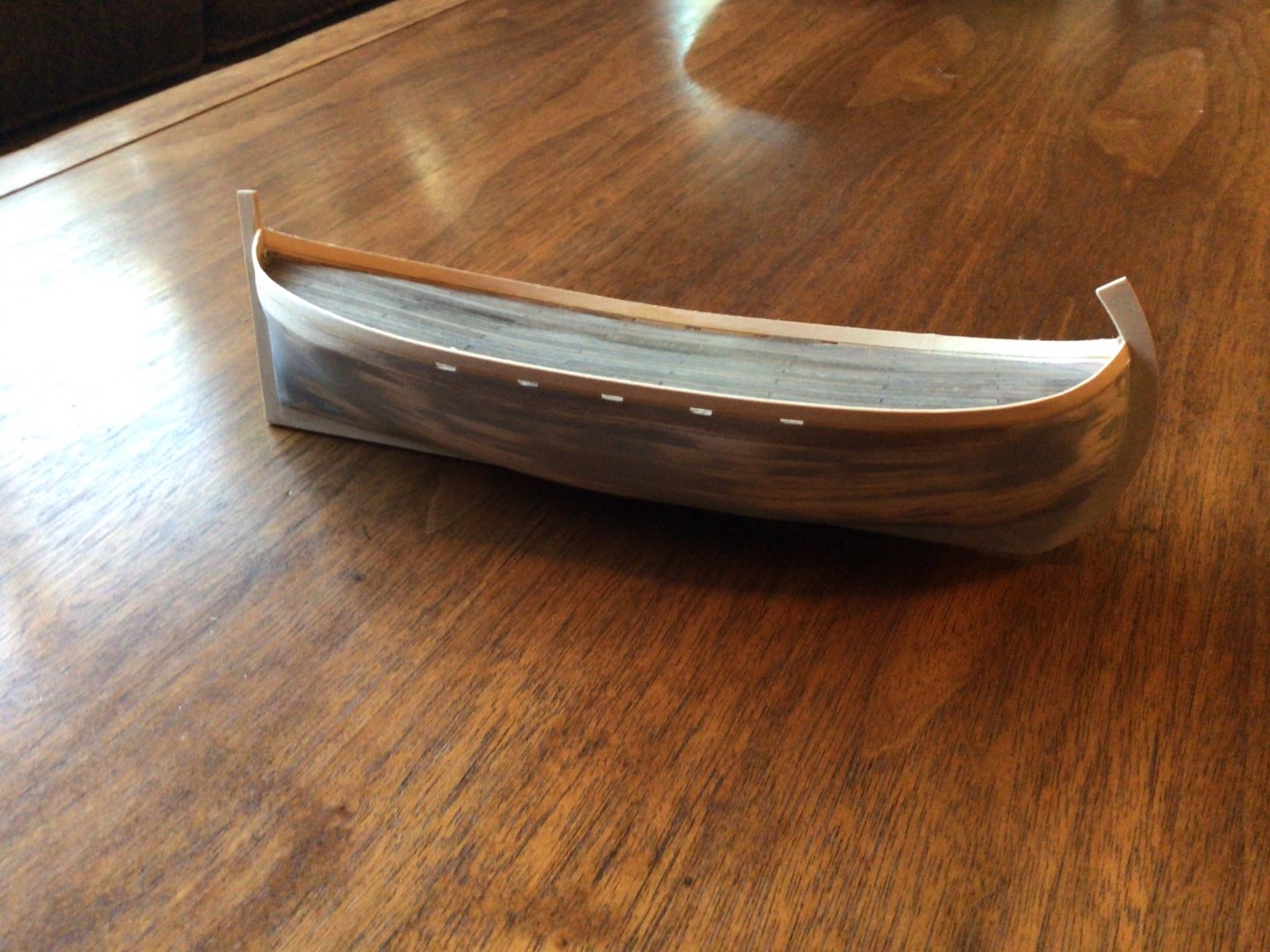-
Posts
465 -
Joined
-
Last visited
Content Type
Profiles
Forums
Gallery
Events
Everything posted by Gbmodeler
-
Installing the false frames was the next order of business. I used 1/32" thick basswood sheet cut into 1.5mm strips. The 1/32" thickness is a little skimpy, compared to the real frames, but thicker wood is harder to bend. I made this compromise, and the results appeared passable to me. I created a jig from a discarded bulkhead, reshaping it to the curvature I wanted for the frames... The basswood strips were soaked in water for a few minutes to soften the wood. Then the clamps held the jig and the strip so I could use a steam iron to form the curve... The steam from the iron really softened the wood, and made it very pliable! The steam travels far, and it would be easy to get a nasty burn. I used a hemostat to hold the wood and keep my body parts safe! The resulting curve allowed me to form frames that conformed to the curvature of the hull. The curve wasn't an exact fit, but it was made "tighter" than the curve of the hull. During the gluing process (CA glue), the frame could be flattened to conform to the curve of the hull as needed... First futtocks (so to speak) installed... Second futtocks installed. I didn't bother with lower futtocks because they would be covered by floor planking... The last step was to trim up the ends of the upper frames. A shelf running parallel to the planking will be installed on top of the frames. Then more false frames will be placed above the shelf (a very short distance!) up to the rail cap (yet to be installed).
- 69 replies
-
- Galway hooker
- fishing
-
(and 2 more)
Tagged with:
-
Thanks Jim Lad and druxey! Druxey, I think I envy the hull in your profile picture...
- 69 replies
-
- Galway hooker
- fishing
-
(and 2 more)
Tagged with:
-
So, the next part of construction had me worried the most. That was removing the interior bulk heads (which is really destruction, not construction). Damaging the hull after expending all that time, effort, and materiel, was a major fear. Removing the bulk head frame started with clipping the cross-braces with wire (sprue) cutters. For every action, there is an equal and opposite reaction, and the violence rendered by crunching the wood braces between the bulkheads was a legitimate concern. Fortunately, all went very well! With the braces clipped, all the bulkhead fell away with a little twist. In fact, one fell out without any encouragement. Since the bulkheads were only attached at one small spot along the keel, the beeswax impregnated edges must have worked. There was little or no glue stuck to the bulkheads. Earlier, I did not fully explain the process I used for applying the beeswax. Before attaching the bulkheads to the keel, I rubbed the wax into the edges (except for the one small spot that would attach to the keel). Then, one at a time, I heated the edges of each bulkhead with a blow dryer to melt the wax into the wood. This requires using tongs or tweezers to not burn your fingers. Another coating of "cold" wax was applied after the bulkheads were attached and braced, just before planking begun. After light sanding... and a strip of basswood for a keelson was applied.
- 69 replies
-
- Galway hooker
- fishing
-
(and 2 more)
Tagged with:
-
The planking has begun. Planking is not my strong suit, and hope I will improve as I gain more experience. All the wood in my model, so far, is basswood. The planking is 1/32" (0.8mm) thick basswood sheet cut to about 4mm (5/32") wide. The outer edges of the bulkheads have been coated with beeswax to prevent the planks from sticking to them as they are glued on with CA glue. The bulkheads give shape and support during planking, but will be removed later to create an "open" hull. Therefore, each plank is only glued to the previous plank. This makes it very important that the garboard strake and upper wale are positioned very accurately. Planking goes down from the wale, and up from the garboard strake until they meet in the middle.
- 69 replies
-
- Galway hooker
- fishing
-
(and 2 more)
Tagged with:
-
Thanks for all the information, Bob Cleek. Lots of good stuff there. Have you seen the "Traditional Boats of Ireland Project" web page. Lots of info there too. http://tradboats.ie/index.php
- 69 replies
-
- Galway hooker
- fishing
-
(and 2 more)
Tagged with:
-
Started a new project: a "Galway Hooker." Evidently, these boats have been numerous in Ireland since the early 19th century, and are still being built today. In the past they were working boats, used for fishing and transporting cargo along the coasts of western Ireland. Today's boats are mostly used for pleasure and racing. The hookers range in size from around 20 to 44 feet (6 to 14 meters), and are broken into four classes, based on size or rigging. There are a lot of information on the internet about Galway Hookers, including plans, drawings, and photos. My model will be a fictional 26-foot (8-meter) boat from the late 19th century of the "gléoiteog" class. Gléoiteogs appear to have been the "real workhorses" of the era because their smaller size made them more affordable (Smylie, Mike. Traditional Fishing Boats of Britain & Ireland. Kindle ed., Amberley Publishing, 2012). Gléoiteogs generally appear to be "open" boats (i.e. no deck), although they sometimes appear with short partial decks (more like shelves) fore and/or aft. Even the larger classes only had half-decks, from the mast forward. I plan to have a short fore deck. The big construction challenge for me will be making a boat that is mostly "open." In 1/48 scale, that is only about 6.5 inches (165mm) long. Model construction began with the keel, made from 1/16 inch (1.6mm) basswood sheet. I added notches for placement of bulkheads later. The bulkheads were sawn from thin (2mm?) basswood plywood and attached in the notches with CA glue. Braces between the bulkheads were added later. Everything was aligned by the "eyeball" method, which relies on a lot of luck...
- 69 replies
-
- Galway hooker
- fishing
-
(and 2 more)
Tagged with:
-
With the completion of the oars and the stand, we're all done! More photos on the completed scratch-built page...
- 55 replies
-
- fishing boat
- Fishing
- (and 4 more)
-
- 55 replies
-
- fishing boat
- Fishing
- (and 4 more)
-
Constructing and adding the sails: I like using "graphic layout marker" paper for sails on my boats. It is translucent, thin, and takes paint and dry pigments well. For this model, I started by making 15mm wide strips for sail panels (that would be about 28 inches (720mm) wide in scale). I overlap the panels about 1.5mm and glue them with diluted white glue using a small brush. Excess glue is removed by dabbing and/or rolling (not rubbing) with a cotton swab. Rubbing can raise the paper fibers and leave unsightly rough spots, or even holes in the paper. I have had some success with embedding thin copper or steel wire in the trim. This allows me to billow the sails later. For latine sails, I put the wire on two sides, but not along the side that attached to the spar (it's not needed). Experimenting with dry powder pigments, you can get various effects. Here is a comparison of yellow ochre and burnt umber. For this model, I liked mixing the two colors and diluting them with talcum powder. It may not look great, but it smells wonderful! The pigments are applied and blended with a make-up brush... Getting close to being done!
- 55 replies
-
- fishing boat
- Fishing
- (and 4 more)
-
It's been a while since I last posted, but progress has been made. This update shows the addition of the bow ornament, rudder, tiller, forcolas (oar locks), masts, standing rigging, and the painted (and lightly weathered) hull. The rest of the rigging, spars, and sails remain to be added. I decided to carve a "ram's horn" style bow ornament; made from a wooden bead. The large rudder was typical of these boats. The forcolas are carved from basswood sheet.
- 55 replies
-
- fishing boat
- Fishing
- (and 4 more)
-
Thanks Thanasis! The hardware is made from heavy construction paper (black color). After gluing the strips of paper to the wood, small holes are drilled with a pin vise for the bolts. I use copper wire for the bolts/rivets. The actual hinges are plastic (styrene) rod, cut into short pieces and glued with CA to the wood/paper, with short gaps between them.
- 55 replies
-
- fishing boat
- Fishing
- (and 4 more)
-
I haven't posted in a few days while working on deck houses and fittings. All are scratch-built and the main ingredients are basswood, pear veneer, bamboo, various papers, copper or steel wire, and CA and PA glue. The last photo shows the planned placement on the deck. Hope to start painting next!
- 55 replies
-
- fishing boat
- Fishing
- (and 4 more)
-
Here's an update on construction progress: After studying many photos and drawings of the "eyes" and reading an article that mentioned the general placement of them, I decided I had them too far apart (too wide). Fortunately, a little water softened the PA glue, and I was able to reposition them. Also been adding little bits and pieces, and planning where to step the masts and deck house arrangements. Stay tuned...
- 55 replies
-
- fishing boat
- Fishing
- (and 4 more)
-
I really like the pipe cleaner idea, and may use it! I have to experiment a little... Thanks Thanasis!
- 55 replies
-
- fishing boat
- Fishing
- (and 4 more)
-
Thanasis, I never thanked you for your insights on the frames and "trincarino". Too late to do anything about the frame. I did plan to install a trincarino (although I did not know that is what it is called), but was going to use paint to represent it... Also, I have been intrigued by the curly hair stem post. What's your idea???
- 55 replies
-
- fishing boat
- Fishing
- (and 4 more)
-
Thanks for all the information Wefalck and Thanasis! It is very much appreciated! Lots to study and consider.
- 55 replies
-
- fishing boat
- Fishing
- (and 4 more)
-
Since basswood can be so delicate and crumbles easily, especially in carving situations, the rough cut-out piece was coated in very thin (viscous) CA (super) glue. This can be a very dangerous operation, especially while handling such a small piece. The superglue spreads wildly and gets on fingers easily. One has to be extremely careful! I imagine, if our models survive through the millennia, future archeologists will wonder why modelers in our age incorporated bits of skin, and in some cases whole fingers, into our model building! Perhaps by then, they can clone me back to life from one of my models, and ask me.... After impregnating the wood with CA, carving could be much more robust. I also wanted to add some 3-dimensional attributes to the eyes, so I scribed a semi-circle along the round edge to have a line from which to carve down the rest of the eye. This left an "eyeball" effect. Pupils were drilled out by hand using drill bits, and the final smoothing applied...
- 55 replies
-
- fishing boat
- Fishing
- (and 4 more)
-
The adding of details (the building of deck houses, winches, etc.) is one of my favorite activities. A notable feature of the Brazzera and other Adriatic boats are the "eyes." I understand they are very important, since a boat without eyes can not see where it is going. This is new to me and looked like a fun project. Since I mainly only have basswood to work with, I started there. The general outline of an eye was drawn freehand with pencil on a 1/8" (3.175mm) sheet of basswood and cut out: Next, using a hobby knife and a homemade sanding block, the general shape of the piece was reached.
- 55 replies
-
- fishing boat
- Fishing
- (and 4 more)
-
Finished up the thick railings that these stout little boats displayed, and for me, I think, the hardest part of the hull is finished. It took a lot of wood bending to get the bow done, but I really like the results. I used Chuck Passaro's planking method and I love it! (https://modelshipworld.com/topic/22975-chuck-passaros-planking-videos-where-are-they/?tab=comments#comment-679771). Wish I had seen it before planking the lower part of the hull... . I see these boats had "crowns" on the top of the stempost, and am undecided what to place there. Anybody have any thoughts about what was "typical"? Hard part done. Now for the detailing fun!!! A 90 degree bend on the bow... Bow. The rails were done in strips... Stern... I added some length to the sternpost... Pear wood veneer was used for the interior rail sides... Bow shot... Stern shot.
- 55 replies
-
- fishing boat
- Fishing
- (and 4 more)
-
Thanks Thanasis! I do plan to add a couple of frames (ribs) at the bow, with what appears to be a horizontal brace (is that the trincarino?). I think there is a similar feature aft? I have been debating whether to attempt the curved "notches" at the bow that some boats have, before I add those features. Also, the stem and stern posts are not finished off yet, but I agree with your observation. Thanks!
- 55 replies
-
- fishing boat
- Fishing
- (and 4 more)
-
With the upper bulwarks planked, I started adding the false ribs, using 3/32 inch (2.4mm) basswood strips. Also added a thickened main-wale plank along the outer sides, at deck line, just below the scuppers.
- 55 replies
-
- fishing boat
- Fishing
- (and 4 more)
-
Thanks Bob! It is a little different profile. I think that helped attract me to trying to build it...
- 55 replies
-
- fishing boat
- Fishing
- (and 4 more)
-
This one has been a tough one to plank. Mainly because of my inexperience and poor planking skills. It has driven me to study-up on the subject, and I'm almost anxious to start another project so I can apply what I've been learning... Anyway, The Brazzera has been planked, filled, sanded, primed, and sanded again - from the deck line, down. I sawed off the plywood keel, stem post, and stern post and replaced them with nicer looking basswood. The stem post is probably too large, and I'm thinking I'll sand it down after planking above the deck... First strake above the deck was a 1/32 strip, upon which to build scuppers! You can see the result here. After cutting out the holes, the first strake above the scuppers was added.
- 55 replies
-
- fishing boat
- Fishing
- (and 4 more)
About us
Modelshipworld - Advancing Ship Modeling through Research
SSL Secured
Your security is important for us so this Website is SSL-Secured
NRG Mailing Address
Nautical Research Guild
237 South Lincoln Street
Westmont IL, 60559-1917
Model Ship World ® and the MSW logo are Registered Trademarks, and belong to the Nautical Research Guild (United States Patent and Trademark Office: No. 6,929,264 & No. 6,929,274, registered Dec. 20, 2022)
Helpful Links
About the NRG
If you enjoy building ship models that are historically accurate as well as beautiful, then The Nautical Research Guild (NRG) is just right for you.
The Guild is a non-profit educational organization whose mission is to “Advance Ship Modeling Through Research”. We provide support to our members in their efforts to raise the quality of their model ships.
The Nautical Research Guild has published our world-renowned quarterly magazine, The Nautical Research Journal, since 1955. The pages of the Journal are full of articles by accomplished ship modelers who show you how they create those exquisite details on their models, and by maritime historians who show you the correct details to build. The Journal is available in both print and digital editions. Go to the NRG web site (www.thenrg.org) to download a complimentary digital copy of the Journal. The NRG also publishes plan sets, books and compilations of back issues of the Journal and the former Ships in Scale and Model Ship Builder magazines.

